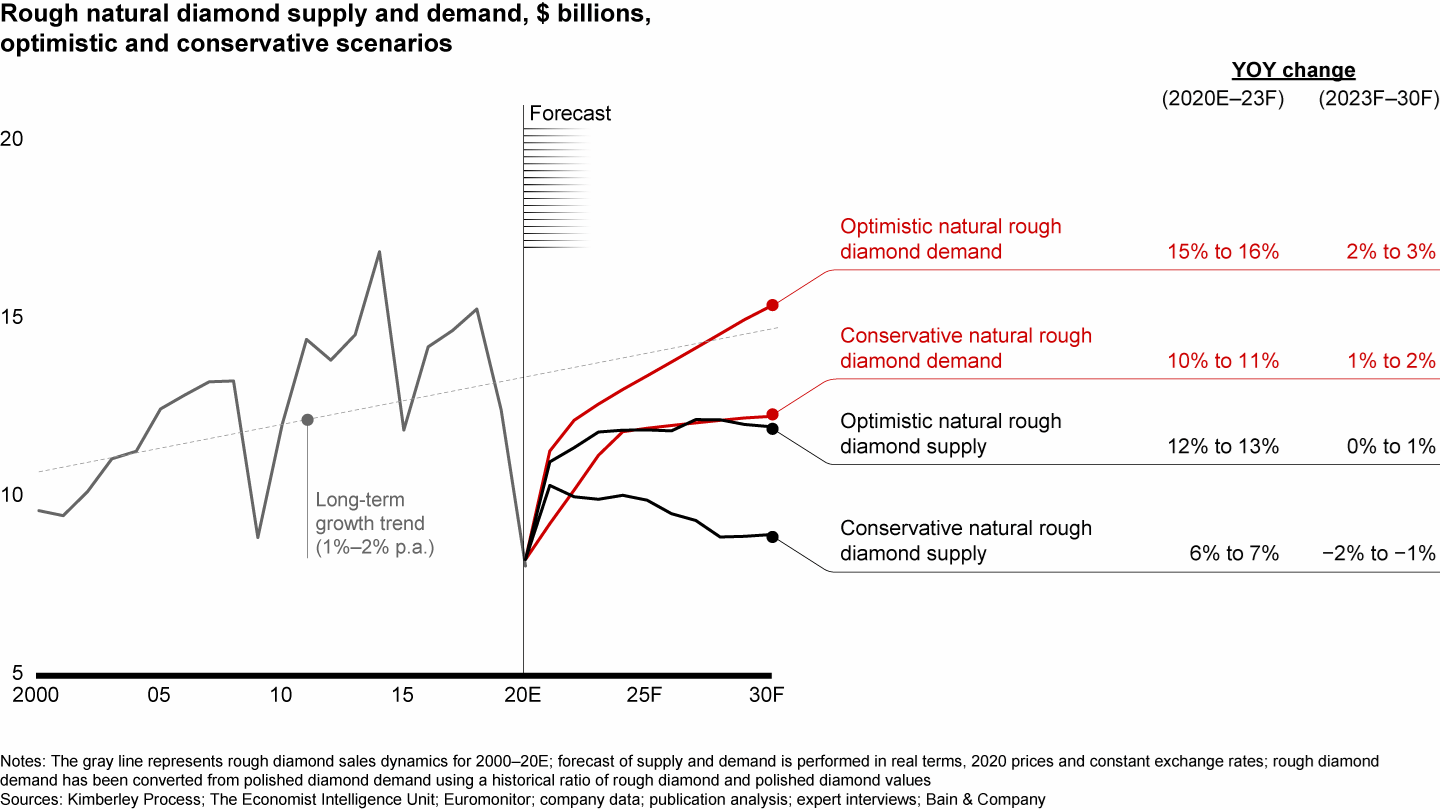Report

Welcome to the tenth annual report on the global diamond industry, prepared by the Antwerp World Diamond Centre (AWDC) and Bain & Company. This year’s edition covers industry performance in 2019 and the effects of the Covid-19 pandemic in 2020, and provides an update on consumer preferences and attitudes. We also assess potential recovery scenarios in 2021 and beyond.
The report begins with key developments along the value chain, including industry trends that were accentuated or accelerated by the global pandemic. We review factors that influenced rough diamond production and sales, midstream performance, and global diamond jewelry demand in major markets.
We updated our long-term outlook for the diamond industry through 2030. The 2030 supply–demand forecast considers announced production plans, recent changes in mining operations, potential additional sources of supply, expected changes in global and regional macroeconomic parameters, and potential impacts from lab-grown diamonds.
A summary of the key points:
- The diamond industry suffered during the Covid-19 crisis but fared better than the personal luxury market overall. Across the value chain, revenues decreased by 15% to 33%. Operating margins followed, with a decline of 1 percentage point to 22 percentage points. Despite the significant drops, the $64 billion diamond jewelry retail market performed better than the personal luxury market, which contracted by 22% at current exchange rates in US dollars.
- Rough diamond production continued its downward trend, falling to 111 million carats. After peaking at 152 million carats in 2017, rough diamond production has declined by about 5% per year. In 2020, production decreased by 20% compared with 2019 levels. Notwithstanding changes, the mix of diamonds remained largely constant, with medium and large diamonds accounting for 25% of production volume in carats but around 70% to 80% in value in US dollars.
- The mining response at the start of the Covid-19 crisis helped midstream players weather the worst of the storm. Major miners canceled sales in the first half of 2020 and allowed clients to postpone purchases. Upstream inventories of rough diamonds grew to 65 million carats by the end of the third quarter, before decreasing on the strength of fourth-quarter sales to 52 million carats (+17% than the inventory level at the end of 2019).
- Despite challenges in 2019, midstream players finished the year on a strong note. The midstream started 2020 with 9% less inventory, healthier financial balance sheets, and a more consolidated market structure. In 2020, midstream players cleared existing stockpiles even further and reduced inventories by 22%.
- The midstream segment lowered its debt by half compared with its peak level in 2013; debt levels decreased to $8 billion in 2020. Financing decreased because of lower trading levels and a higher reliance on self-financing. Larger midstream companies with transparent operations continued to access financing from big banks, while alternative financing options (peer-to-peer financing) emerged for smaller players. Large midstream companies, banks in the Middle East, and specialized funds were made available to provide additional financing in the sector. Deleveraging is expected to speed up restructuring and consolidation of the midstream and to create long-term benefits across the pipeline.
- Prices for rough and polished diamonds continued to feel pressure. Rough and polished diamond prices began trending downward in 2018, then decreased in 2019 by 7% and 4%, respectively, as a result of over-stocking in the midstream. In 2020, rough and polished prices fell by 11% and 3%, respectively. Divergence between rough and polished price dynamics helped midstream players post record-high operating margins in 2020. Higher-quality diamonds recovered faster, ending in positive territory compared with the start of 2020 and recovering most of their price drop from the past two years.
- Lockdowns, travel restrictions and economic uncertainty contributed to lower diamond jewelry sales. Sales were down 15% in 2020, with most of the decline happening in the first and second quarters. In addition, demand for diamond jewelry became more localized due to travel restrictions. Demand returned during the fourth quarter, culminating in a strong holiday season across the globe. Once fully tallied, we expect 2020 sales to be better than analysts predicted based on the first three quarters. Preliminary estimates show growing consumer confidence and an increase in pre-holiday retail activities.
- Consumers continue to value diamond jewelry as a desirable gift and a key element of marriage. In a customer sentiment survey issued by Bain in 2020, US consumers said jewelry and watches are among the top four gifts they would like to receive; consumers in China and India ranked them in the top two. In the US, China, and India, 60% to 70% of respondents believe diamonds are an essential part of a marriage engagement. After the pandemic, 75% to 80% of consumers said they intend to spend the same amount or more on diamond jewelry than they would have before the crisis. This indicates a strong, ongoing emotional connection with the diamond story.
- Covid-19-related travel restrictions localized jewelry consumption in 2020. The biggest winner was China. Because Chinese consumers had limited opportunities to travel, they turned to local retailers and Hainan duty-free stores for luxury and premium purchases. Major local chains reported double-digit growth in sales in the second half of the year. In addition, major retailers are expanding their retail footprints, particularly into lower-tier cities where the middle class and wealth are growing. The repatriation trend is expected to subside in the long term, once global travel resumes, but new consumers in lower-tier cities will provide continued demand for jewelry and drive further growth in China.
Covid-19 accelerated preexisting trends that have been shaping the diamond industry:
- The diamond value chain is becoming more digital, although brick-and-mortar stores still have value. A digital pipeline for business-to-business (B2B) commerce emerged during the pandemic as several platforms (UNI diamonds, Get-Diamonds, Clara Diamond Solutions) started or expanded trading of rough and polished diamonds. Business-to-consumer e-commerce also grew in 2020, with about 20% of retail sales occurring online. Major diamond jewelry retailers posted up to 60% to 70% year-over-year sales growth in their online channels. Despite the increase in online sales and a strong preference for online research before making purchases, nearly all consumers (90%−95%) still prefer to buy diamonds in brick- and-mortar stores. Consumers value the opportunity to see and touch jewelry, and they benefit from in-person advice and other personal services. The online share of diamond jewelry sales is still low compared with other luxury and consumer products. To create a meaningful shift toward digital channels, the industry needs to address several consumer concerns. It needs to improve trust (by providing diamond certificates, warranties, and reviews), enhance convenience (e.g., implementing free delivery and returns or “try before paying” programs), and provide additional discounts and promotions for online purchases.
- Diamond jewelry marketing needs to evolve to meet new challenges, like generational shifts and increased competition for consumers’ share of wallet. Future marketing campaigns should connect diamonds to additional life moments, expanding the market (and consumers’ emotional connection to diamonds) beyond marriage. The diamond story needs to become more personal and engaging, which marketers can accomplish through storytelling, social media, and customization (e.g., products, offers, and pricing). Retailers need to invest in omnichannel and phygital capabilities to match new purchasing preferences, and manufacturers should promote sustainability practices that consumers care about. Industrywide, marketing efforts need to be reinvented and increased. Despite current efforts, diamond marketing spend is roughly 1% to 2% of industry revenue, which lags the average luxury goods marketing spend of 6% to 8%.
- Continued advances in technology contributed to double-digit growth in production and lower retail prices for lab-grown diamonds in 2019 and 2020. The price differential between natural and lab-grown fancy color diamonds is particularly striking—up to 10 times. In addition to independent lab-grown manufacturers, major fashion jewelry retailers are adding lab-grown diamonds to their product offerings, further positioning the category into the fashion jewelry segment and making it accessible to a wider range of price-sensitive consumers.
- Sustainability, transparency, and social welfare are priority issues for consumers, investors, and the value chain. Social welfare and sustainability were growing issues in previous years. Now they are firmly top-of-mind for mining, trading, and retail companies. In the US, and especially in China and India, younger consumers say sustainability is part of their decision-making process and could influence whether they buy diamond jewelry. Companies across the value chain are responding with a range of initiatives to tackle emissions and water consumption, increase diversity and support for local communities, and improve diamond traceability.
- Covid-19 prompted structural changes in the diamond industry that will help it recover from the recession. Because of the crisis, midstream inventories are at healthy levels and better aligned with consumer demand. There are more partnerships between upstream and midstream players in regard to technology, go-to-market strategies, and marketing. A more transparent and digitally enabled supply chain was created in the rough and polished diamond segments, and we see innovative new approaches to customer engagement. We are optimistic these changes will help the industry exit the crisis in a stronger position.
- 2020 ended with strong sales across the whole value chain. The boost was driven by successful holiday jewelry sales, particularly in the US and Chinese markets, where players reported a 5%–10% and 15%–20% rise in the fourth quarter, respectively, compared with the same period of 2019. The retail sales growth was feeding through to rising demand for polished diamonds. In the fourth quarter of 2020, the cutting and polishing segment accounted for about 20% of the growth of net export of polished diamonds and net import of rough diamonds compared with the same period in 2019. In the last three months of the year, miners managed to release approximately 13 million carats of rough diamond inventories, increase rough prices by 2%–3%, and show 10% sales growth compared with the fourth quarter of 2019.
- 2021 started on a strong trajectory and growing market confidence. Most miners reported 5%–8% rough diamond price and sales improvement in January, while, in addition, major miners kept a flexible sales policy, which all combined set up a good start to the year. If that trajectory continues, we could see faster recovery to a historic growth trajectory than anticipated in our optimistic scenario.
- There is still a lot of economic uncertainty ahead. The current crisis could be more severe than 2009, and a double-dip recession is possible. Full recovery and a return to a historic growth trajectory isn’t expected until 2022 to 2024. Three factors will impact the pace and shape of the recovery: epidemiology, government policy response, and consumer response.
- Encouraged by the year-end performance, the long-term outlook for the diamond market remains positive. In volume terms, rough diamond supply growth is projected to be −2% or 2% annually at best. Following accelerated short-term recovery growth, demand for rough diamonds is expected to fall back into its historic trajectory, growing at 1% to 3% annually. Demand dynamics will match the trends in GDP and disposable income growth for affluent and high-net-worth individuals globally. Expanded retail jewelry footprints into lower-tier cities across key emerging economies will also support demand growth. Generation Z will be both a growth engine and a change agent for the industry, with its evolving preferences, purchasing behaviors, and sustainability agenda.

1. Recent developments in the diamond industry
- After a robust performance in 2018, 2019 was a challenging year for the diamond industry. Rough diamond production was about 20% higher in 2017 to 2019 compared with 2016. However, increased production did not translate into demand growth for diamond jewelry. Performance was tempered by rising trade barriers, mainly between the US and China; political instability in key trading locations like Hong Kong; and deteriorating customer sentiment across key regions. Toward the end of 2019, performance improved, and the market expected a recovery in 2020.
- Then the Covid-19 pandemic hit the entire value chain. In the first half of 2020, lockdowns in major world cities and an economic downturn caused a 15% reduction in diamond retail. Upstream and midstream players also suffered from operational disruptions, including mine closures, restrictions on cross-border goods movements, and canceled sale events.
- Because of the crisis, major mining companies adopted a price-over-volume strategy and took steps to support the midstream segment. They reduced production by 20% and allowed customers to postpone purchases. In the third quarter, when the demand was back, major miners lowered rough diamond prices by 10%. As a result, mining revenues decreased by 33% and inventory increased by 17%. Cutting and polishing companies saw revenues drop by 25%. Polished prices decreased by only 3%. Midstream inventory decreased to prerecession levels, which are better aligned with production profiles and which curtailed the need for financing. These changes redistributed the profit pool along the diamond value chain. Mining profit margins decreased about 22 percentage points, retail margins declined 1–3 percentage points, and midstream margins increased 5 percentage points.
- The pandemic accelerated structural changes in the diamond industry. E-commerce adoption increased in the retail sector and expanded into B2B trading for rough and polished diamonds. The divergence between lower- and higher-quality diamonds deepened, with prices and volumes for high-quality diamonds recovering faster and stronger.
- There is strong evidence of a revival in the last quarter of 2020, but full recovery is not expected until 2022 to 2024. Even after the consequences of the pandemic are fully mitigated, industry players must continue to restructure their business models to align with long-term trends and operational realities. The industry needs to embrace digital technologies, explore new marketing concepts, and engage consumers differently to capitalize on long-term growth prospects.
Revenues across the value chain trended downward in 2019 and 2020

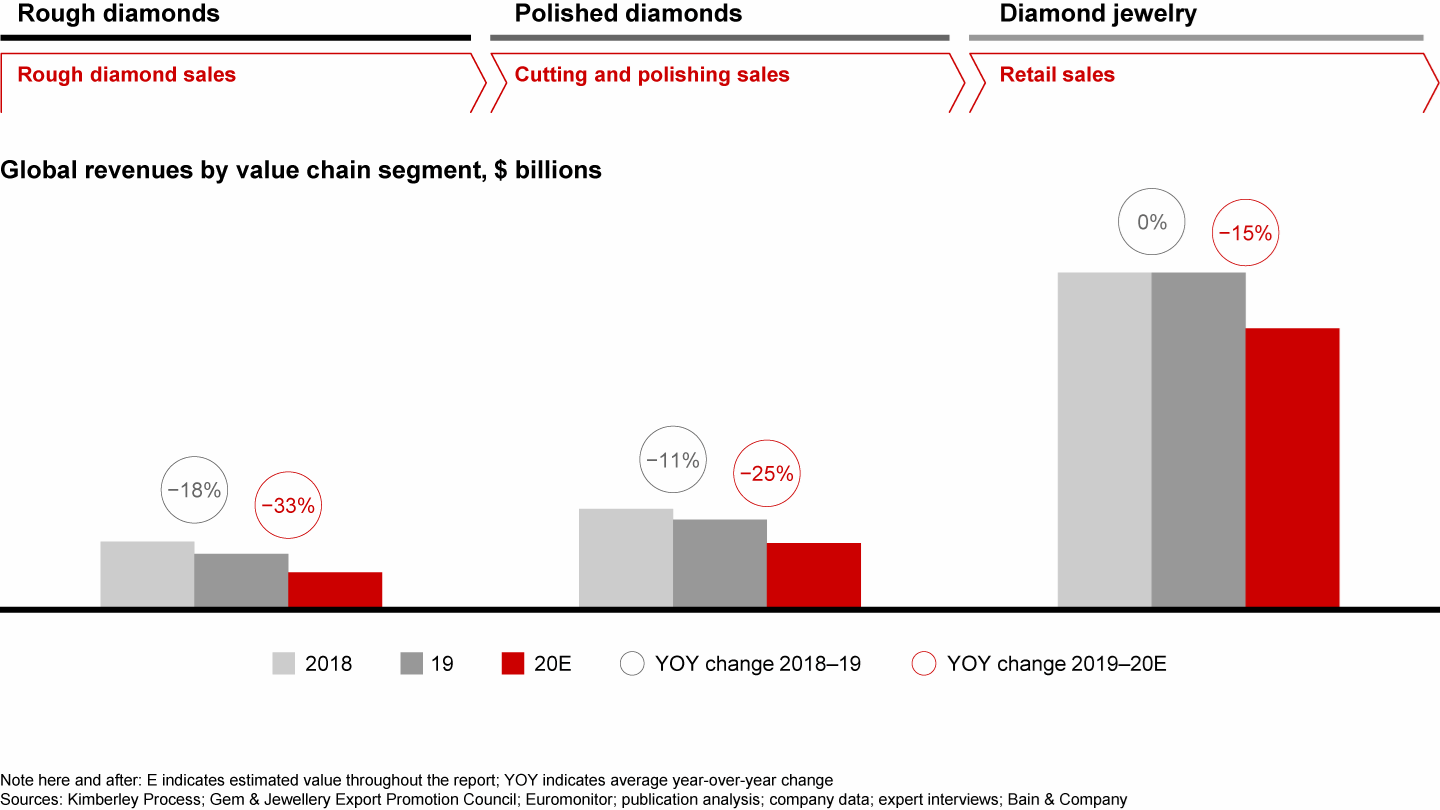
Covid-19 had major implications across the value chain, but repositioned the industry for long-term growth

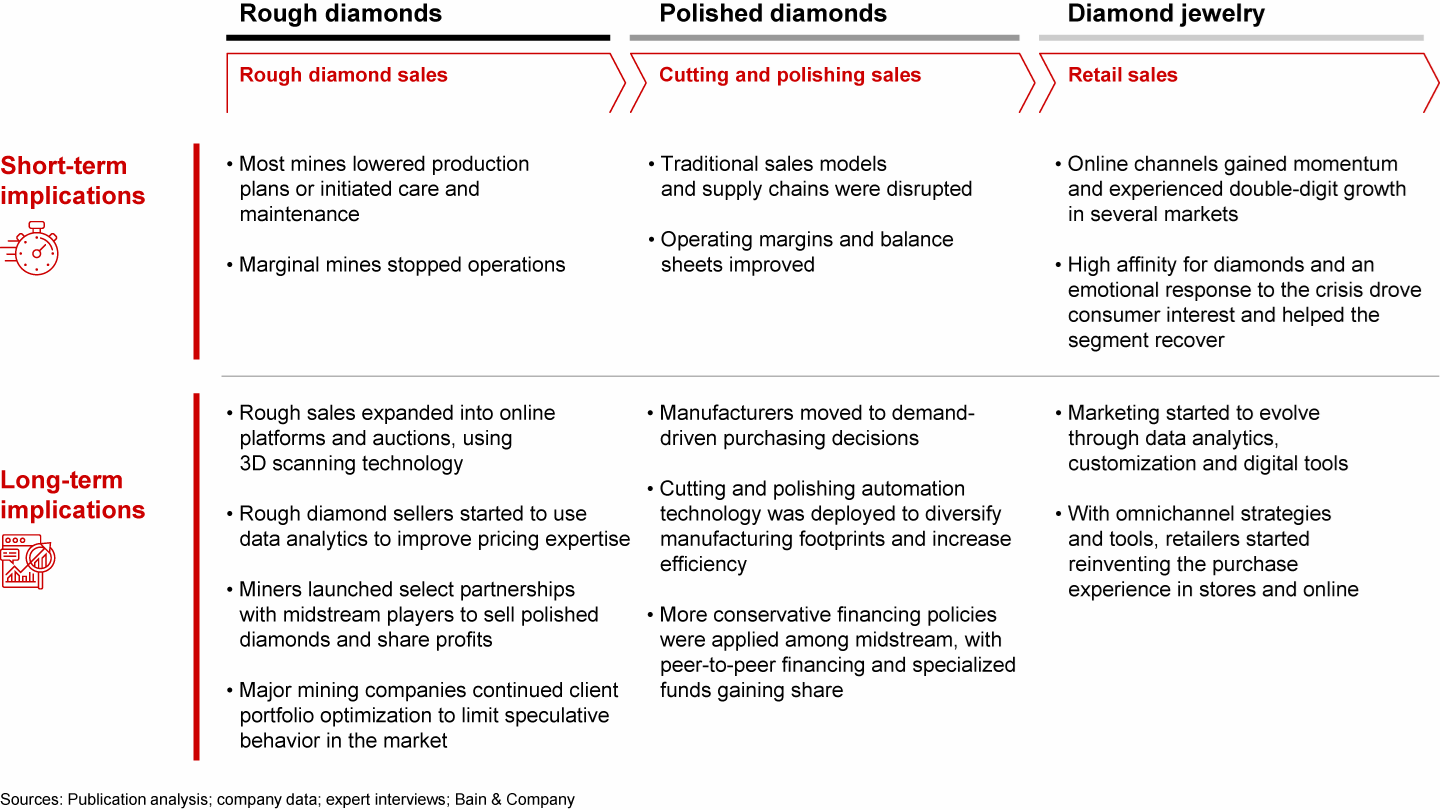
Profit margins were devastated across the value chain, except in the C&P segment

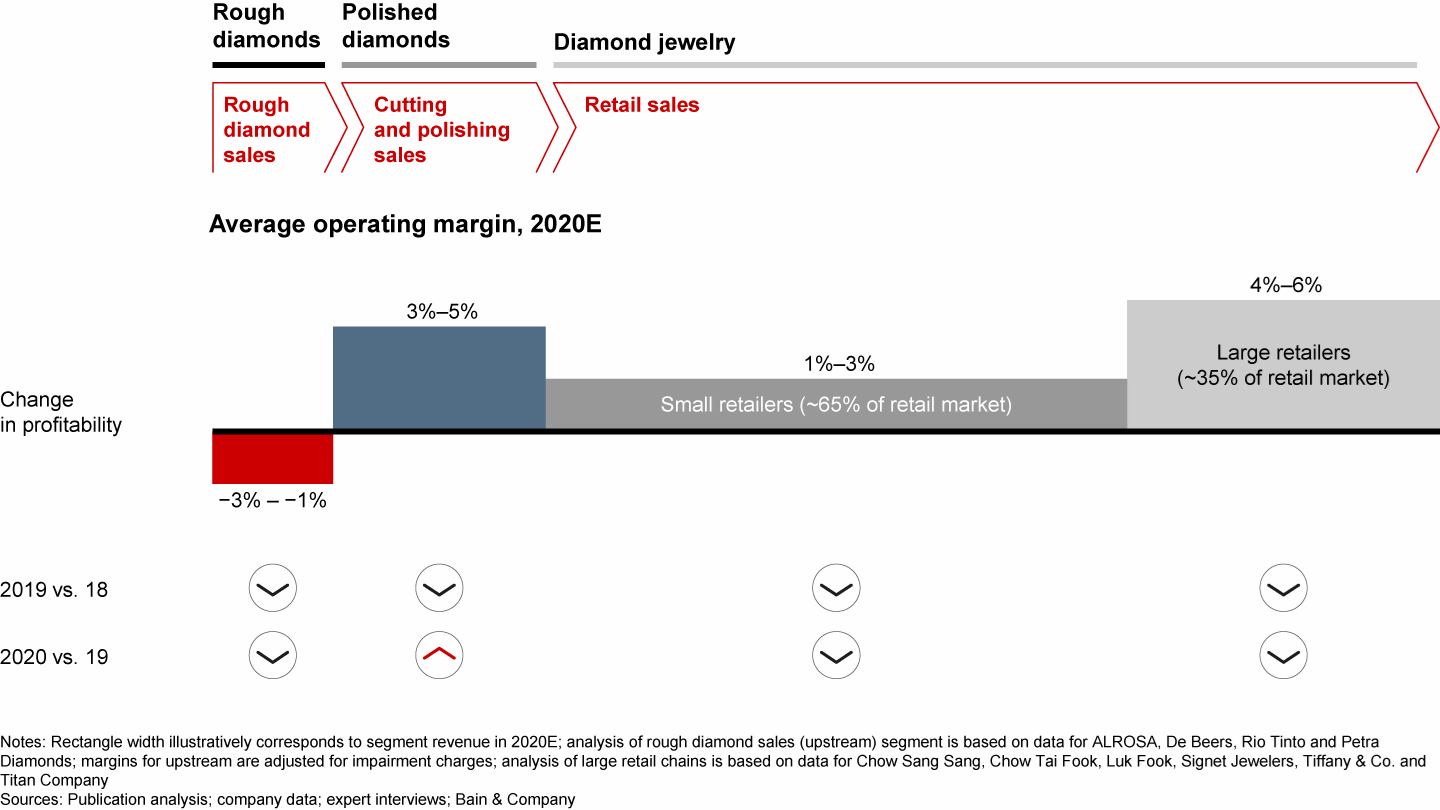
Impacts of Covid-19 caused rough diamond sales to decline –33%

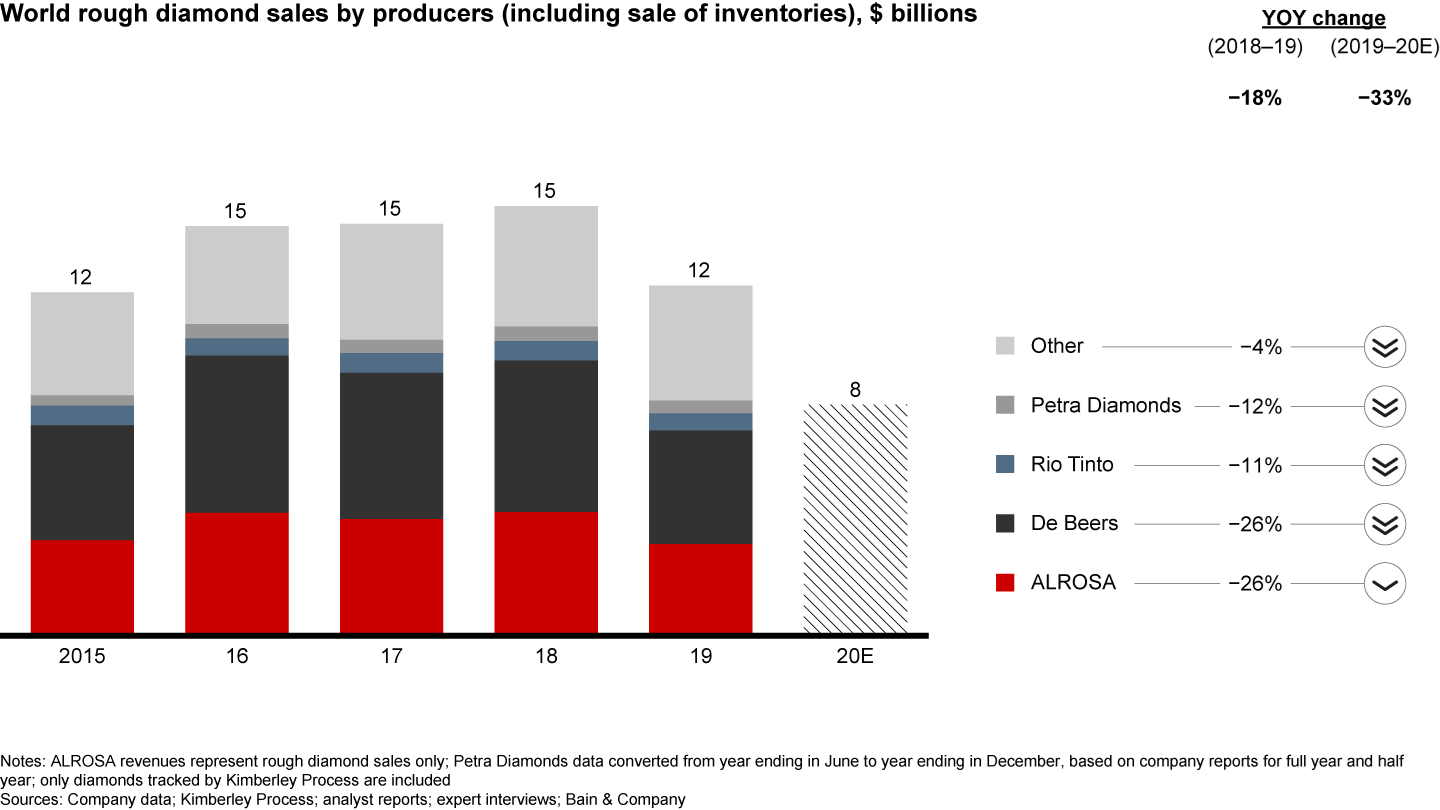
In 2020, upstream inventories increased by ~17%, mostly driven by supply chain disruptions

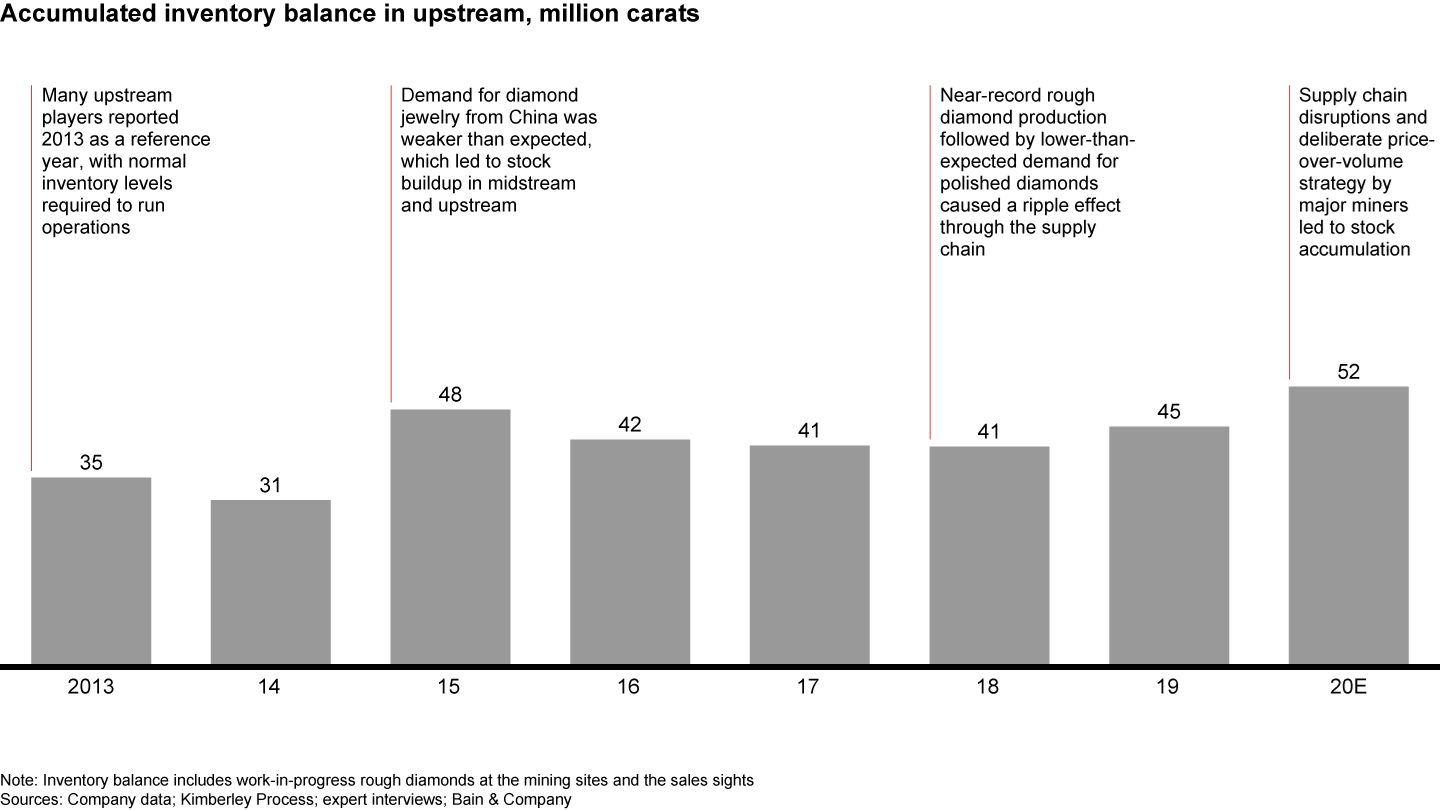
A slower decline of polished diamond prices vs. rough diamond prices supported stronger margins for the midstream

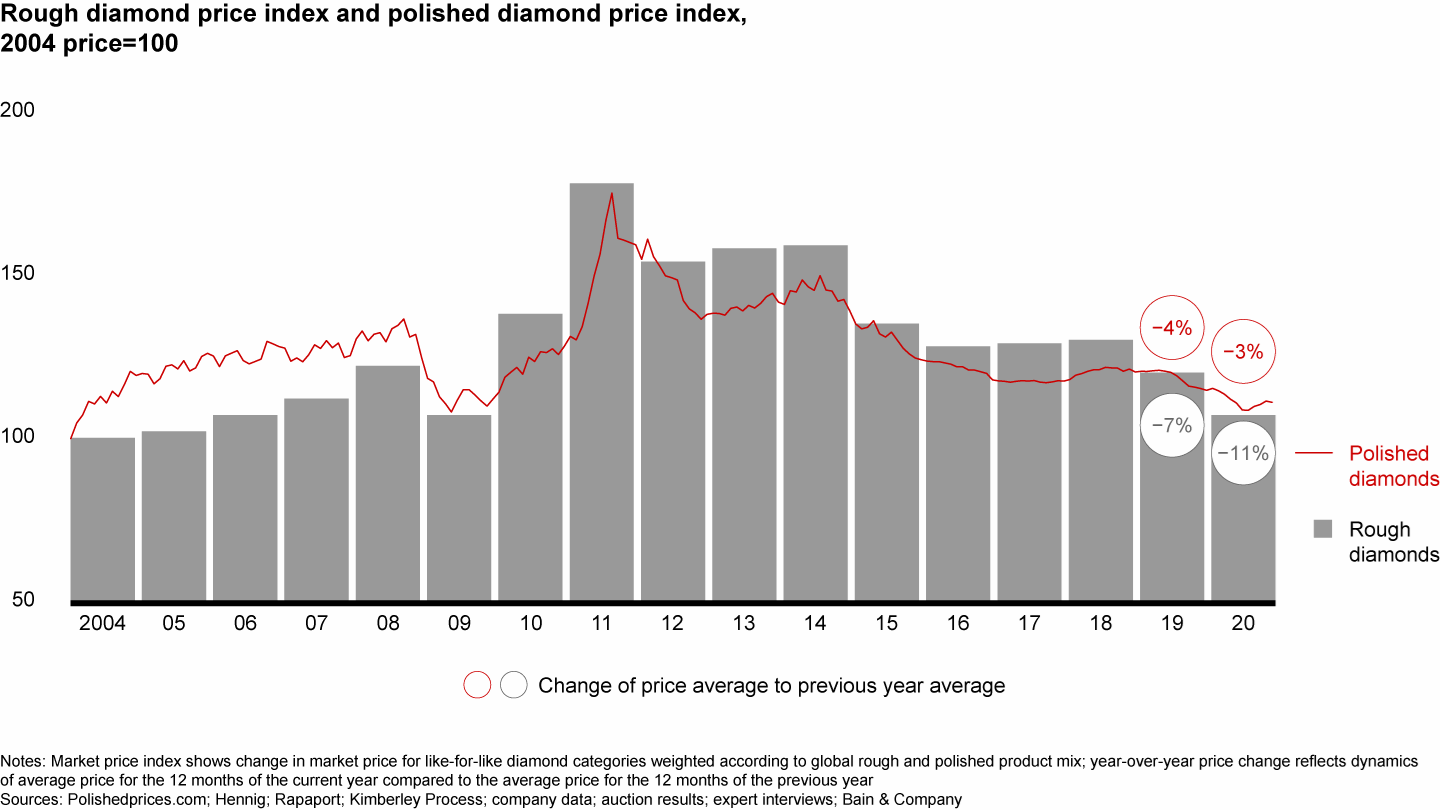
Prices for higher-quality polished diamonds have outperformed lower-quality diamonds over the past two years

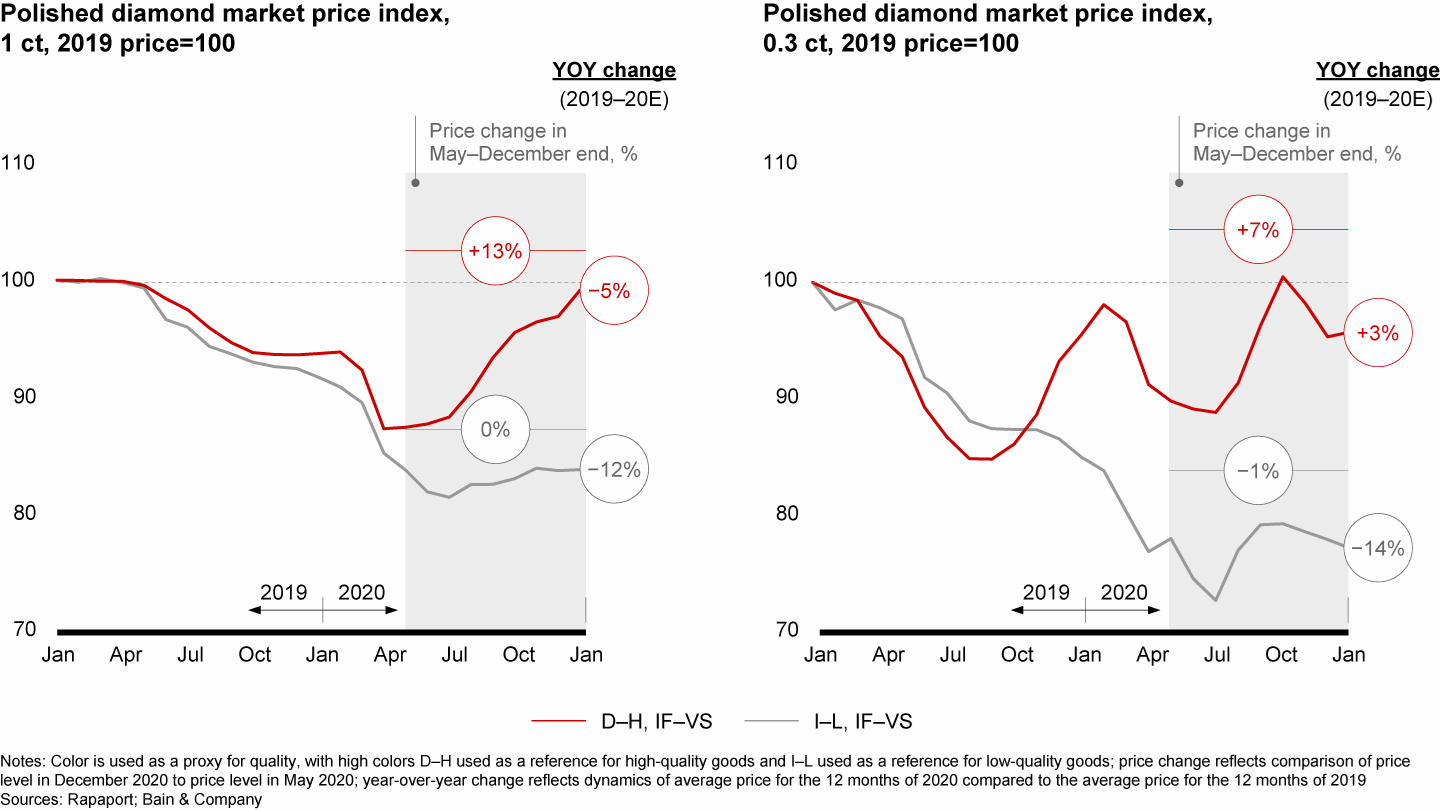

2. Rough diamond production
- Following peak levels in 2017 and 2018, rough diamond production declined by 5% in 2019, hitting 139 million carats (+10% over 2016). Rough diamond sales decreased 18%, reflecting both volume and price changes, and leading to a 10% increase in mining company inventories. Toward the end of 2019, the market was improving significantly. Strong holiday demand positioned the industry for a better 2020.
- Then the Covid-19 pandemic severely disrupted mining operations and logistics, causing mine closures and restricting cross-border movements. Major mining companies adopted a price-over-volume strategy and took actions to keep the value chain in balance. They canceled major sales events between March and July, allowed customers to defer purchases, introduced a zero buyout obligation on goods allocation, and discounted rough diamond prices by 10% in the third quarter. Smaller players continued selling their diamonds from March through May to generate cash flow, even though prices were 25% to 30% lower than pre-pandemic levels. Several mining companies suspended operations for more than six months. Overall, rough diamond sales decreased by approximately 30 million carats ($4.1 billion) and rough inventory increased by 7 million carats.
- Production dropped by 28 million carats (20%) in 2020. The biggest decreases came from Russia, Canada, Botswana, and Australia. In Russia, production levels were lowered at Botuobinskaya, Almazy Anabara, Jubilee, and other smaller mines. Production in Canada declined due to suspended mining operations at Ekati and Renard in March. In Botswana, Jwaneng and Orapa decreased production by 26%. As planned, Rio Tinto shut the Argyle mine in Australia in November 2020. The only mines to increase production were Venetia in South Africa and the Udachny underground mine and Nyurba alluvial deposits in Russia. The distribution of diamond assortment by size remained relatively constant, with medium and large diamonds accounting for 70% to 80% or more of production values.
- Except for ALROSA, all mining companies reported negative earnings before interest and taxes (EBIT) margins during the first half of 2020. Mining activities and sales started to normalize over the summer, so we expect better profitability in the second half of the year once the results are reported.
- In the rough diamond market, new sales platforms were deployed to overcome travel constraints and streamline the journey from miner to jeweler. Online auctions gained a higher share of rough diamond sales and offset deficits in traditional sales channels. Miners also created profit-sharing partnerships with midstream players to diversify rough-to-polished outcome risk and polished price volatility for midstream players and to gain additional margins on polished diamond sales. Such partnerships were formed between miner Lucapa Diamond Company and manufacturer Safdico International, and between miner Lucara Diamond Corp. and manufacturer HB Antwerp.
- Production is expected to remain stable in 2021, driven by the reopening of profitable mines that were suspended in 2020. However, the increase will be offset by the closure of Argyle. During the next three to five years, production will likely grow by 0% to 2% per year to allow the value chain to fully rebalance.
Diamond production has been decreasing by ~5% since it peaked in 2017, with a drop of ~20% in 2020

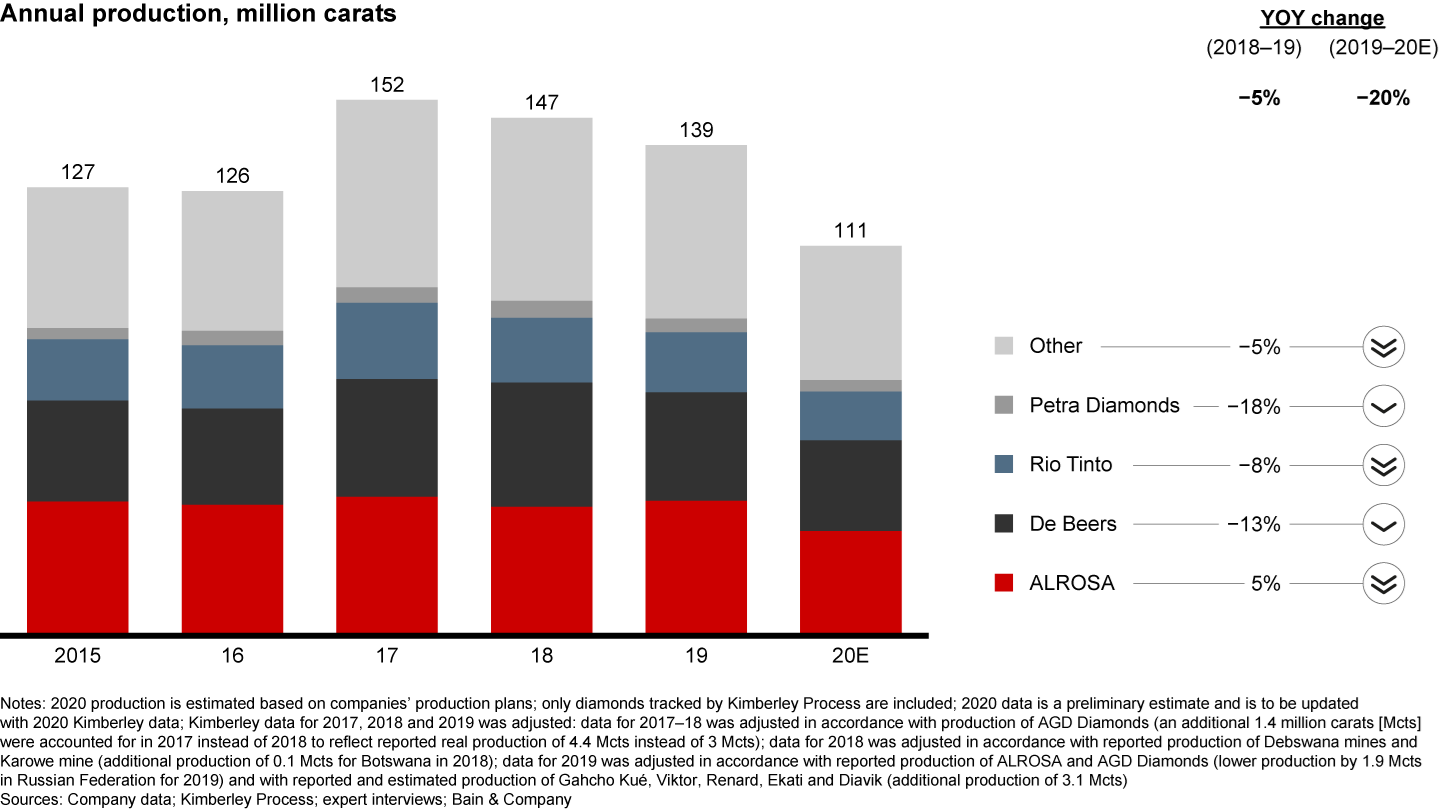
Production value decreased by ~30% in 2020, driven by declines in rough prices and production

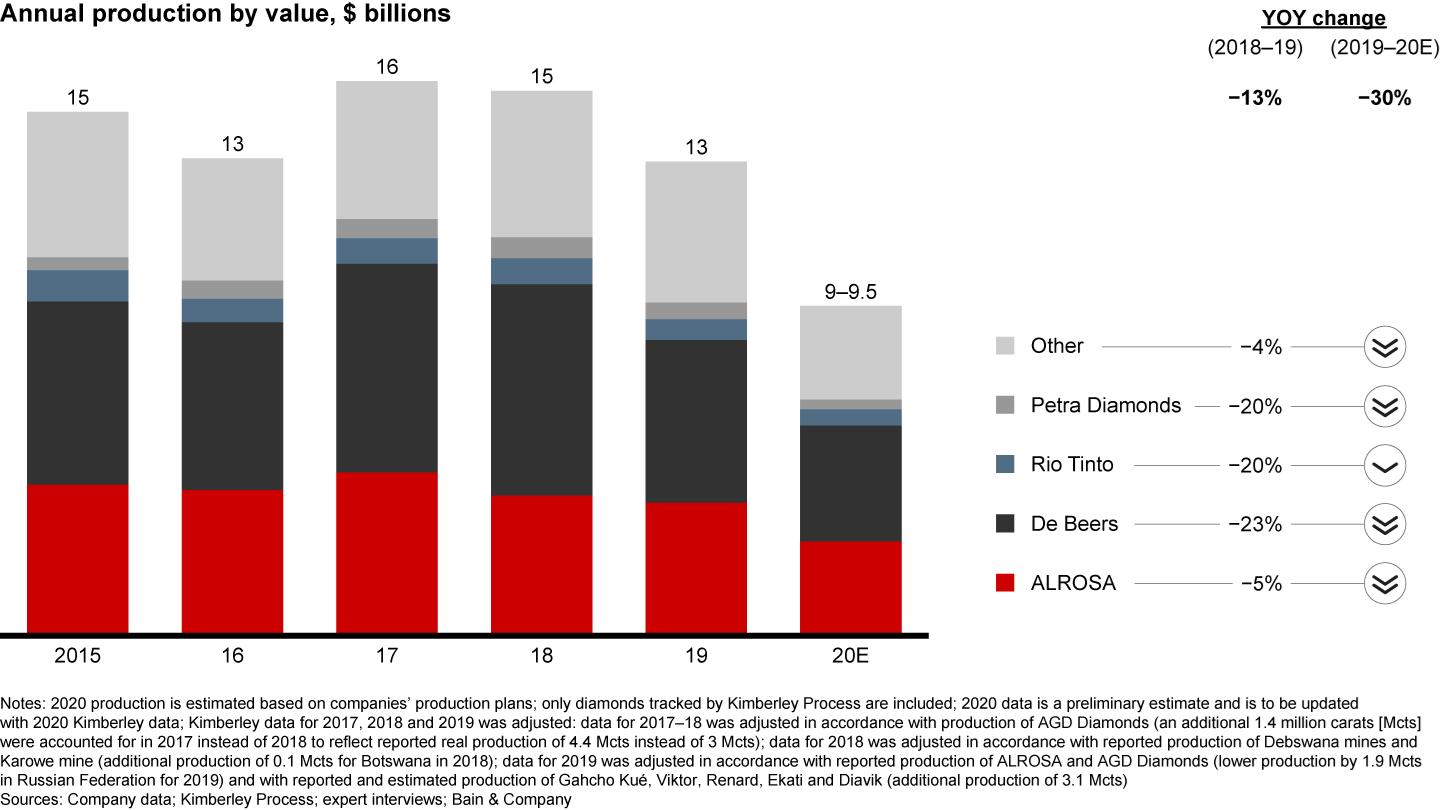
South Africa was the only country with increased diamond production in 2020

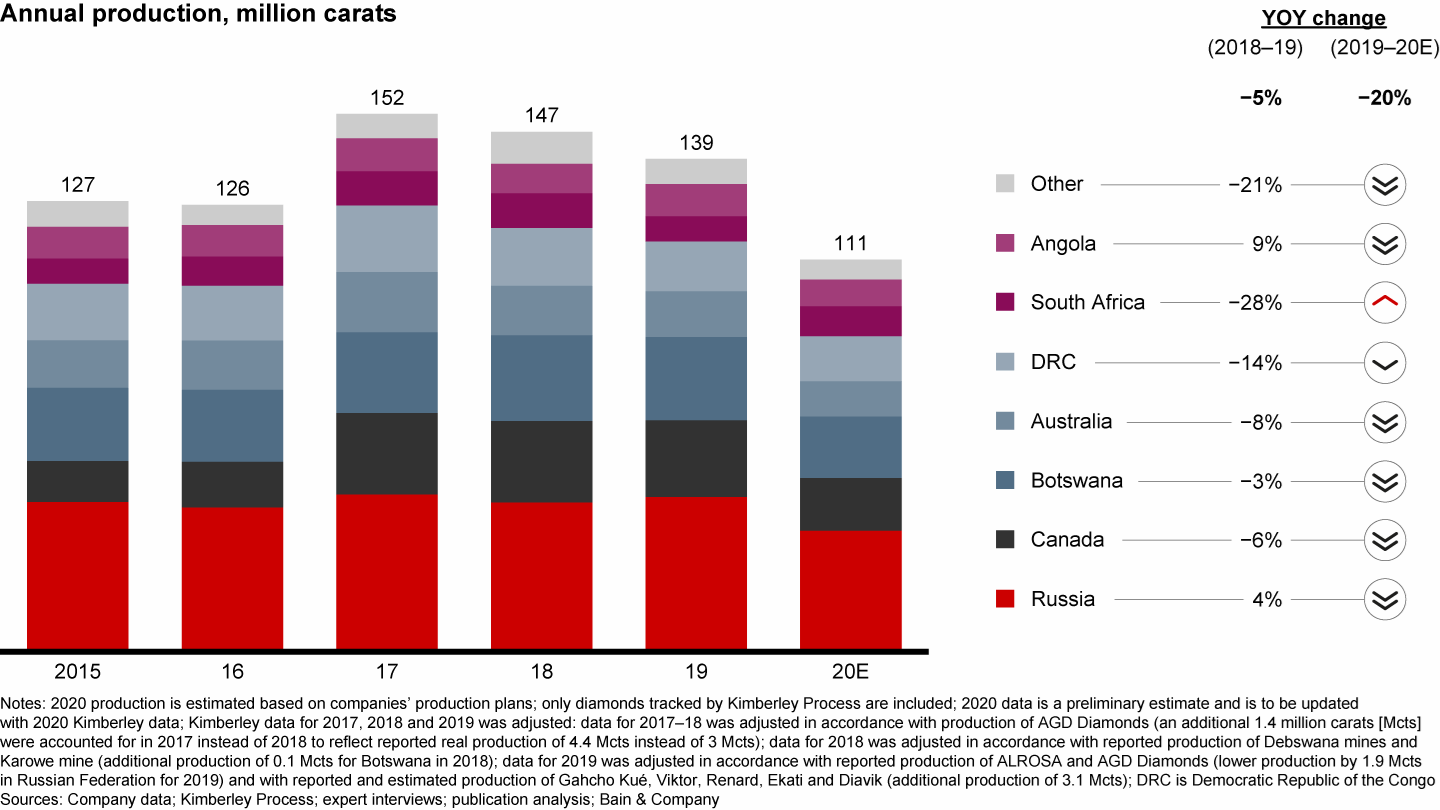
Russia, Canada, and Botswana had the biggest production decreases in 2020

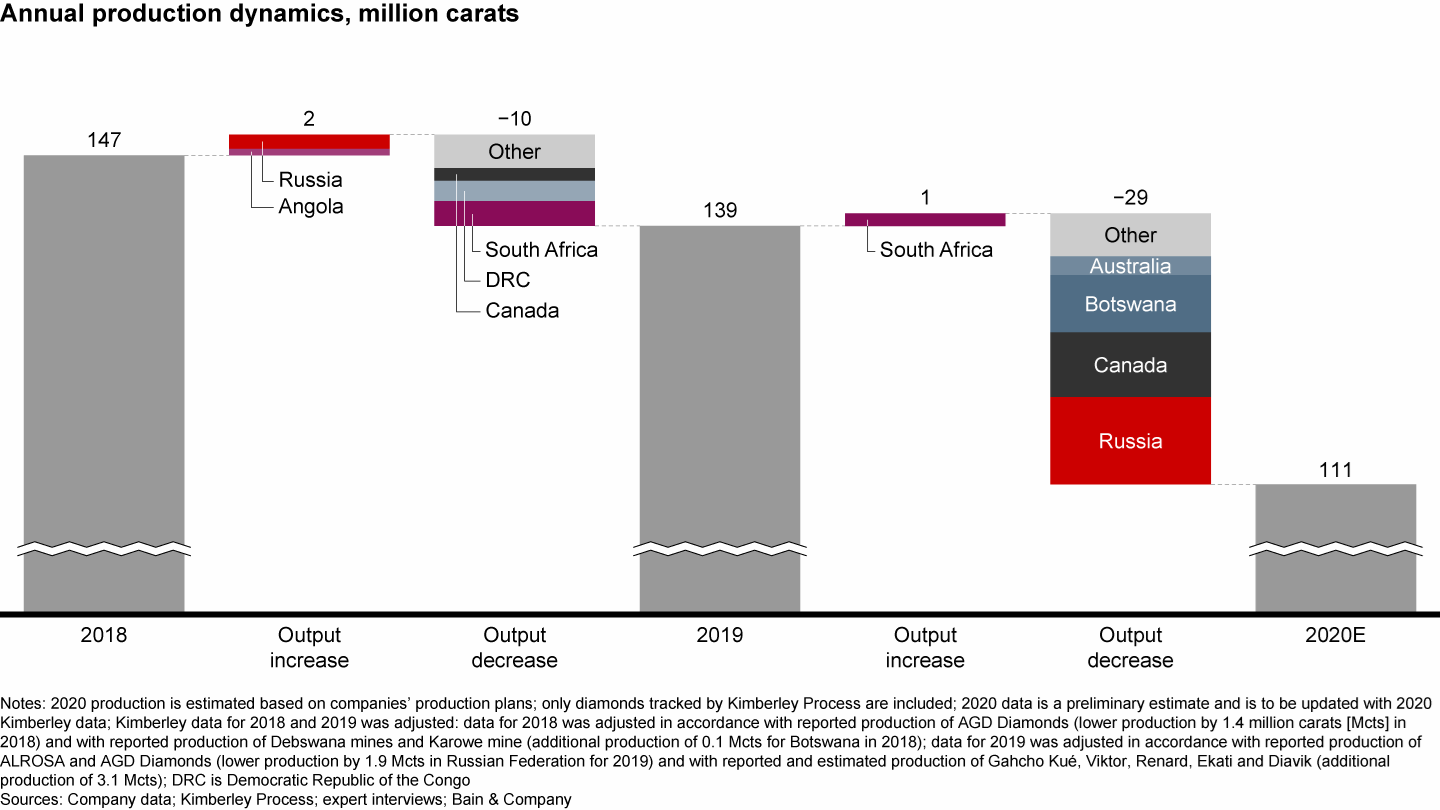
Medium and large diamonds accounted for ~25% of production in carats but nearly 70%–80% in value in US dollars

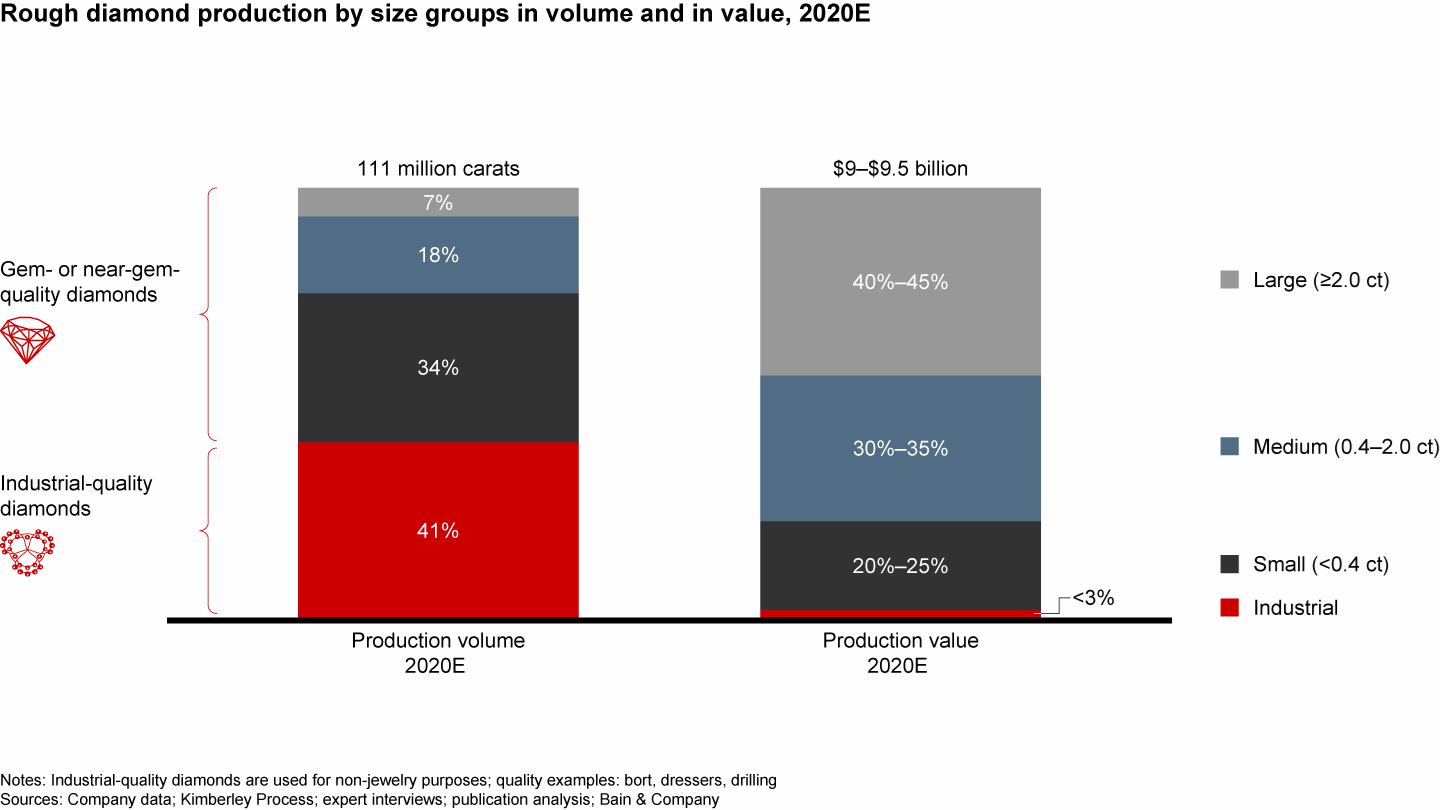
Reduced sales activity in the first half of 2020 put significant pressure on profitability, which is expected to improve by year end

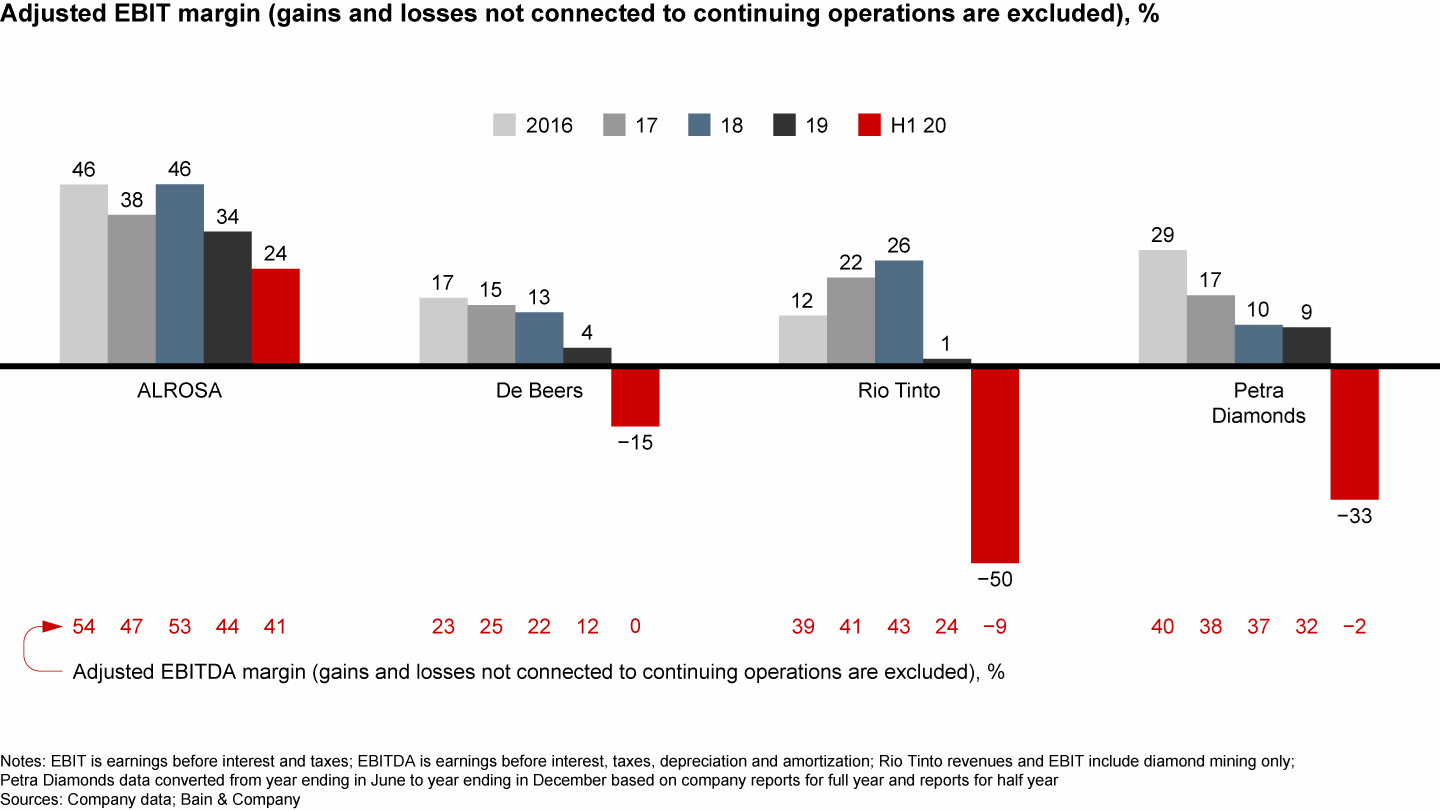

3. Cutting and polishing
- In 2019, cutting and polishing revenue fell by 11% for three reasons: demand for polished diamonds declined, financing shrank, and polished prices fell by 4%. Nonetheless, midstream players deleveraged 10% of excess inventory, lowered rough purchases by 18%, and finished 2019 on a positive trajectory. Manufacturing sales were robust in November and December, driven by stronger-than-expected holiday retail sales. Holiday demand caused downstream inventory replenishment and improved polished diamond pricing. Lower rough diamond prices enabled additional margins in trading and manufacturing.
- The pandemic disrupted operations and logistics along the segment. Sales of polished diamonds fell by 25%, and net imports of rough diamonds to key cutting and polishing countries dropped by 26% year over year in 2020.
- In India, net rough diamond imports decreased by 23%, yet the country retained about 95% market share of global polished diamond manufacturing. India’s decrease in trading and manufacturing was a consequence of strict lockdowns, import moratoriums, restrictions at production sites, and customs processing delays. Smaller factories suffered the most, with limited access to trading centers and higher costs to implement pandemic-related health requirements.
- Chinese manufacturers were among the first to restart operations; they resumed production in March and April and managed to keep 3% market share in global polished diamond manufacturing. Guangzhou Diamond Exchange and customs officials enabled fast import clearance to support an early recovery.
- Antwerp demonstrated resilience throughout 2020 since it had stable access to rough diamond supply and solid demand for high-end goods, which are the focus of Belgian manufacturers.
- Despite disruptions, the midstream finished the year in good shape. Demand for polished diamonds increased in the second half of 2020, leading to a polished price recovery and only a 3% decrease year over year. Inventory levels decreased by 22%, which is healthy for the segment. Profitability moved from near breakeven in prior years to 3% to 5% margins. Cutters and polishers of high-quality diamonds benefited the most; demand for such diamonds was strong in the second half of 2020.
- Outstanding debt in the midstream decreased by 23% year over year, which aligned with reduced activity levels in 2020. Financing institutions extended due dates and canceled credit facility fees during the pandemic. New sources of financing also became available from specialized funds and peer-to-peer lenders.
- Short-term pressures sped up restructuring and consolidation trends, which will continue. Progressive players adjusted their business models in several ways: They started making purchasing decisions based on retail demand versus manufacturing capacity, and they entered partnerships with mining companies to share risk on polished price volatility. In addition, they used analytics to predict polished output and prices based on rough diamond parameters, started testing automatic cutting and polishing machines (Synova DaVinci Diamond Factory or Fenix machine), and shifted more purchasing and sales activities to digital channels.
- In 2021, performance will depend on how the midstream collectively responds to two factors: downstream demand for polished diamonds after the holiday season, and new sales agreements and rough price policies developed by major miners.
Covid-19-related restrictions resulted in ~26% reduction of C&P activities globally, with India recovering the fastest

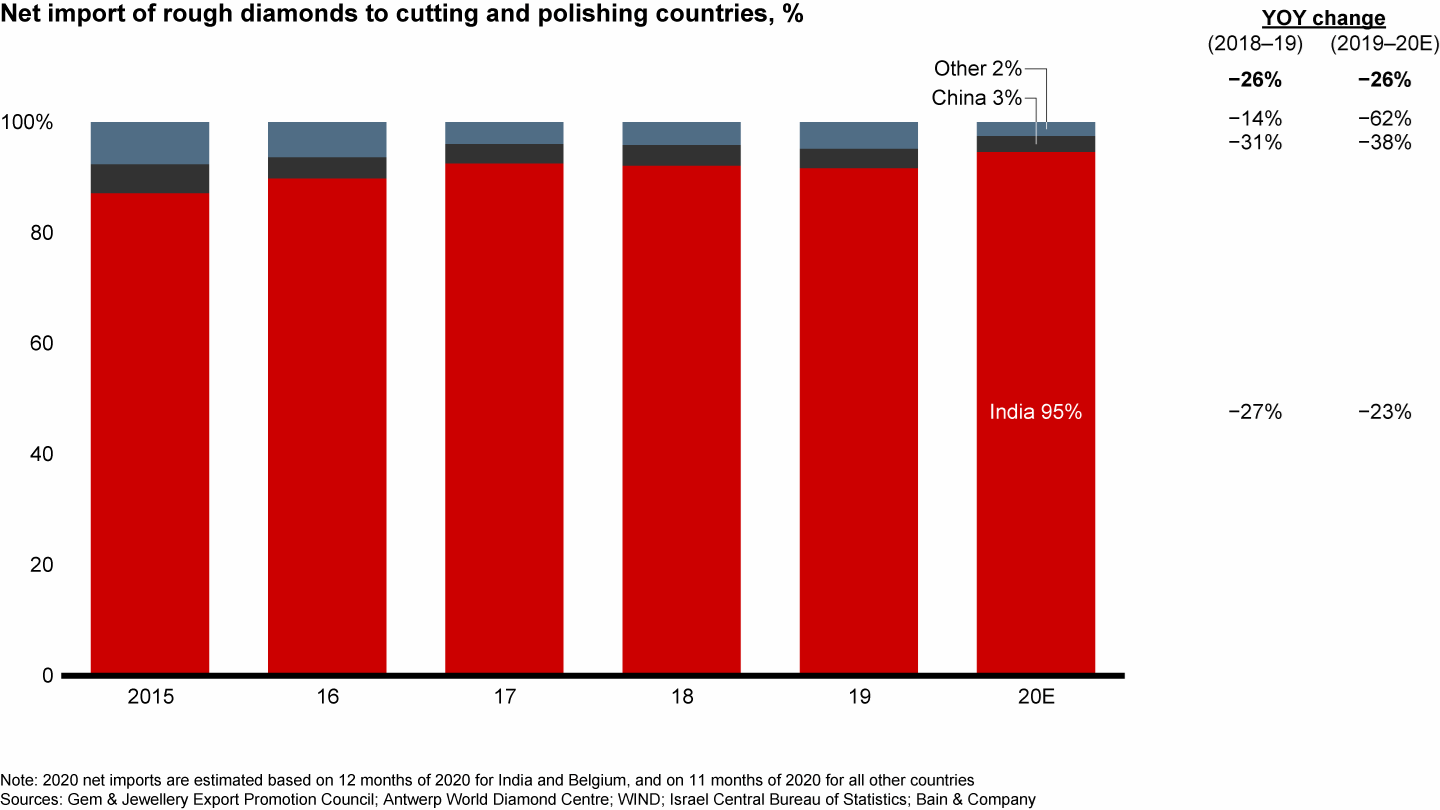
In India, net imports of rough diamonds decreased by 27% in 2019 and 23% in 2020; recovery began in Q3 2020

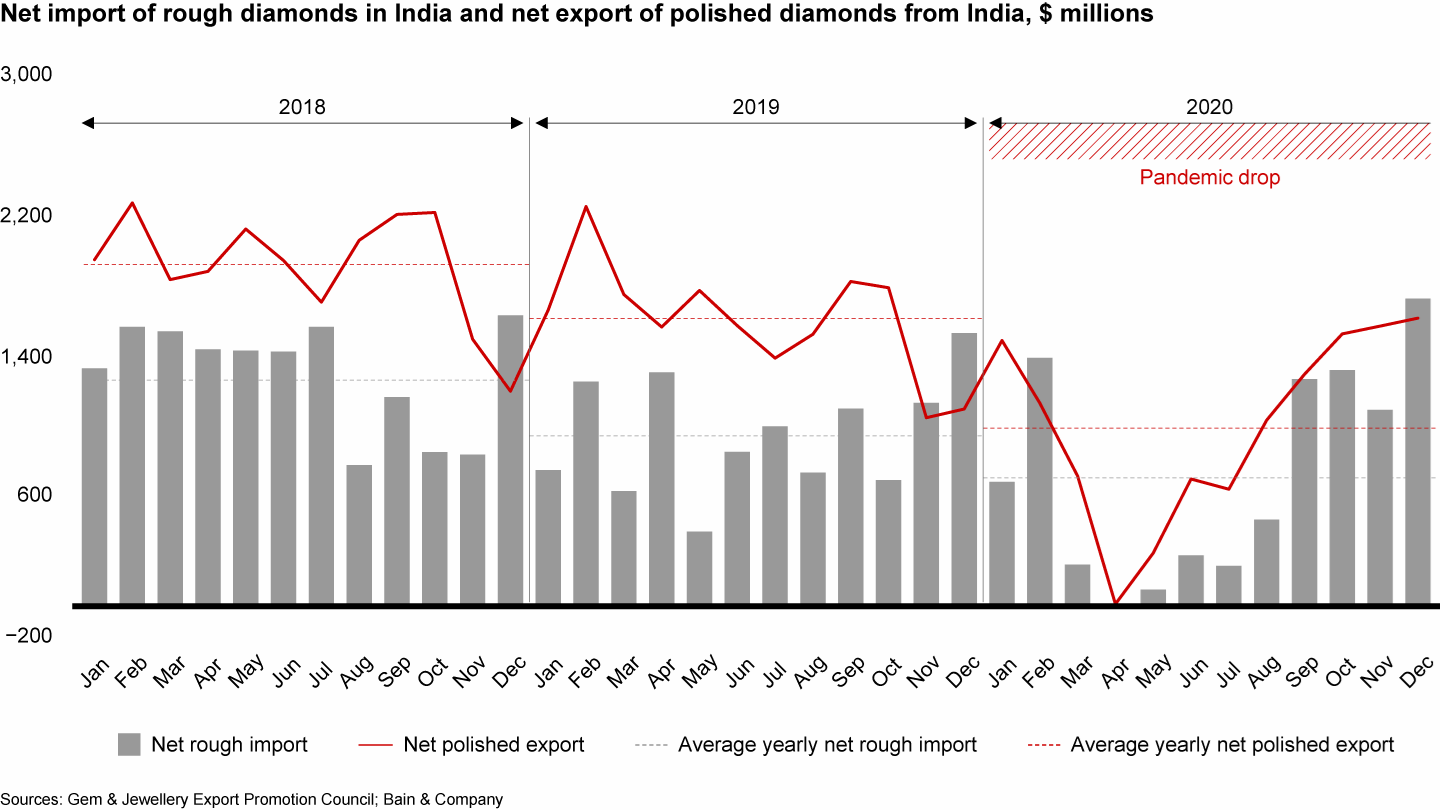
Due to a significant decrease in rough diamond sales, midstream inventories returned to some of the lowest levels in a decade

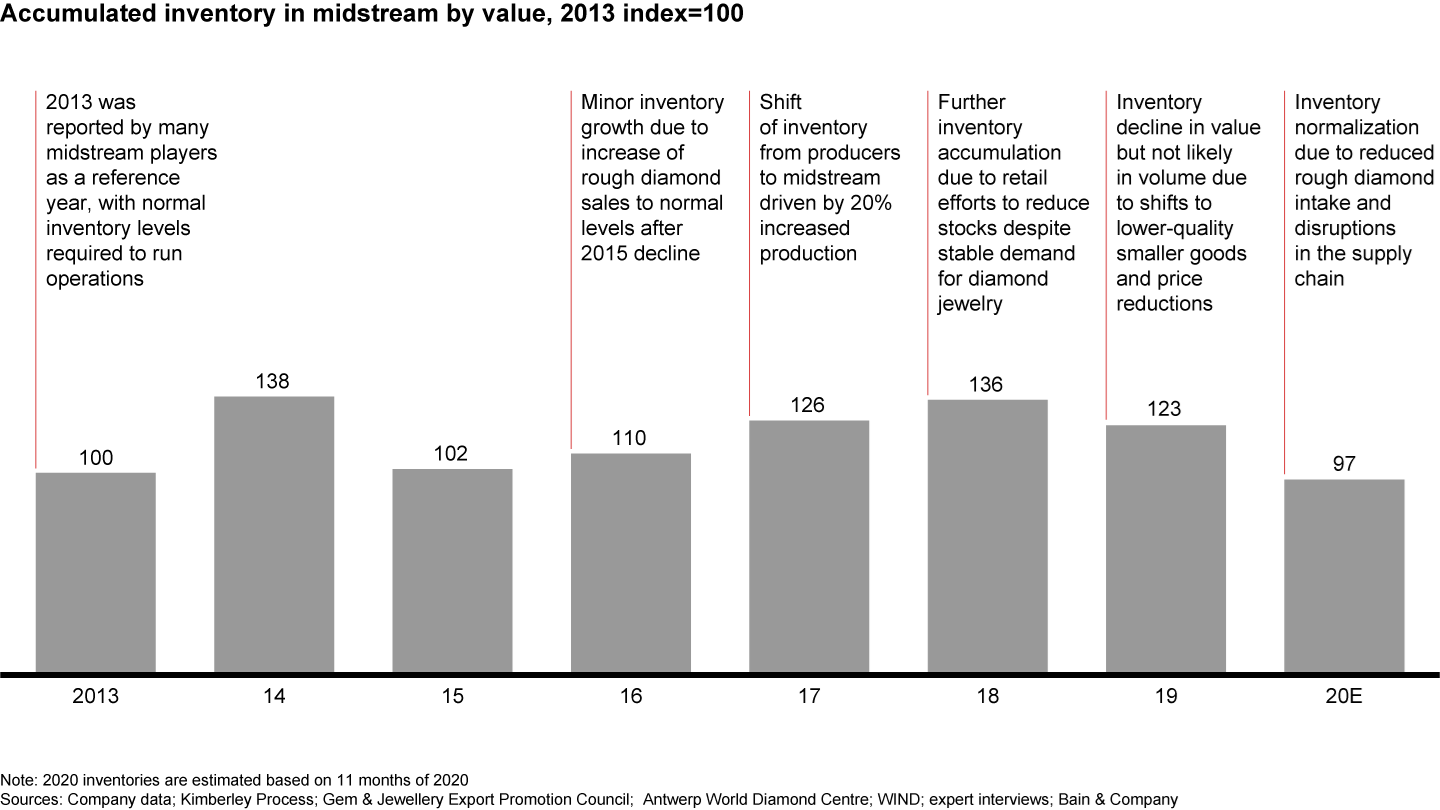
Diamond financing continued to decrease, aligning with reduced activity levels in 2020

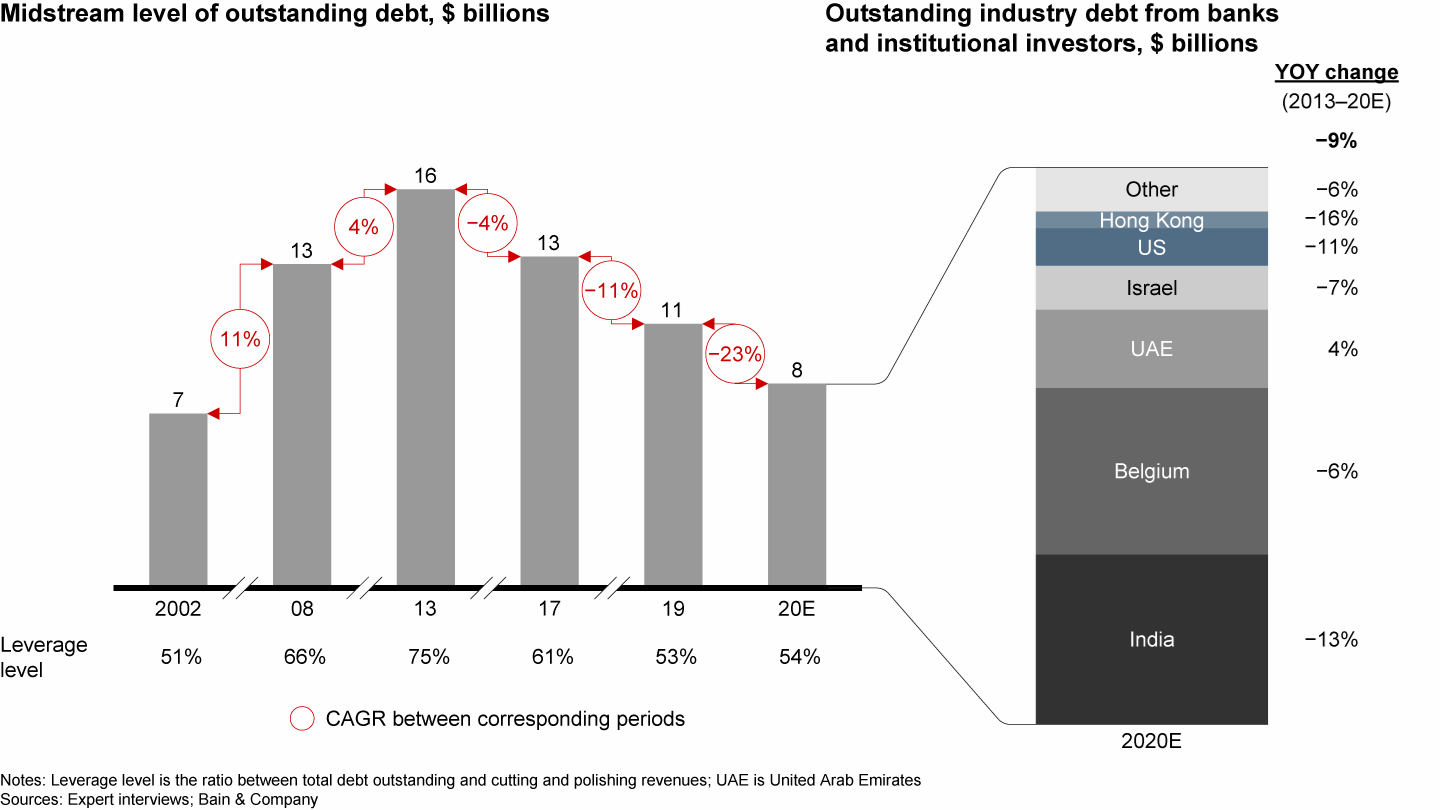

4. Diamond jewelry retail
- Diamond jewelry retail was flat in 2019, with corrections to exchange rate movements. The US retail market rose 1% after a strong holiday season. It declined 5% in China, where accelerated local spending was depreciated by a weaker yuan. Trade wars between the US and China dragged down consumer sentiment and negatively influenced both markets in 2019.
- Store closures, wedding cancellations, and travel restrictions to traditional shopping destinations all hurt the market in the short term and undermined consumer financials and confidence in the medium term. These negative effects were offset by “emotional hunger” during lockdowns, decreased competition from typical luxury rivals (travel, experiences, and apparel), and the quick expansion of online channels. Local consumption grew due to global travel restrictions. Diamond jewelry is expected to perform better than the global personal luxury market in 2020, with only a 15% drop compared with a 22% decline in luxury.
- China’s diamond jewelry market suffered during the pandemic but recovered quickly once lockdowns were released. The bridal segment suffered the most due to wedding delays in February and May (two of the three main wedding seasons in China). Local purchasing rose significantly thanks to government repatriation policies (e.g., reduced import duties), price harmonization among brands, and international travel bans. New sales channels like podcasting and other social media (e.g., Weibo, TikTok, Red, Bilibili, WeChat), online store sales (e.g., Taobao), and VIP membership sales allowed retailers to reach customers in a more interactive manner and also contributed to double-digit growth in China. Retailers engaged with new brand ambassadors, key opinion leaders (KOLs), and key opinion consumers (KOCs) that are popular among Generation Z to promote products and influence sales. Hainan, China’s holiday island, became a substitute destination for international travel and saw duty-free diamond jewelry sales surge. Key jewelers expanded their retail footprints into lower-tier cities, which also supported sales growth. One notable exception: Hong Kong. The pandemic slammed the brakes on tourism, spending, and diamond jewelry retail in the city. In total, retail in Greater China is expected to decrease by 6% year over year.
- The US postponed and limited lockdowns and has not yet experienced a full or definitive recovery from the pandemic. In the second quarter, jewelry sales dropped more than 40% after the stock market crashed and unemployment rose to 15%. The US jewelry market felt the decline in international tourism and related spending on luxury and premium products. However, significant government support, employment rate improvement, positive vaccine news, and a pre-holiday marketing push helped turn things around. A resurgence in diamond jewelry demand began with Black Friday and held through the holiday season. We expect a 15% decrease in year-over-year retail results in the US.
- European markets, which rely heavily on brick-and-mortar diamond sales, were less resilient. Key markets across Europe experienced a second wave of strict lockdowns, which hurt Christmas sales. Once sales are fully tallied, we expect a 20% decline in retail in Europe in 2020.
- In India, we expect total lockdowns, economic fallout, and deferred weddings to have caused a 26% decrease in retail sales in 2020.
- Demand recovery is unlikely to be linear or equally distributed due to differences in lockdown policies and lengths, government support mechanisms, and online sales adoption. We believe the Chinese diamond jewelry retail market will recover in early 2021, while other developed countries will reach pre-pandemic levels in 2022 to 2023. Retail recovery in emerging countries will follow a year later.
Consumers delayed discretionary spending during the pandemic, but diamond jewelry retail was less affected than the personal luxury market

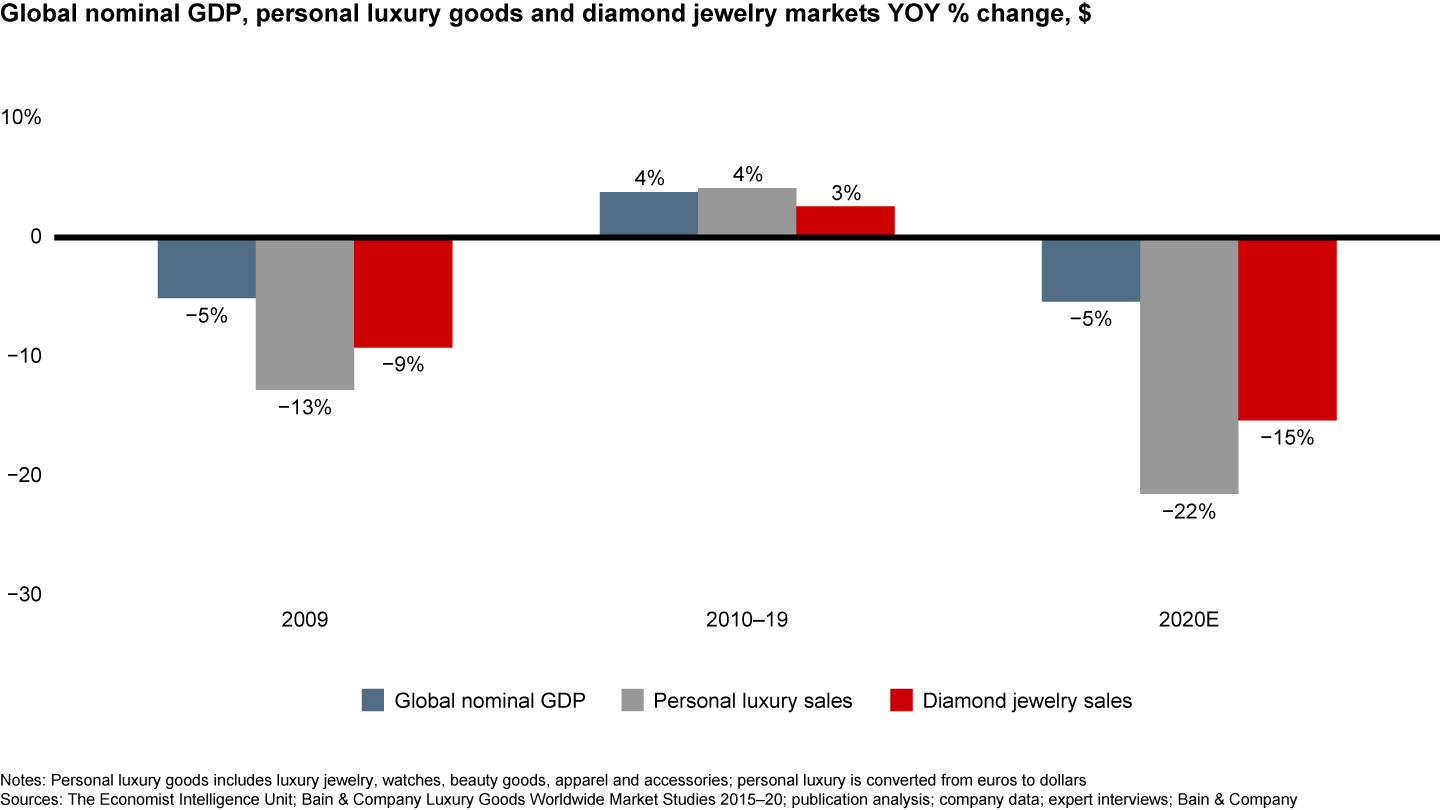
After single-digit growth in recent years, the global diamond market was materially impacted by the pandemic and economic downturn in 2020

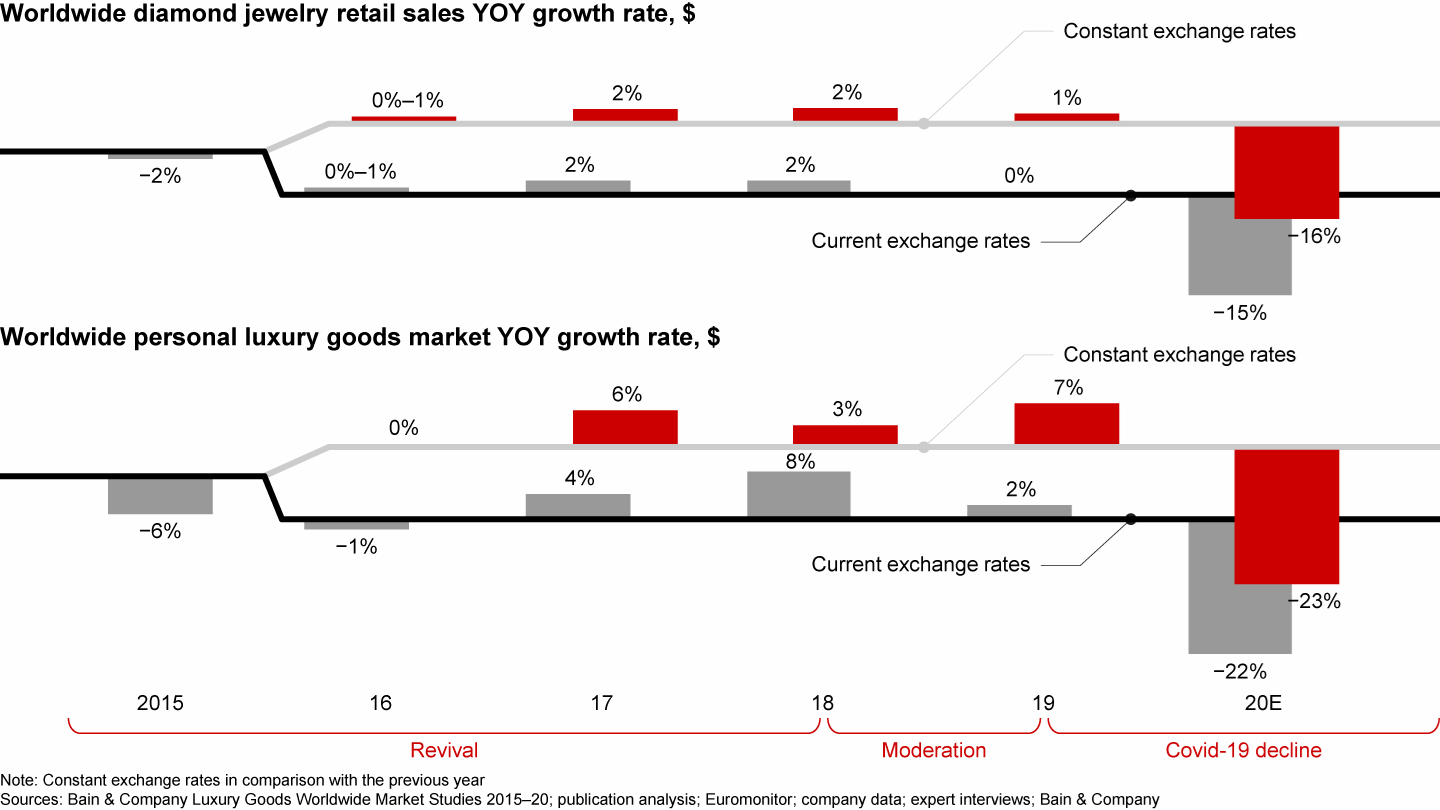
Despite challenges in 2019 and the first half of 2020, key markets are showing signs of recovery

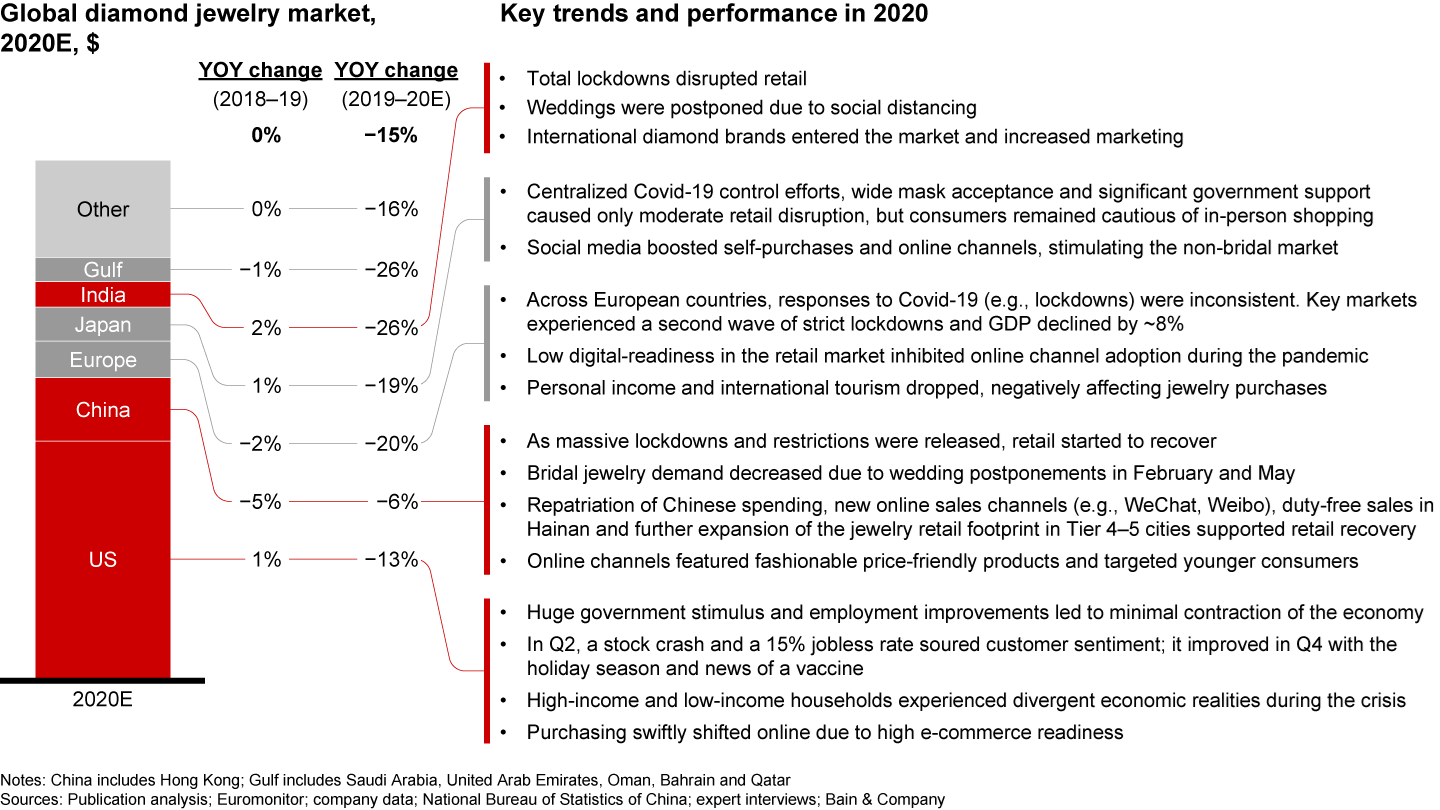
After a significant drop at the start of 2020, key diamond jewelry markets demonstrated recovery trends in the second half of the year

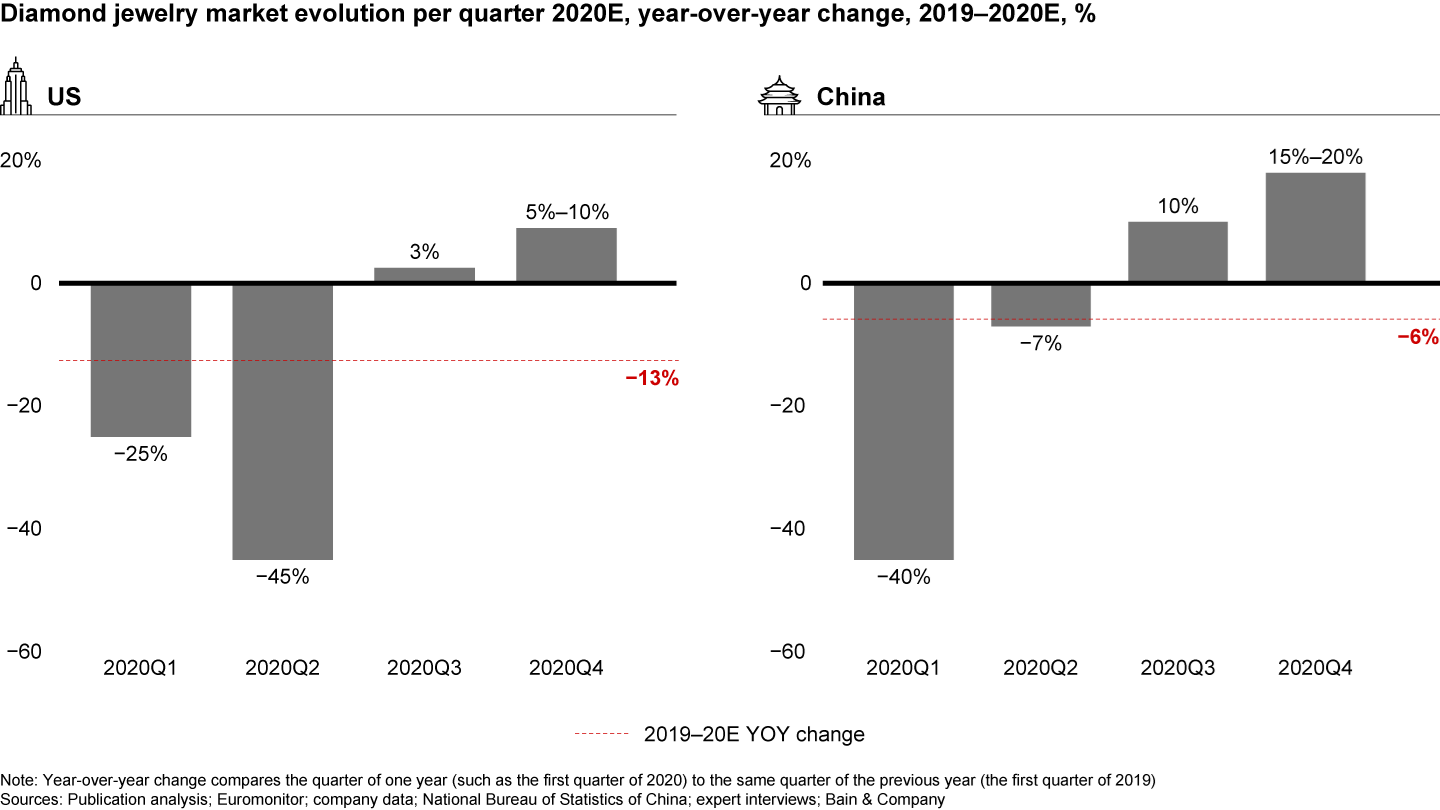
In 2020, diamond jewelry outpaced other jewelry segments due to the relatively strong performance of luxury jewelry in Asia

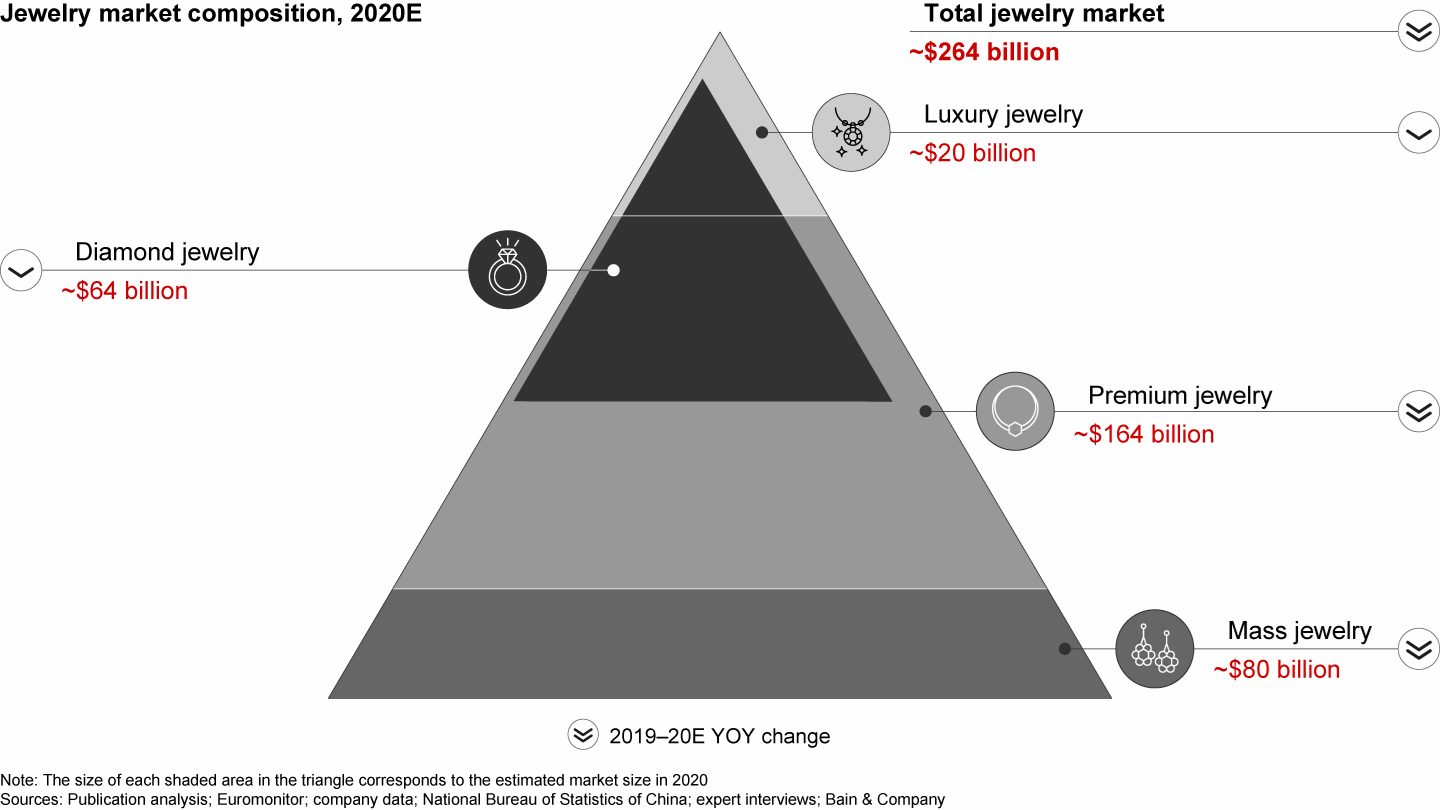
Luxury bridal and luxury non-bridal diamond jewelry were the top-performing categories in the diamond jewelry market

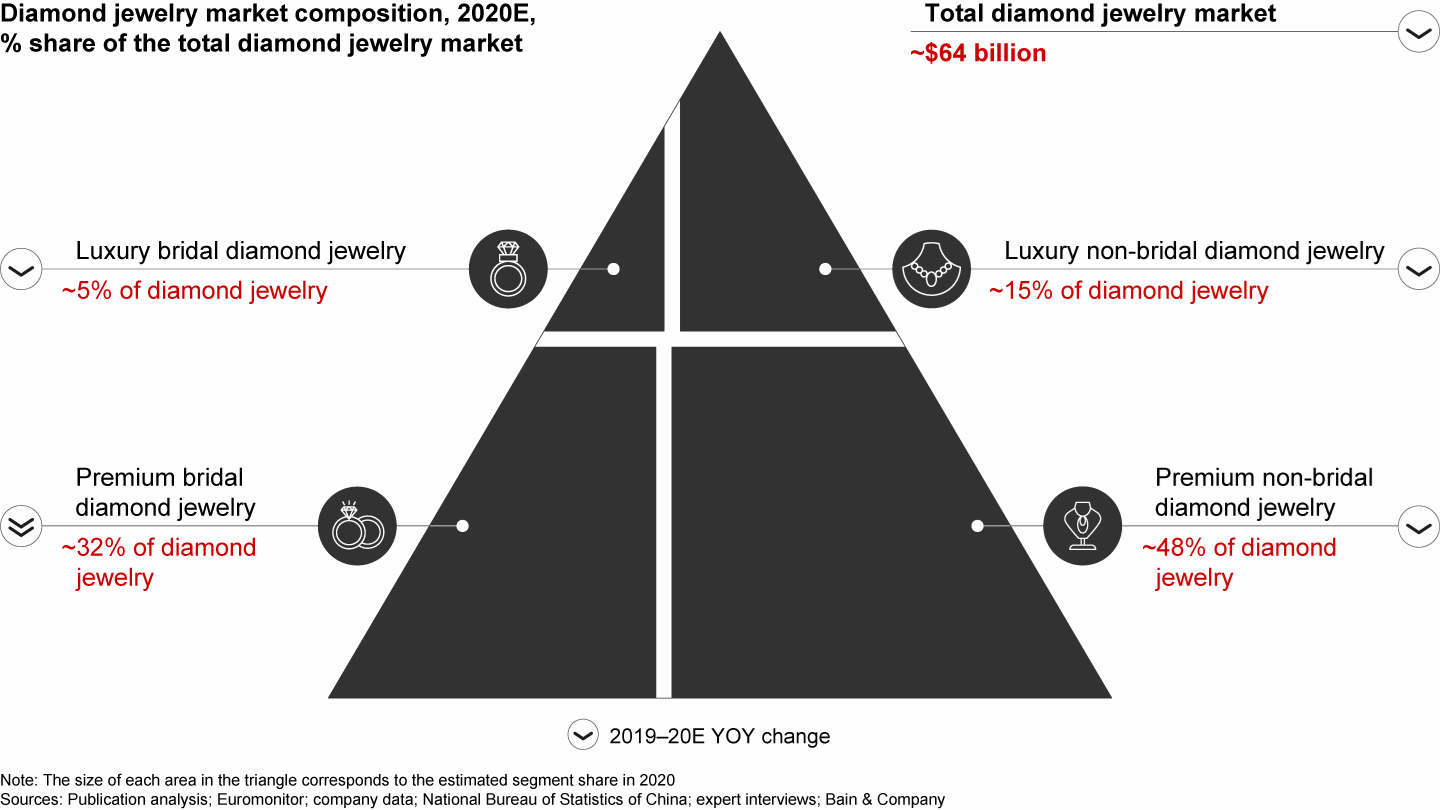

5. Key industry trends and effects of Covid-19
- The pandemic simultaneously disrupted the supply and demand sides of the diamond market. Logistical collapses, lockdowns, and business closures rocked supply chains. On the demand side, loss of income from morbidity, quarantine, and unemployment weakened economic prospects and lowered household consumption. Consumer interest in the diamond category remained strong, but consumer behavior and preferences changed. Diamond industry players and marketers need to respond to four important shifts.
- Online shopping increased. In 2020, up to about 20% of diamond retail sales occurred online (up from approximately 13% in 2019). Most consumers use digital tools to research and choose jewelry before they make in-store purchases. Since this trend is unlikely to fully reverse after the pandemic, retailers must invest in digital capabilities, delightful online shopping experiences, and seamless omnichannel or phygital interactions. Marketers can also apply data analytics to develop more personalized campaigns, products, and services for online shoppers. To encourage online demand, the industry can support diamond certificate initiatives, warranty programs, and customer reviews. Generous delivery and return policies will also increase the convenience of online shopping.
- Sustainability and social consumerism became more influential to purchase decisions, and the pandemic heightened attention to global health and safety concerns. Regarding diamond jewelry, social impact is the top sustainability concern for US consumers; in China and India, consumers care most about environmental preservation, conflict-free supply chains, and carbon footprint. Governments, professional groups, and local communities are pressuring the industry, too. Companies along the value chain are responding with a wide range of initiatives, including capital projects to reduce emissions and diversity and traceability programs. Going forward, industry players should integrate ambitious environmental, social, and governance (ESG) targets in their asset plans and internal incentive schemes to demonstrate their commitment. They should also communicate their progress to society.
- In 2020, lab-grown diamond production reached 6 to 7 million carats, with up to 60% of it manufactured in China using high-pressure, high-temperature technology. Chemical vapor deposition technology is gaining share, with India and the US emerging as major production centers. As expected, retail prices for lab-grown diamonds fell in 2020 while wholesale prices remained stable. That led to a margin contraction for traders and jewelry manufacturers. We believe additional price drops will make lab-grown diamonds accessible to broader groups of price-sensitive consumers and push them further into the fashion category, where they have growth potential. Most of the retail lab-grown market is currently concentrated in the US; China is a distant second.
- Although most consumers say the pandemic will not affect their long-term interest in diamond jewelry, Covid-19 accelerated emerging trends in marketing. Diamond marketing is becoming more complex, accentuated by fierce competition for share of wallet, diamonds’ low purchase frequency per consumer, and changing product requirements for new generations. And the diamond industry is not investing enough in marketing compared with other premium and luxury segments. The era of one-size-fits-all marketing is over. Developing customized, analytics-based strategies will become a key competitive advantage going forward. To succeed in a post-crisis world, marketers need tools to closely monitor shifting customer sentiments and priorities, leverage data analytics, and ramp up personalization.
Covid-19 shaped and accelerated key diamond industry trends


Covid-19 impacted diamond jewelry purchasing via lockdowns and an economic recession and stimulated changes in consumer behavior

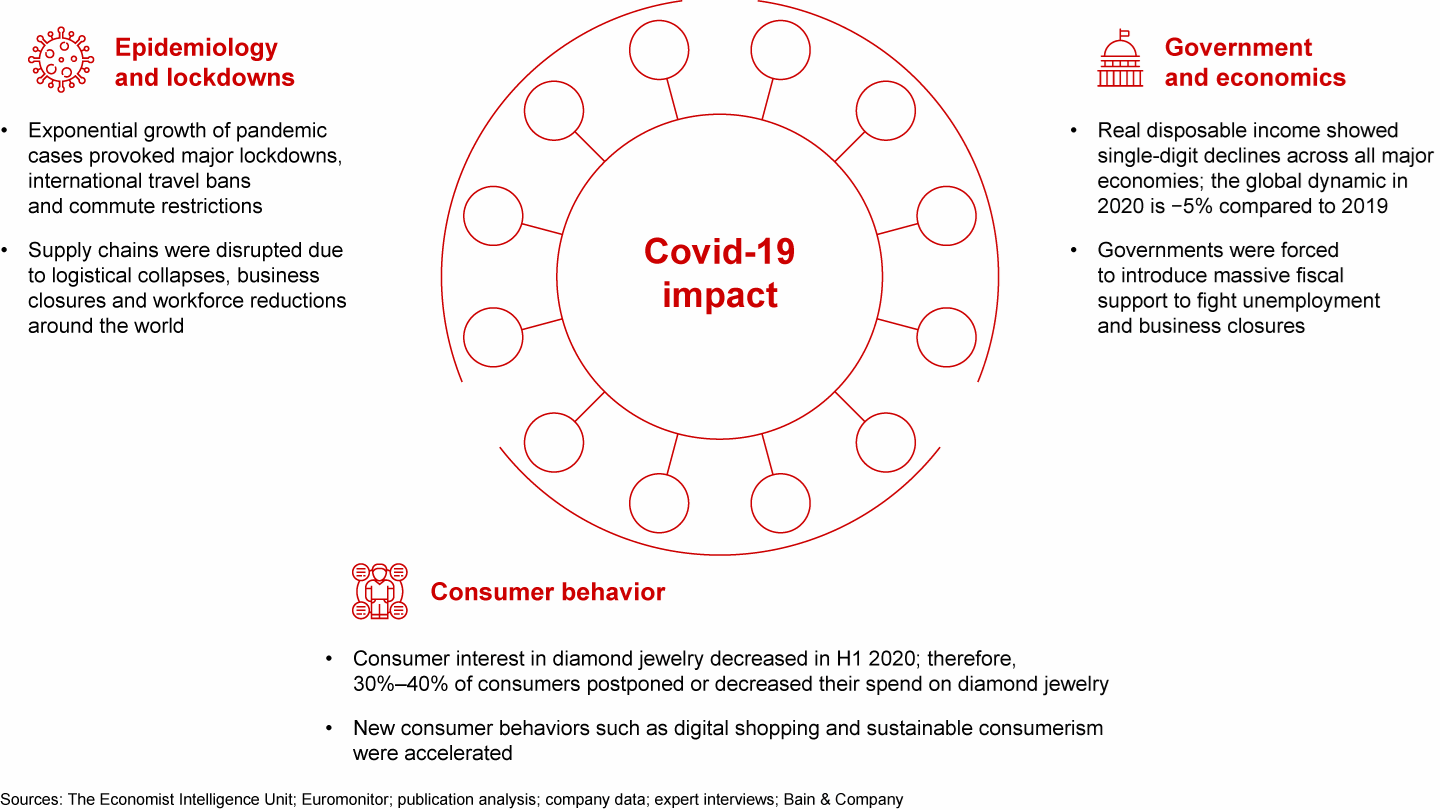
The current economic crisis is expected to be deeper than the one in 2009

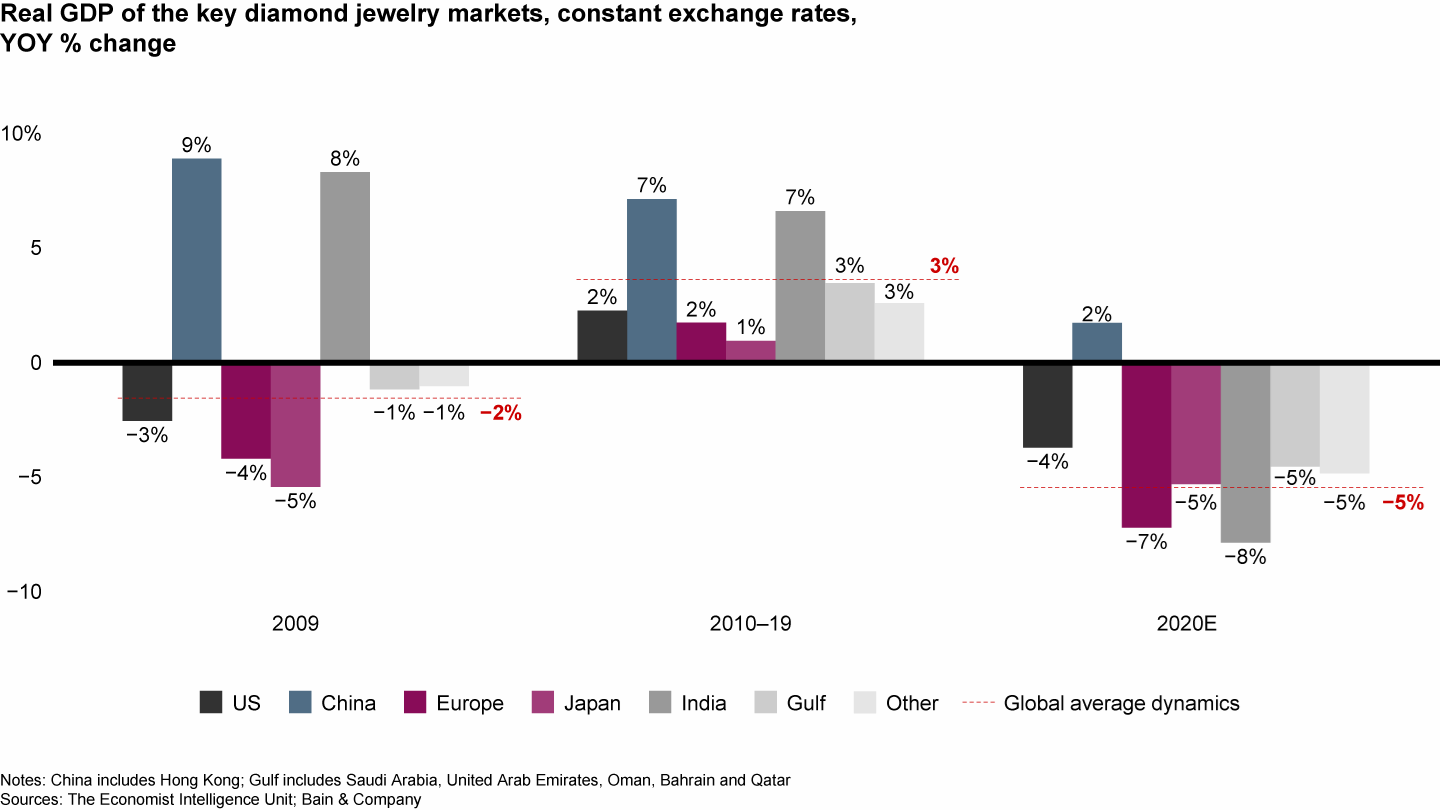
Interest in diamond jewelry dropped for three months, then reverted to 2019 levels in July

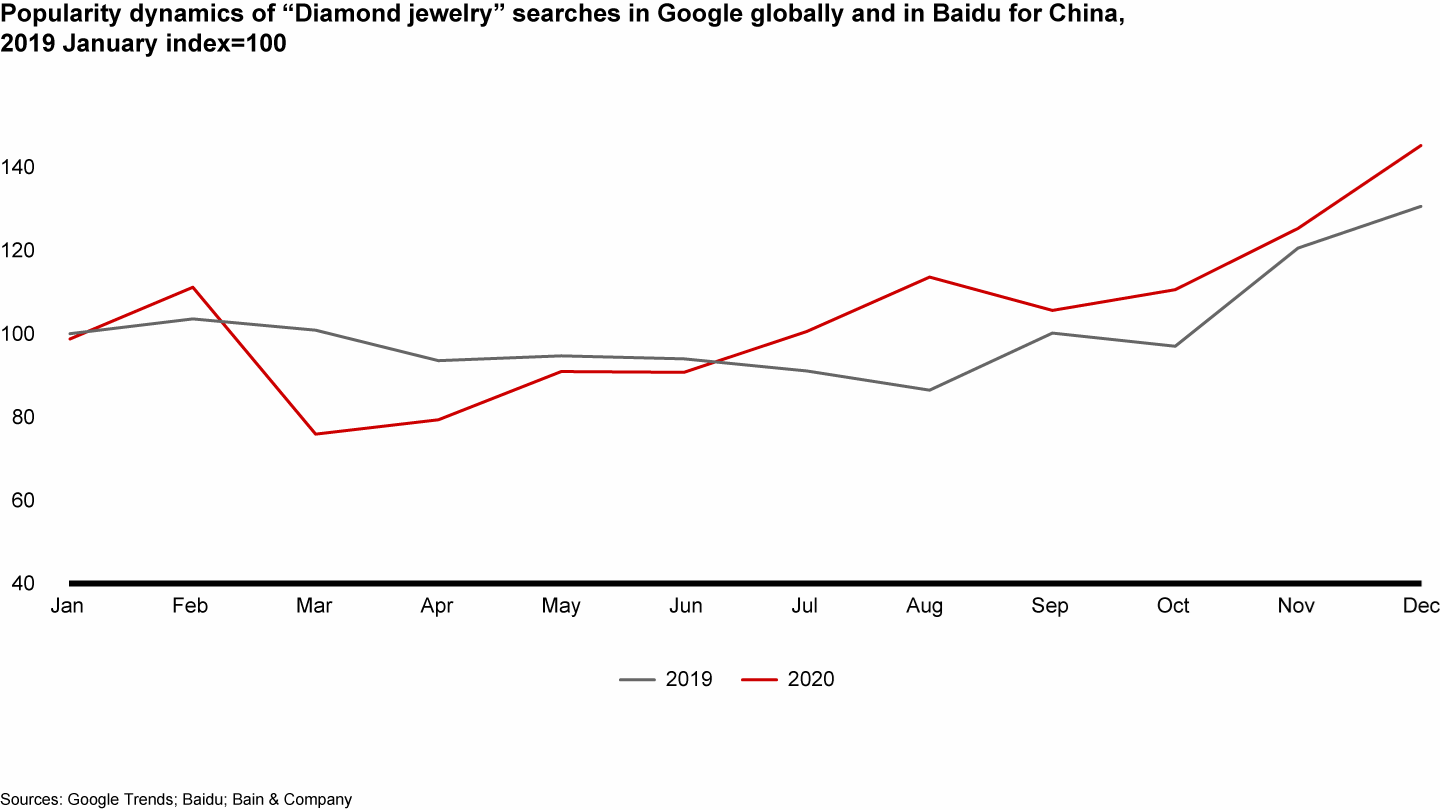
Most consumers plan to spend the same amount or more on diamond jewelry when the pandemic ends

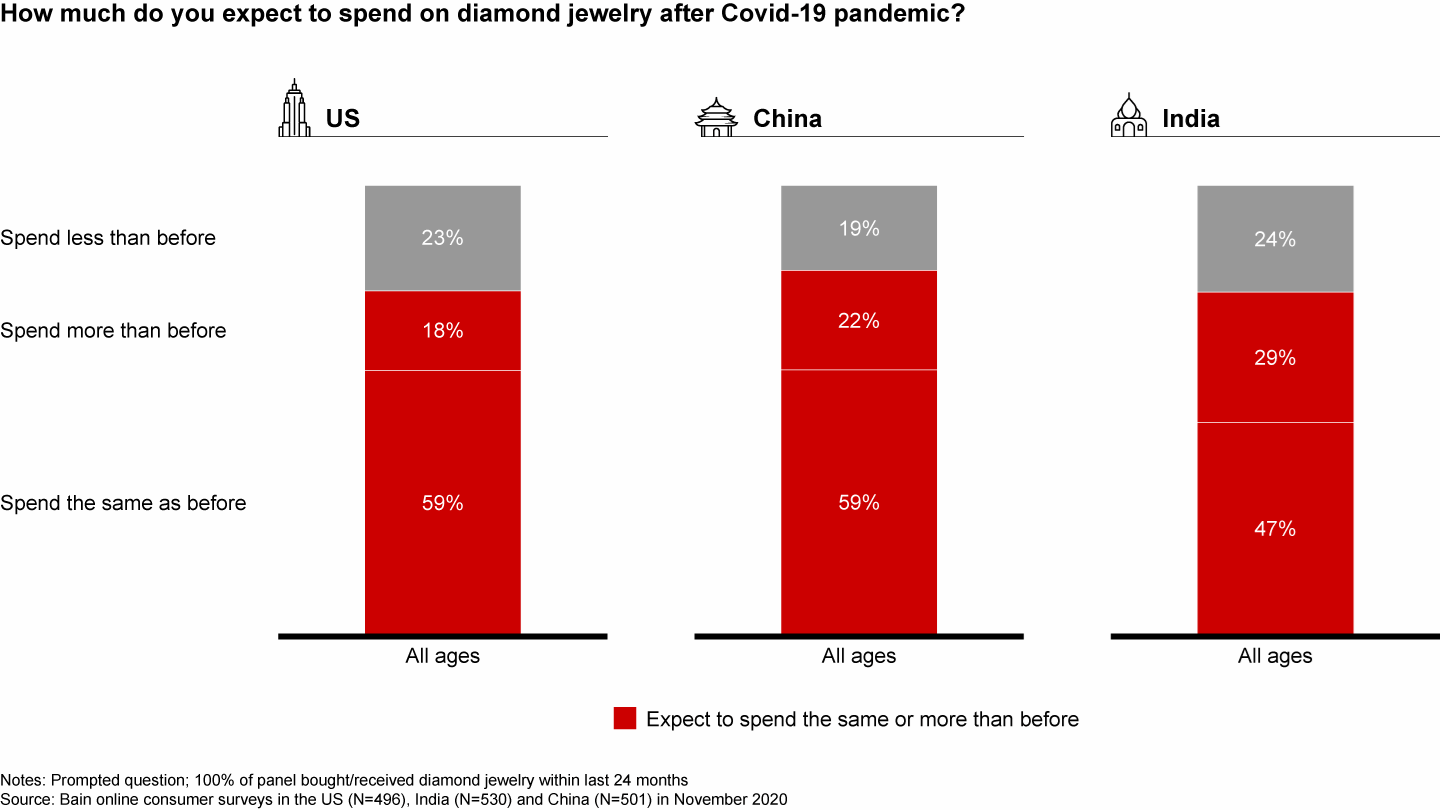
Diamond jewelry recovery is expected in the next two to four years, with the market returning to its pre-pandemic level in 2022 or 2023

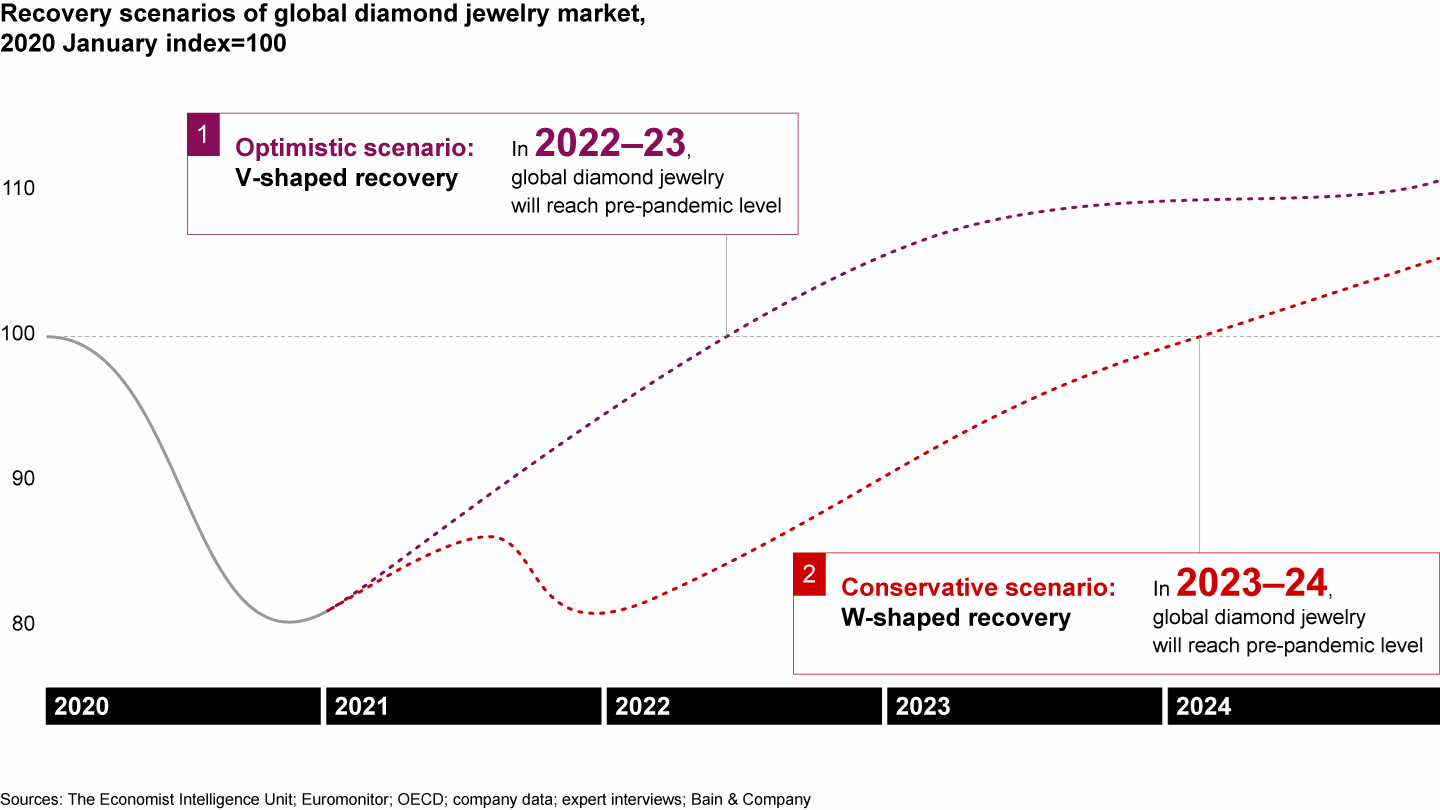
Diamond jewelry recovery depends on the epidemiology of Covid-19, government actions, and consumer behavior

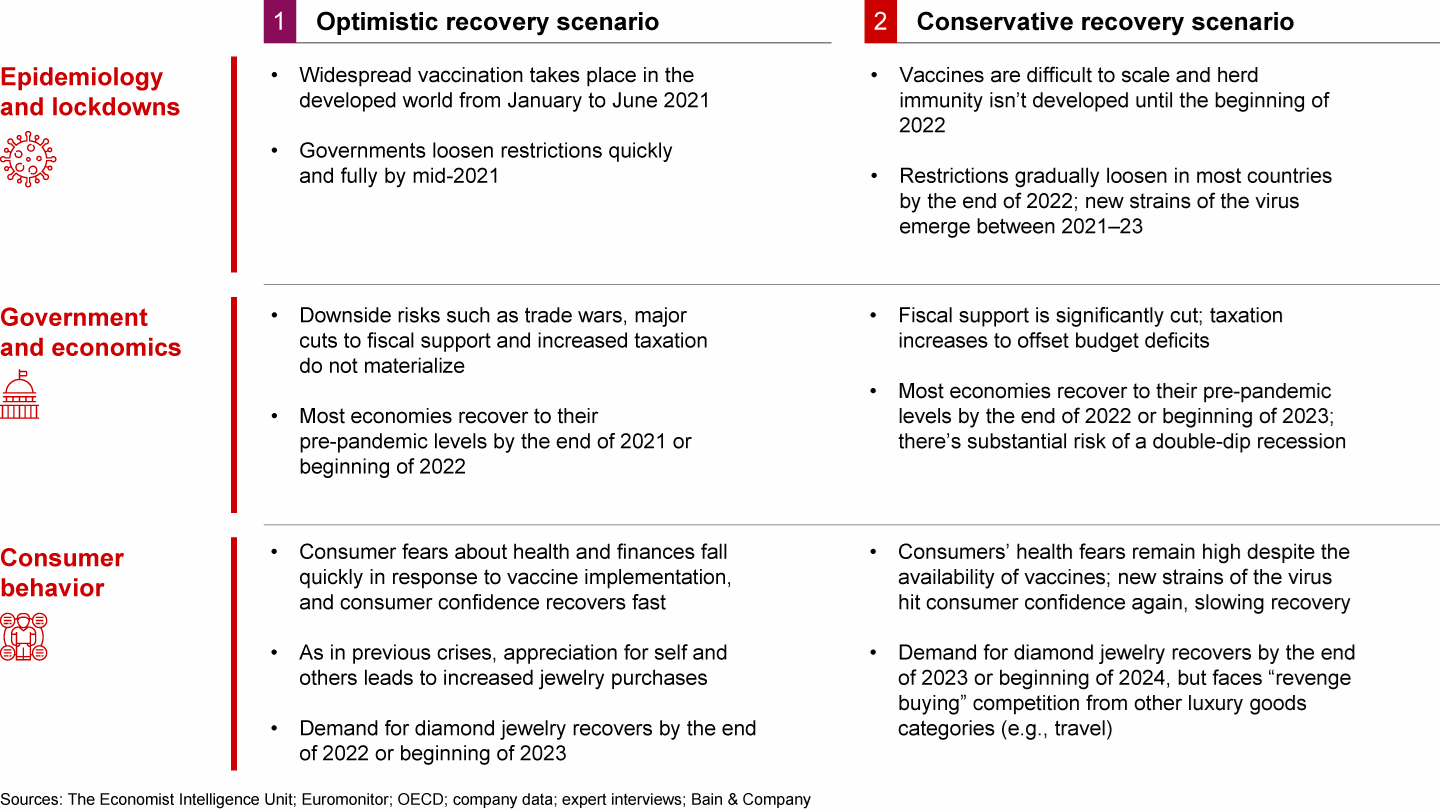
E-commerce experienced a major boost in 2020

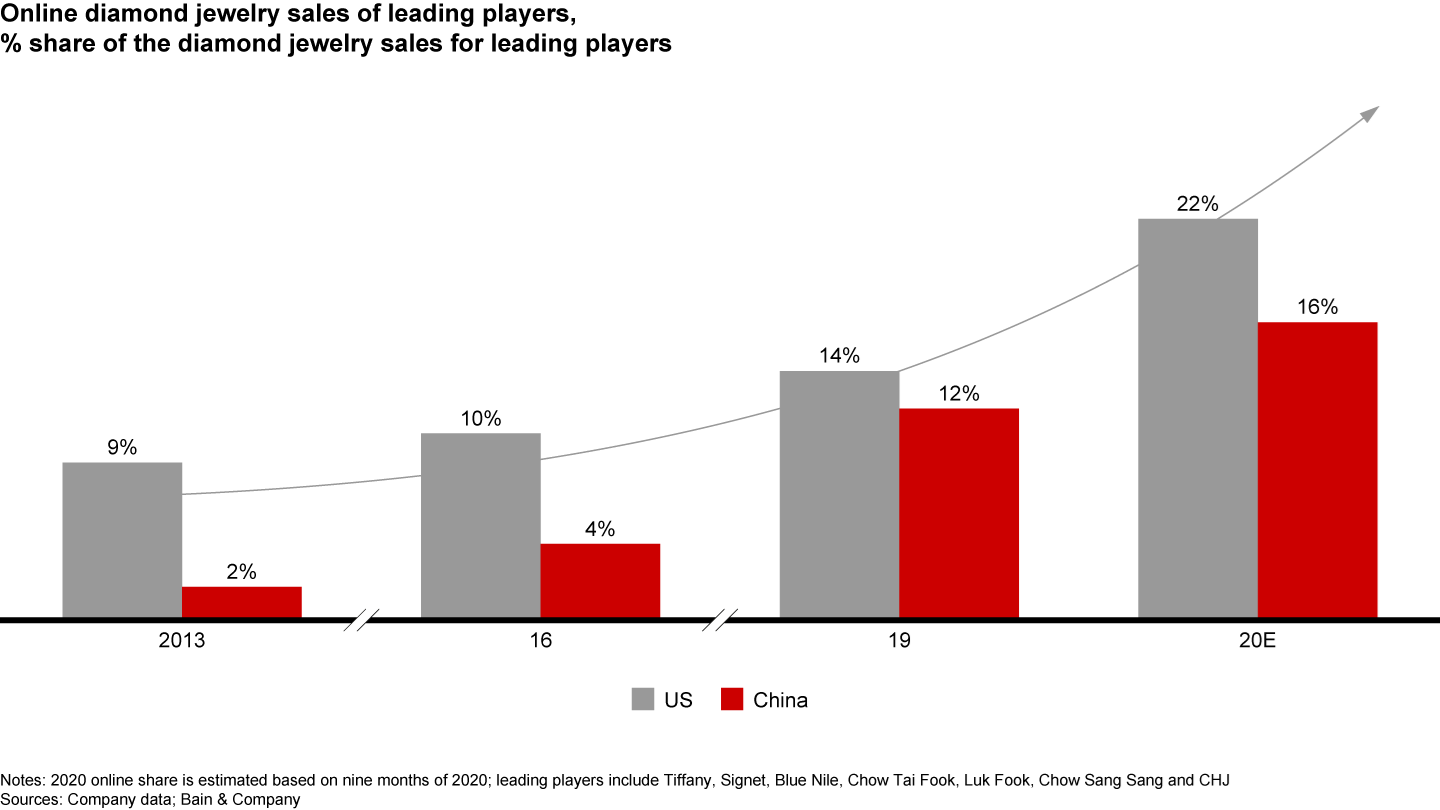
Consumer shopping preferences are slowly shifting to online; however, specialized brand stores remain the most popular channels

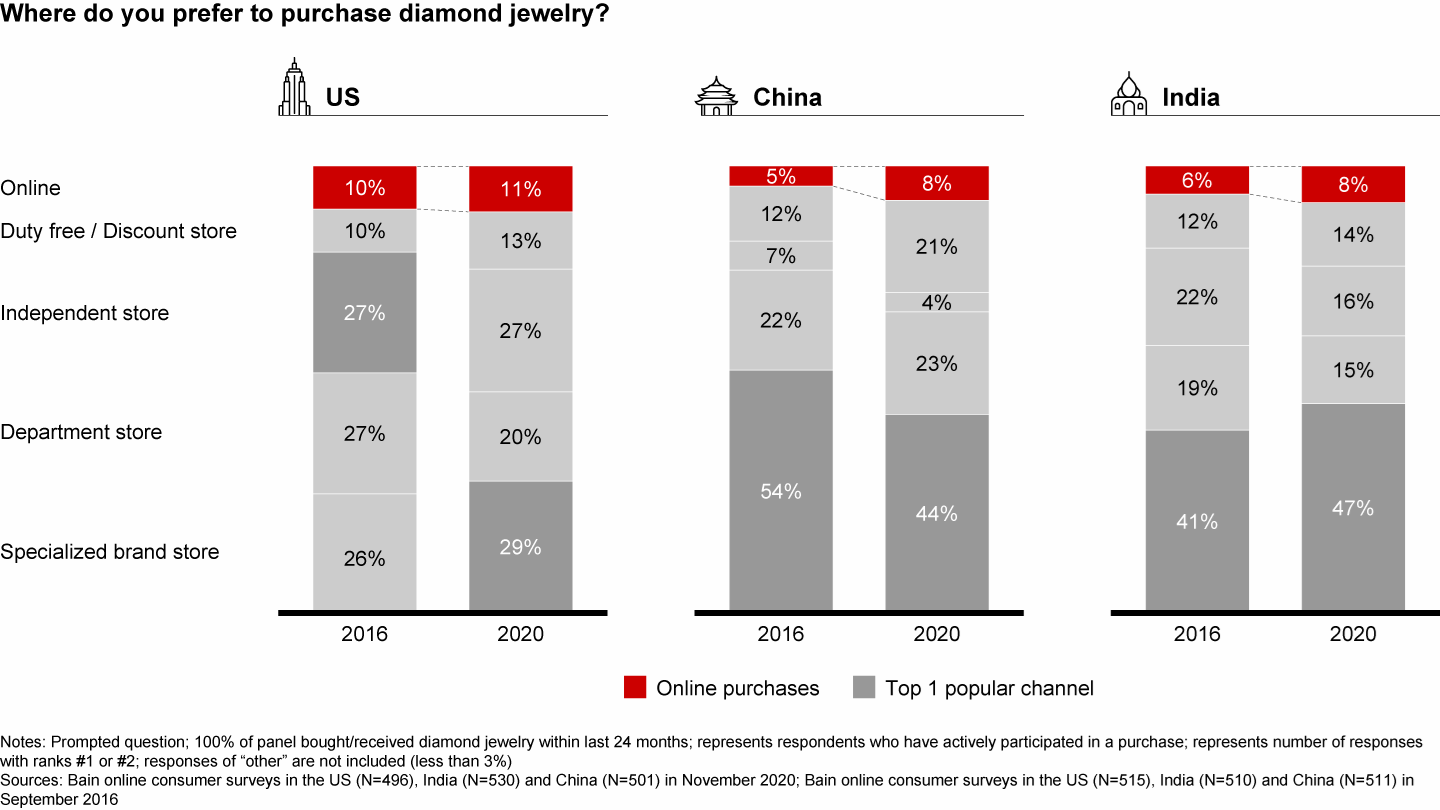
Consumers would buy diamond jewelry online from trustworthy brands that offer additional discounts

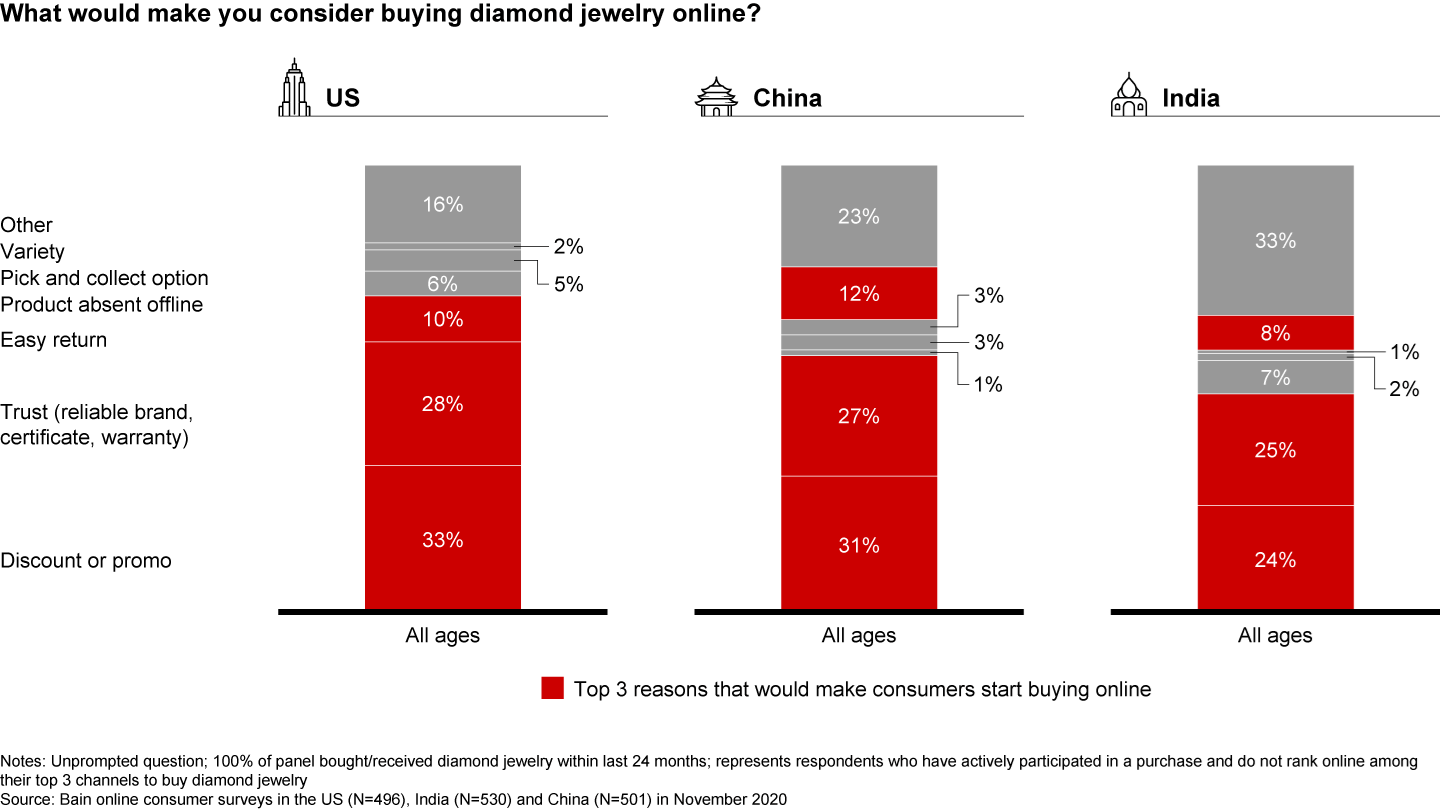
Digital is part of the purchasing experience for more than half of buyers; only 25%–35% of younger consumers make in-store purchases without it

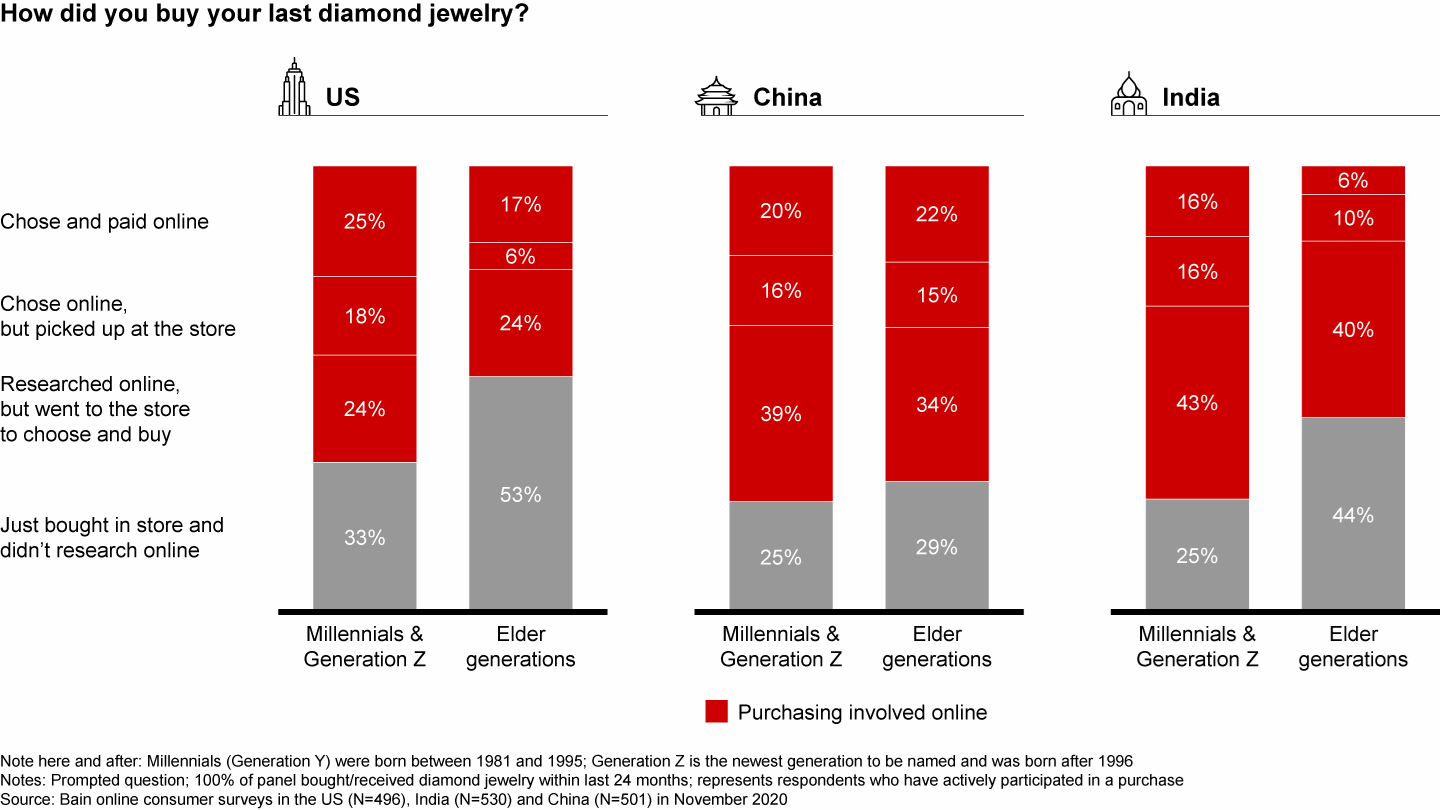
Covid-19 accelerated the convergence of online and offline channels, forcing retailers to retool the customer engagement experience for the new normal

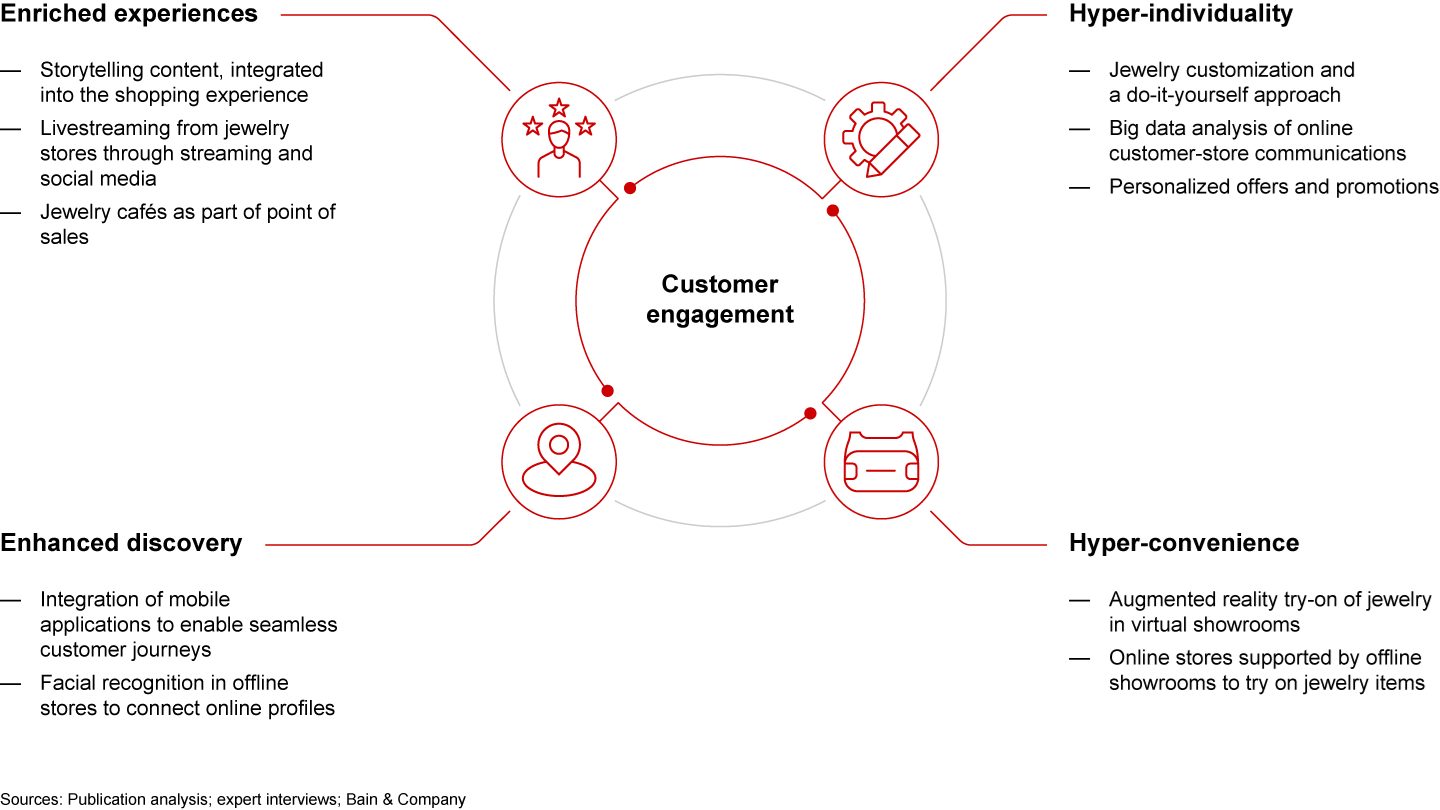
The diamond industry’s sustainability agenda is set by multiple stakeholders: consumers, international organizations, investors and local communities

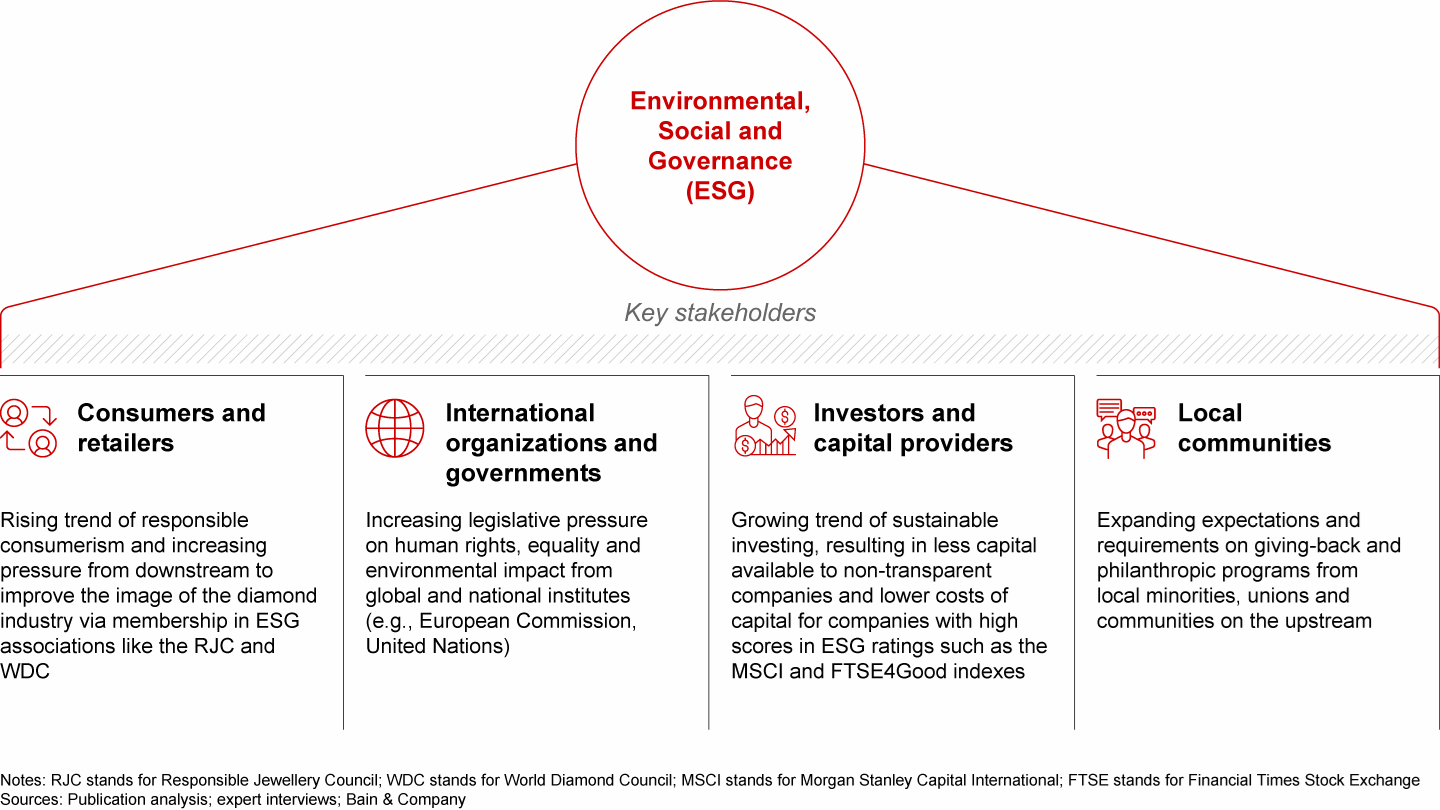
Between 60% and 70% of younger generations consider sustainability when making a purchase decision


When purchasing diamond jewelry, sustainability concerns could be a deal-breaker for consumers

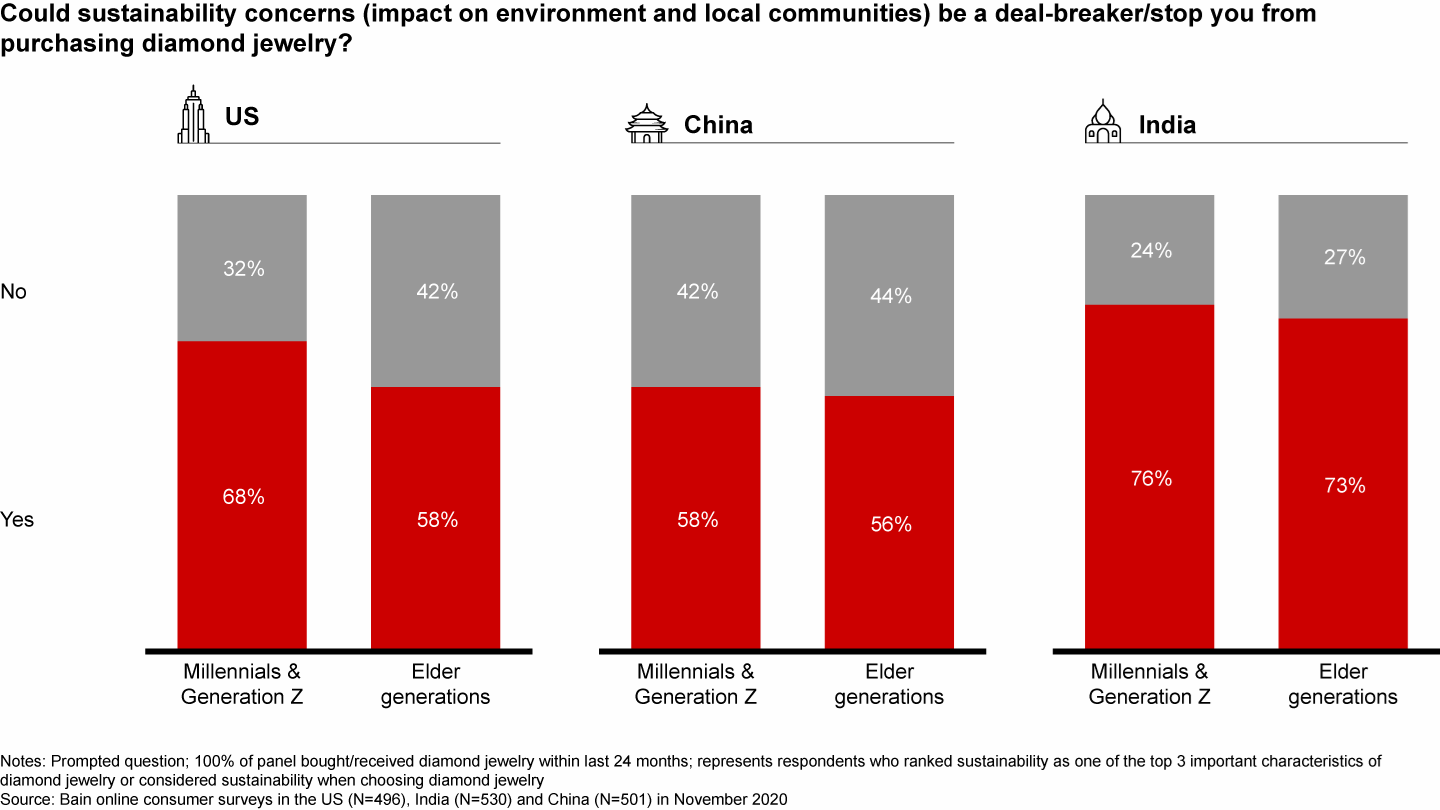
Fair working conditions, conflict-free products, the environment, and carbon footprint are the most important sustainability factors for consumers

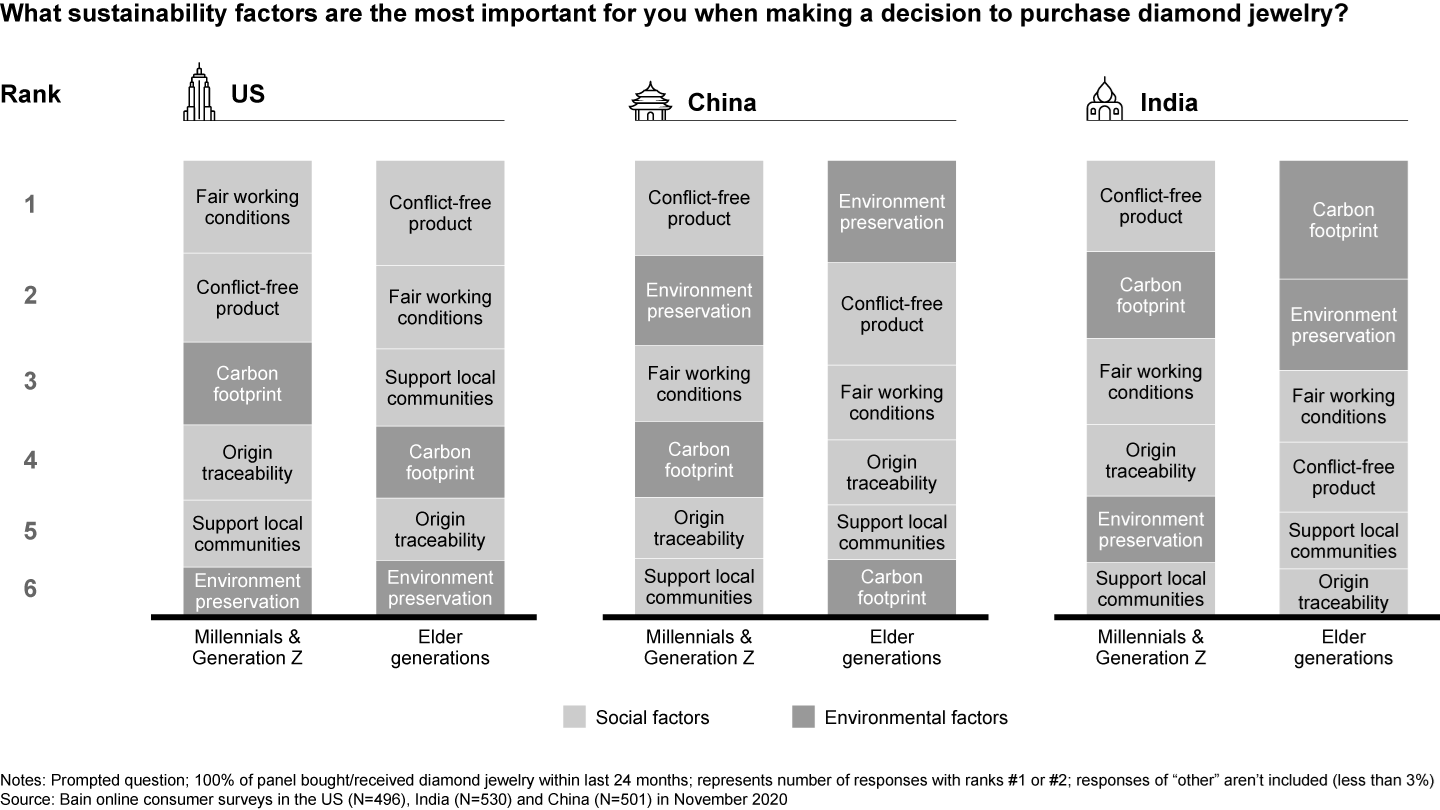
Across the value chain, industry players focused on green energy, sustainable water consumption, and biodiversity

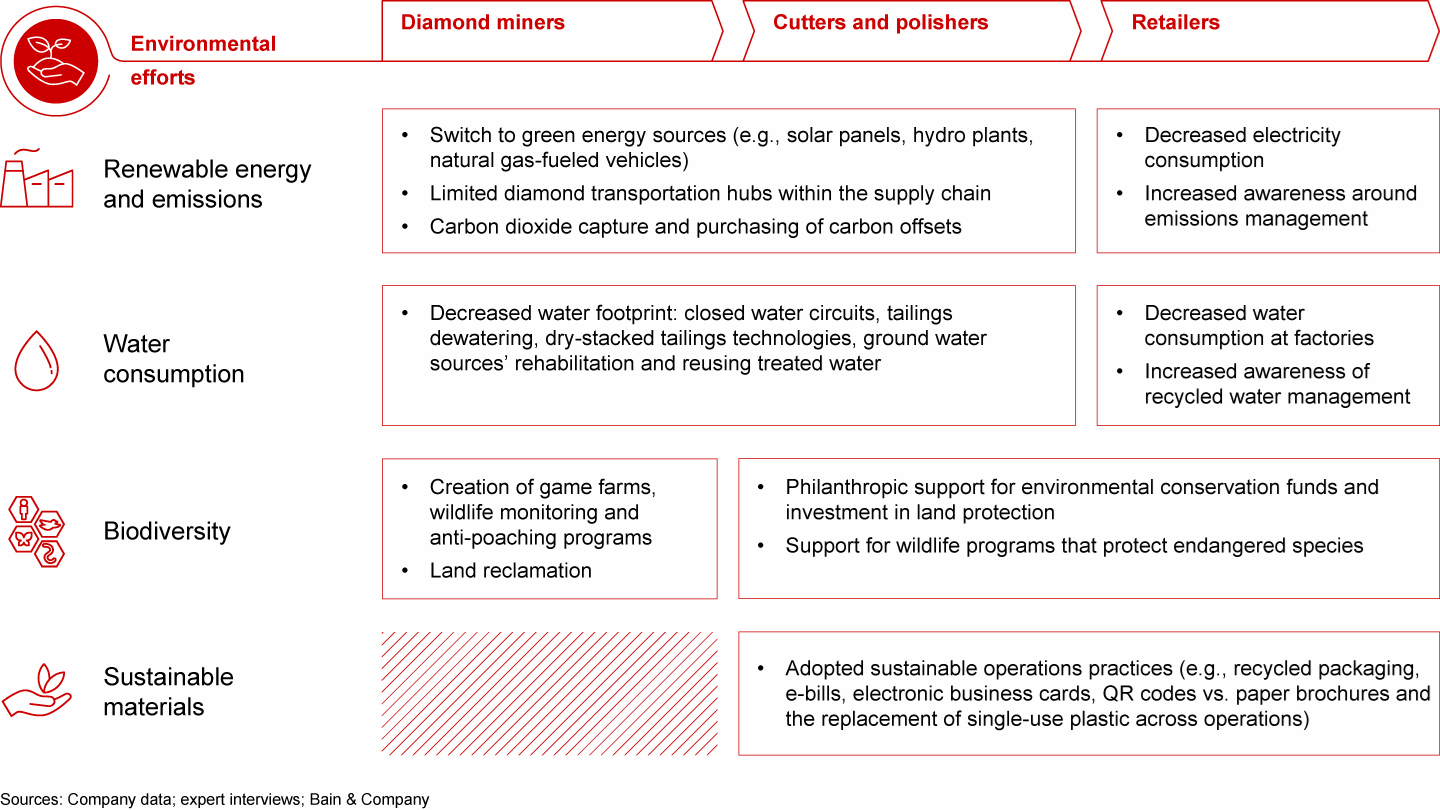
Social efforts are focused on traceability, human rights, and local community support

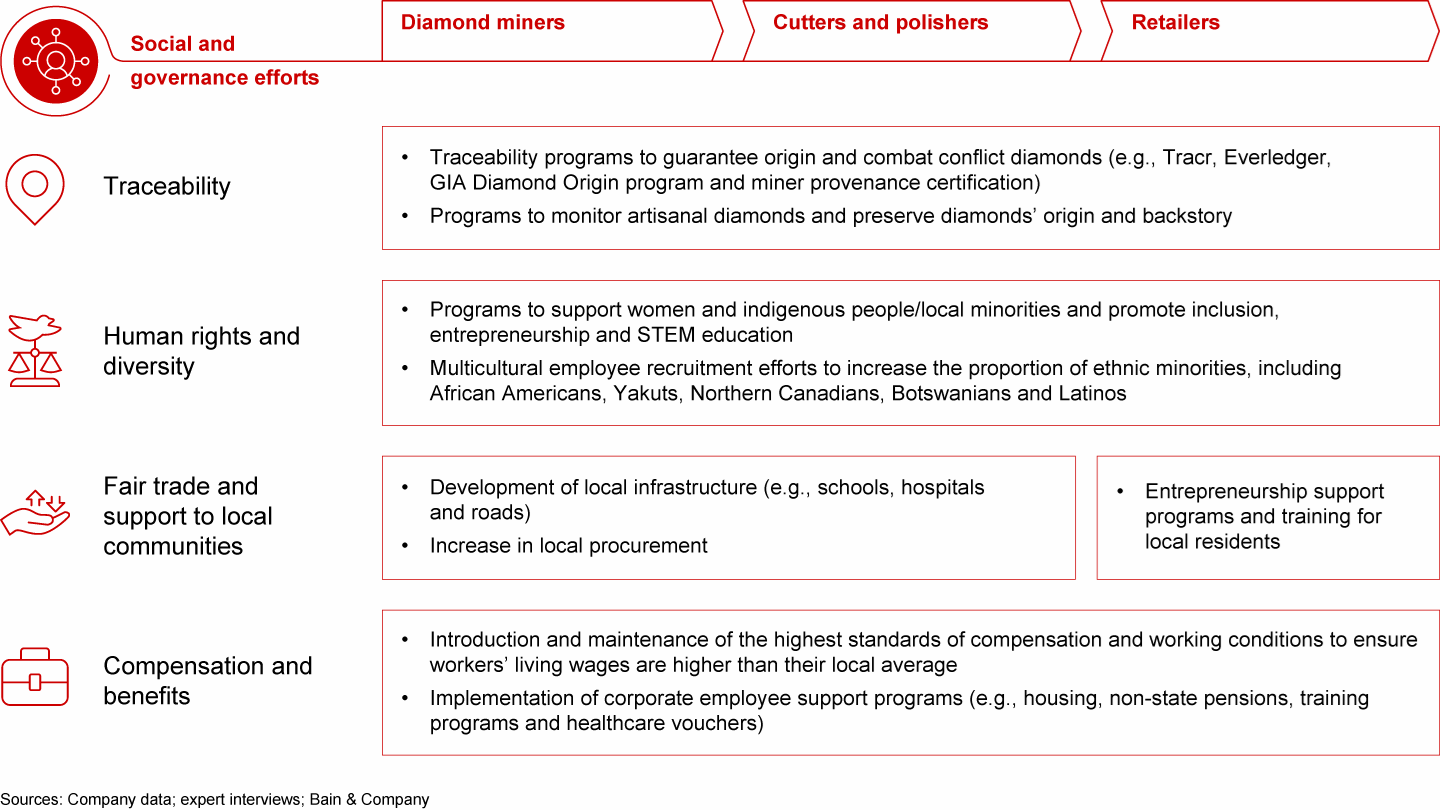
Lab-grown diamond capacity is increasing across the globe; current production is around 6 to 7 million carats

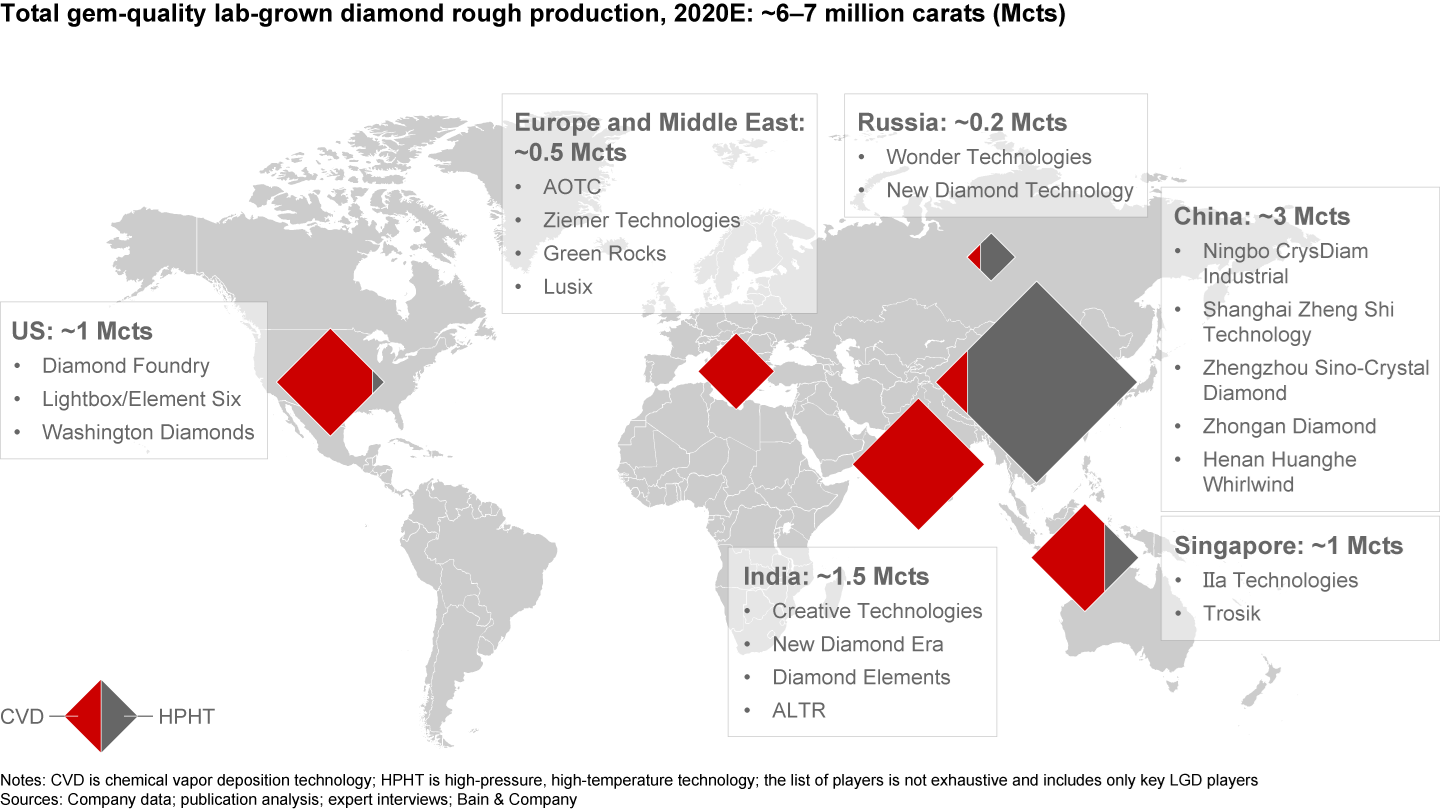
Retail price discounts for lab-grown diamonds vs. natural diamonds have slightly increased in the past year

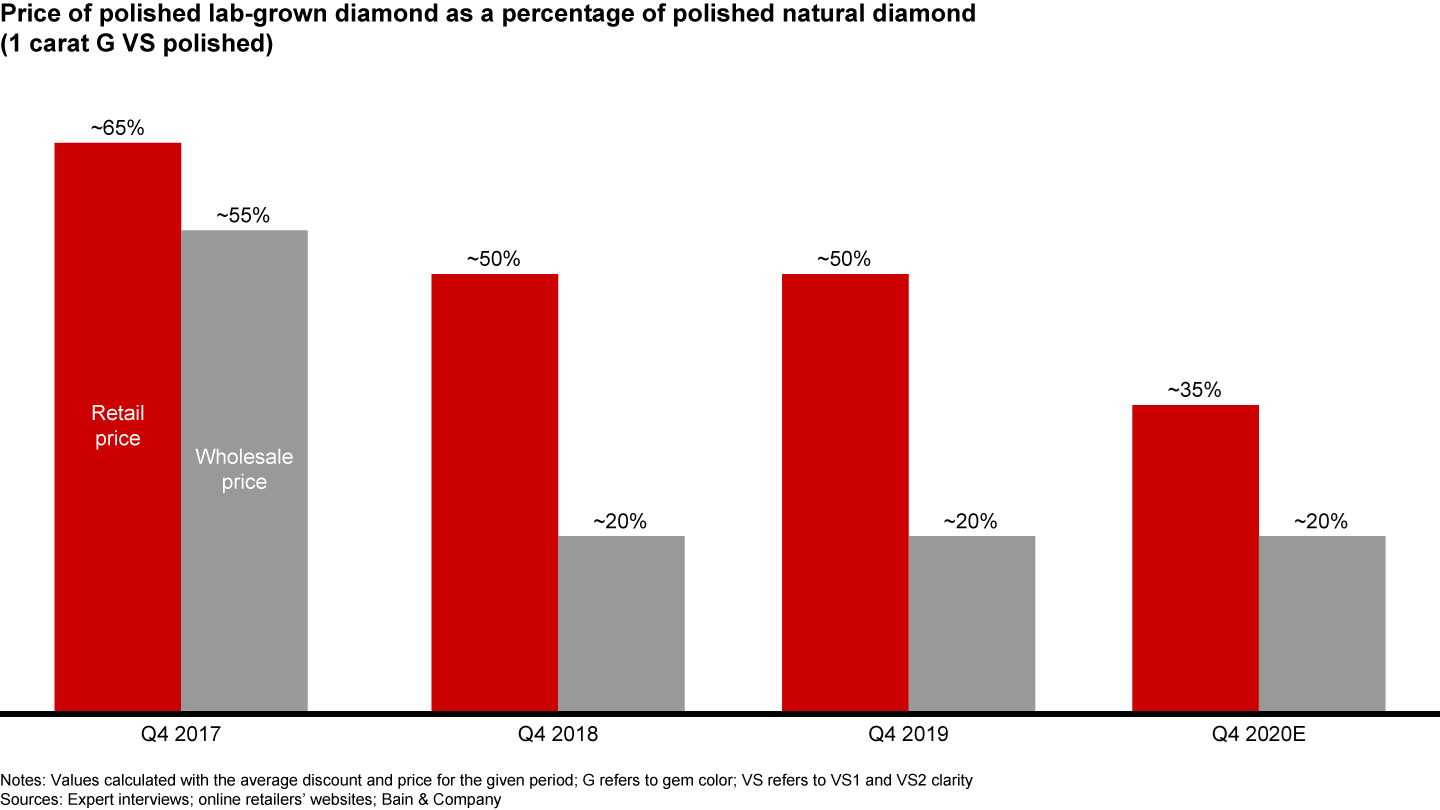
However, lab-grown diamonds still evoke mixed associations; most consumers deem them artificial and affordable

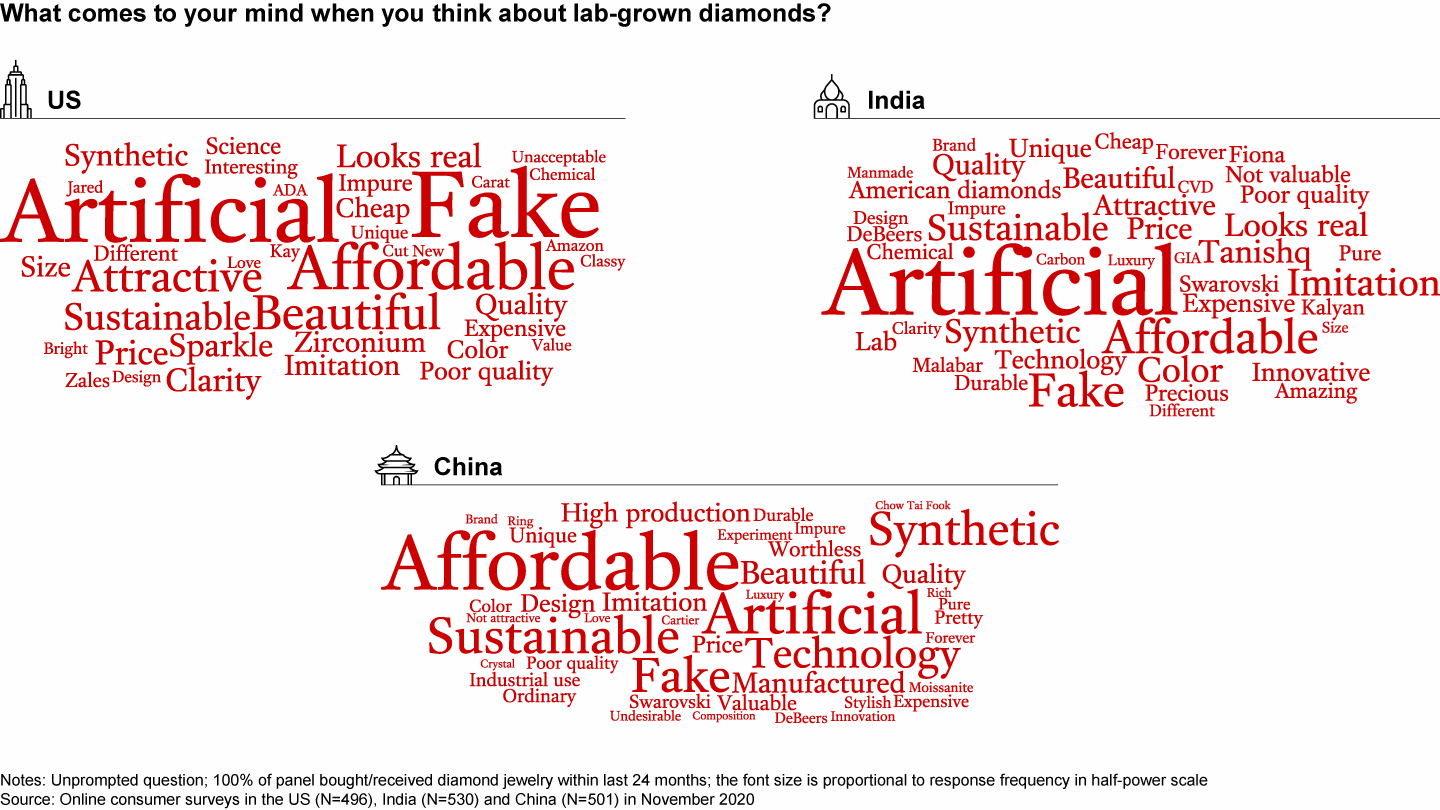
Consumers across key markets do not see substantial differences in sustainability between lab-grown and natural diamonds

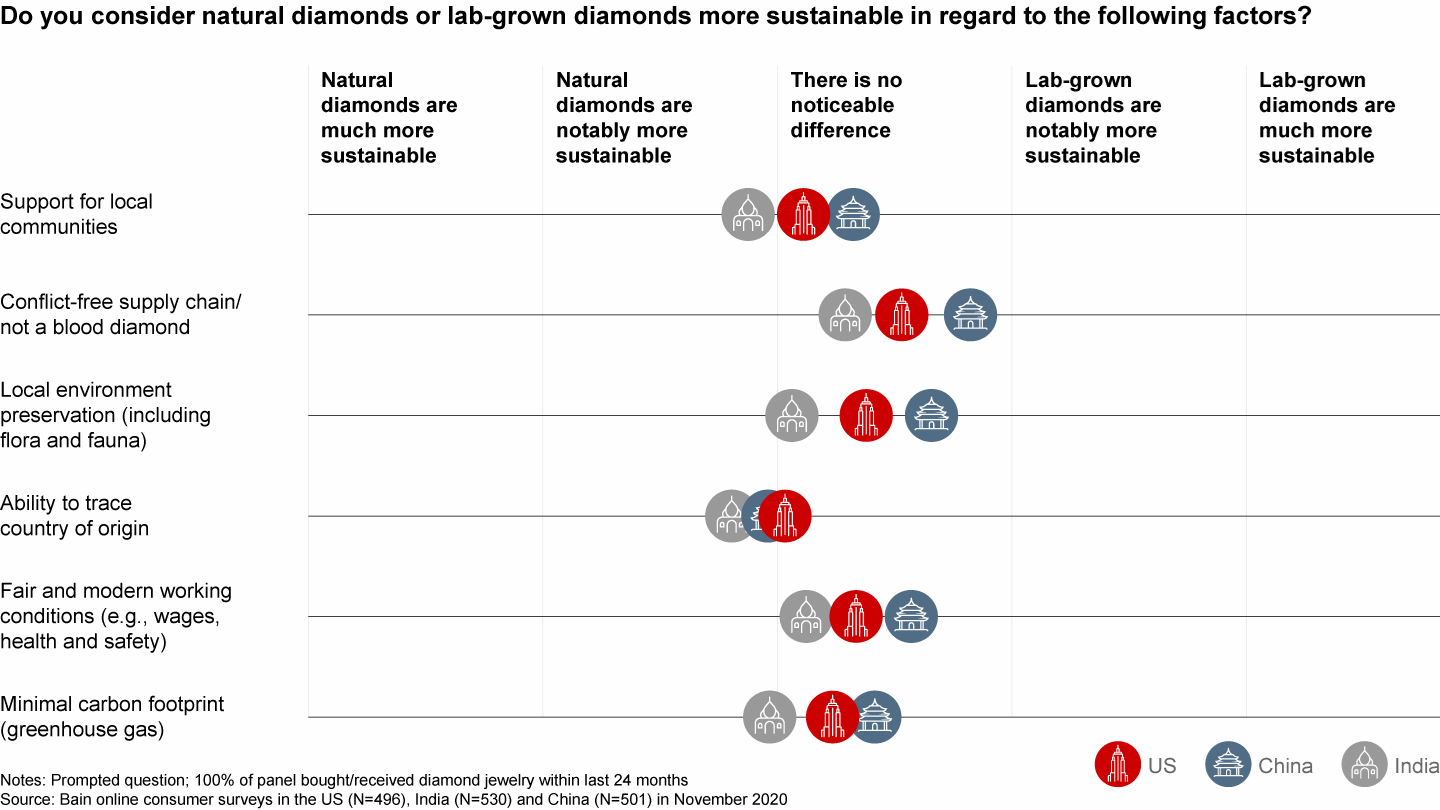
The lab-grown segment is developing rapidly due to technological advancements and rising acceptance across the value chain

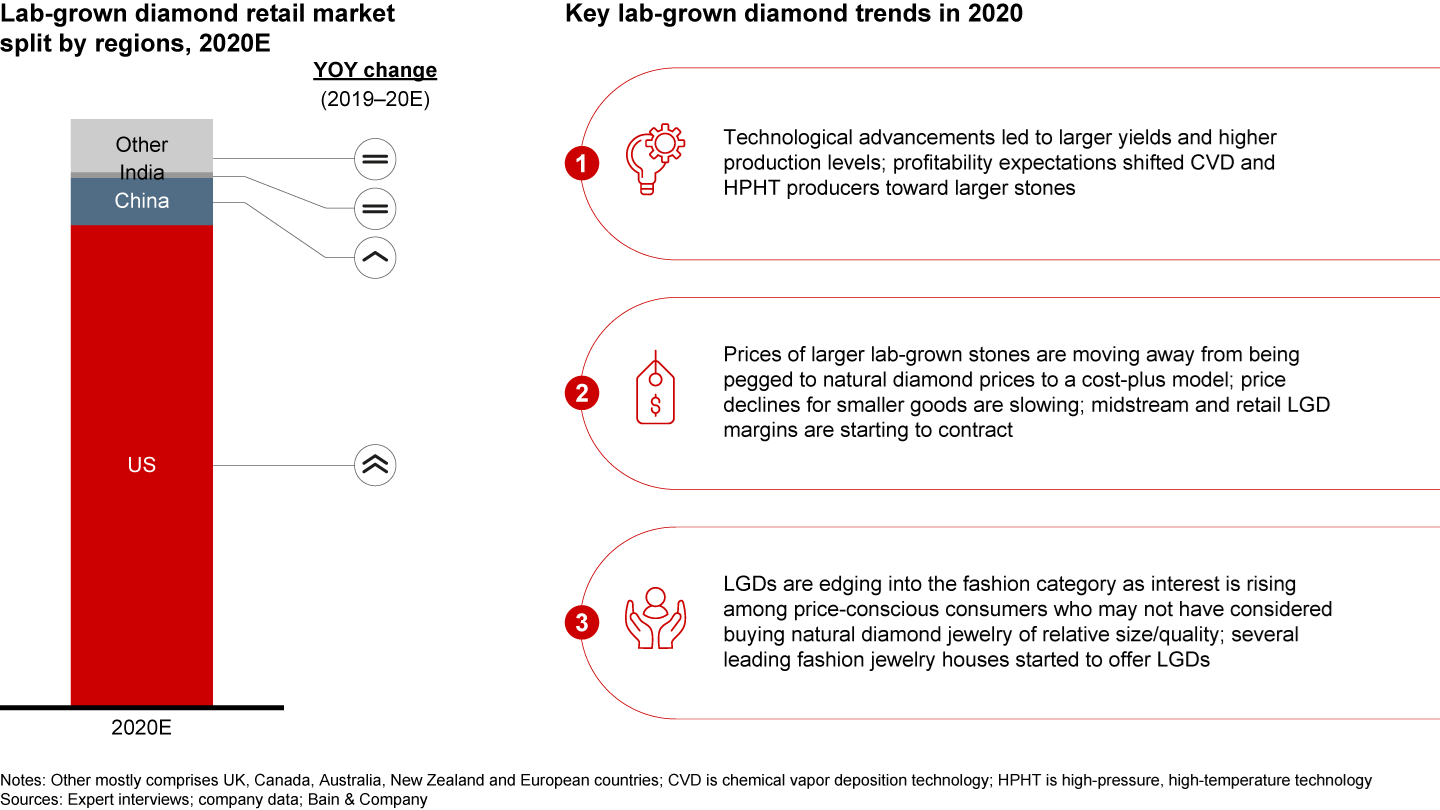
“Diamond engagement ring” searches show stability despite downward-trending marriage rates; however, overall interest in “diamond jewelry” is declining

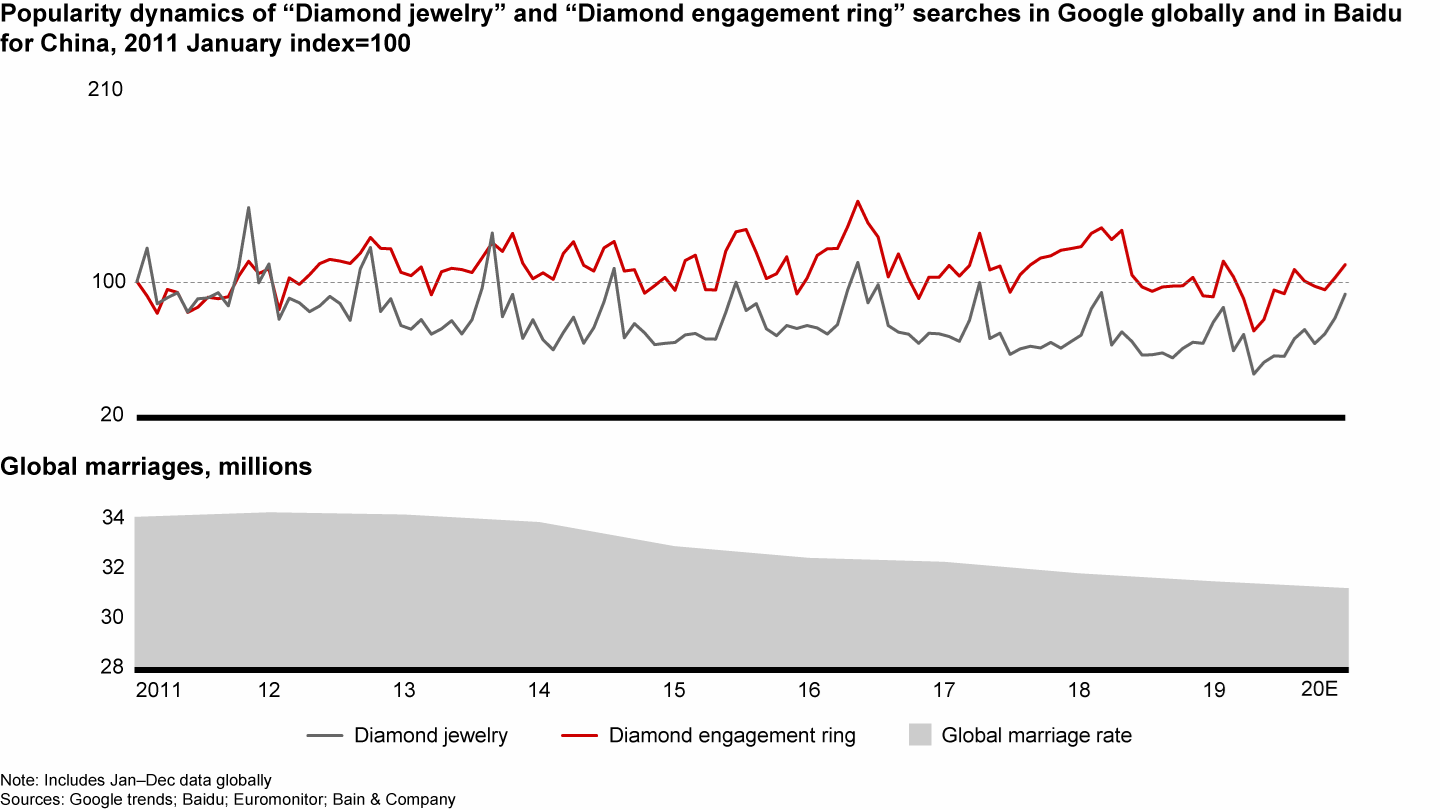
In India and China, jewelry remains one of the most desirable presents

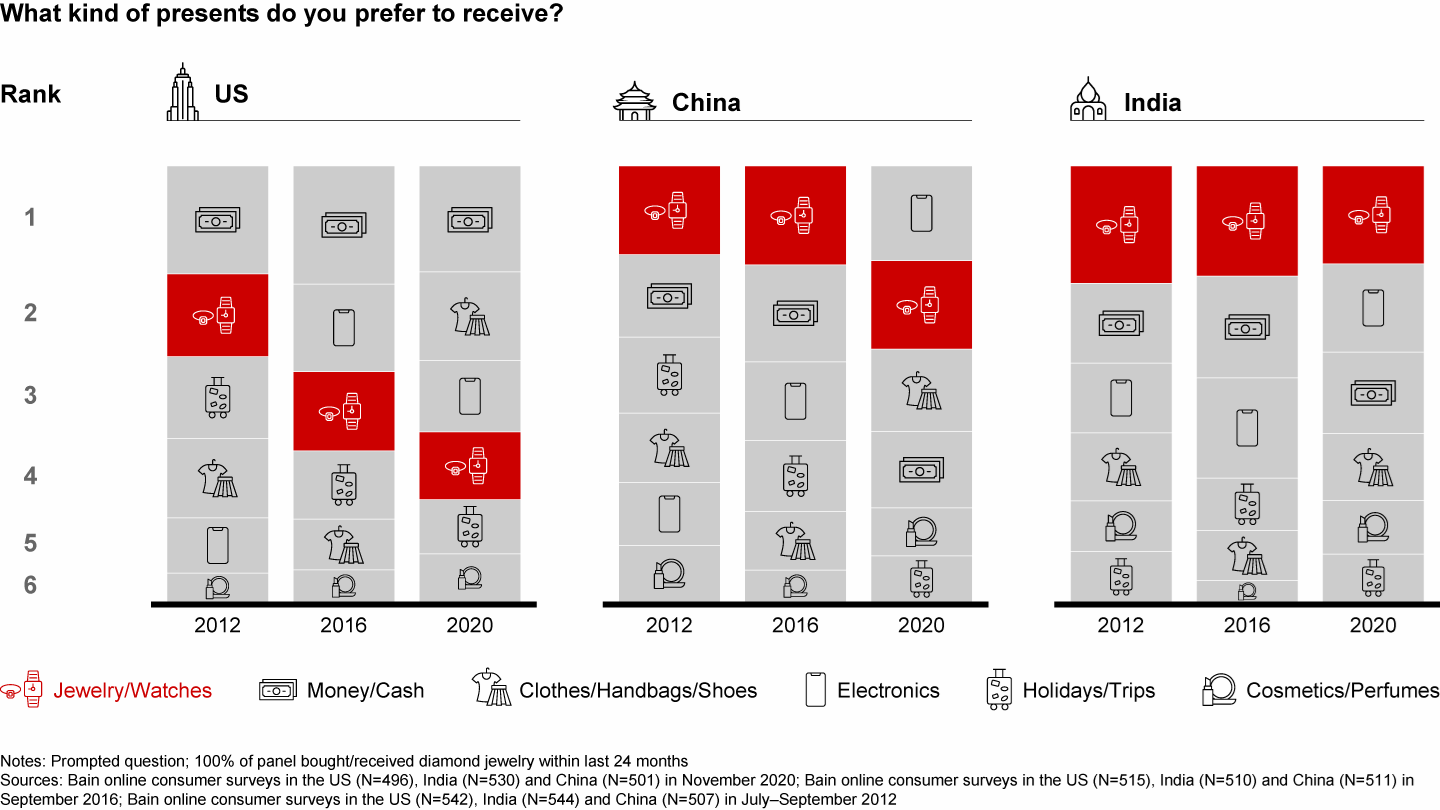
Self-purchase emerged as a top reason to buy diamond jewelry in the US and China

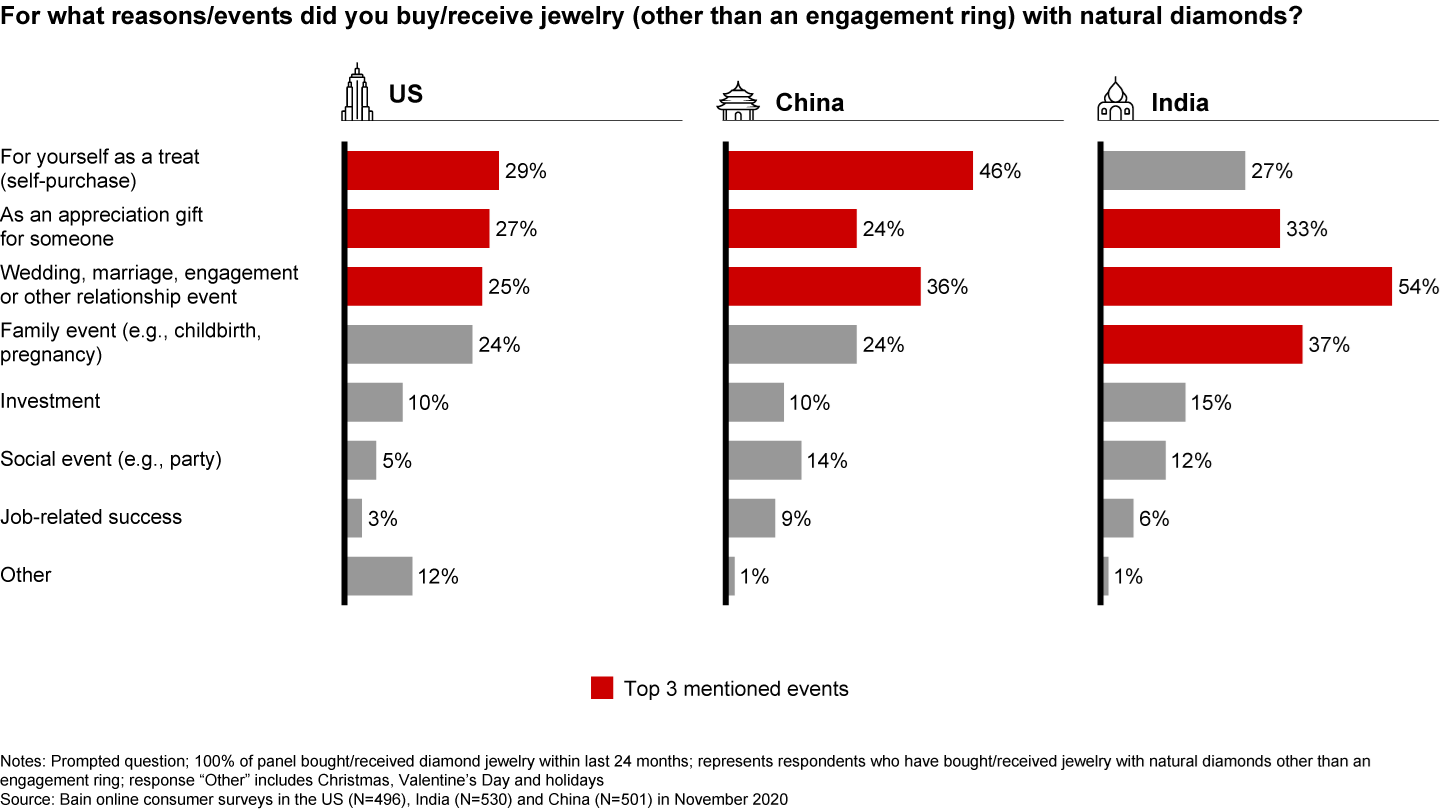
Diamond marketing is becoming more sophisticated as retailers and other players address both traditional and emerging pressures

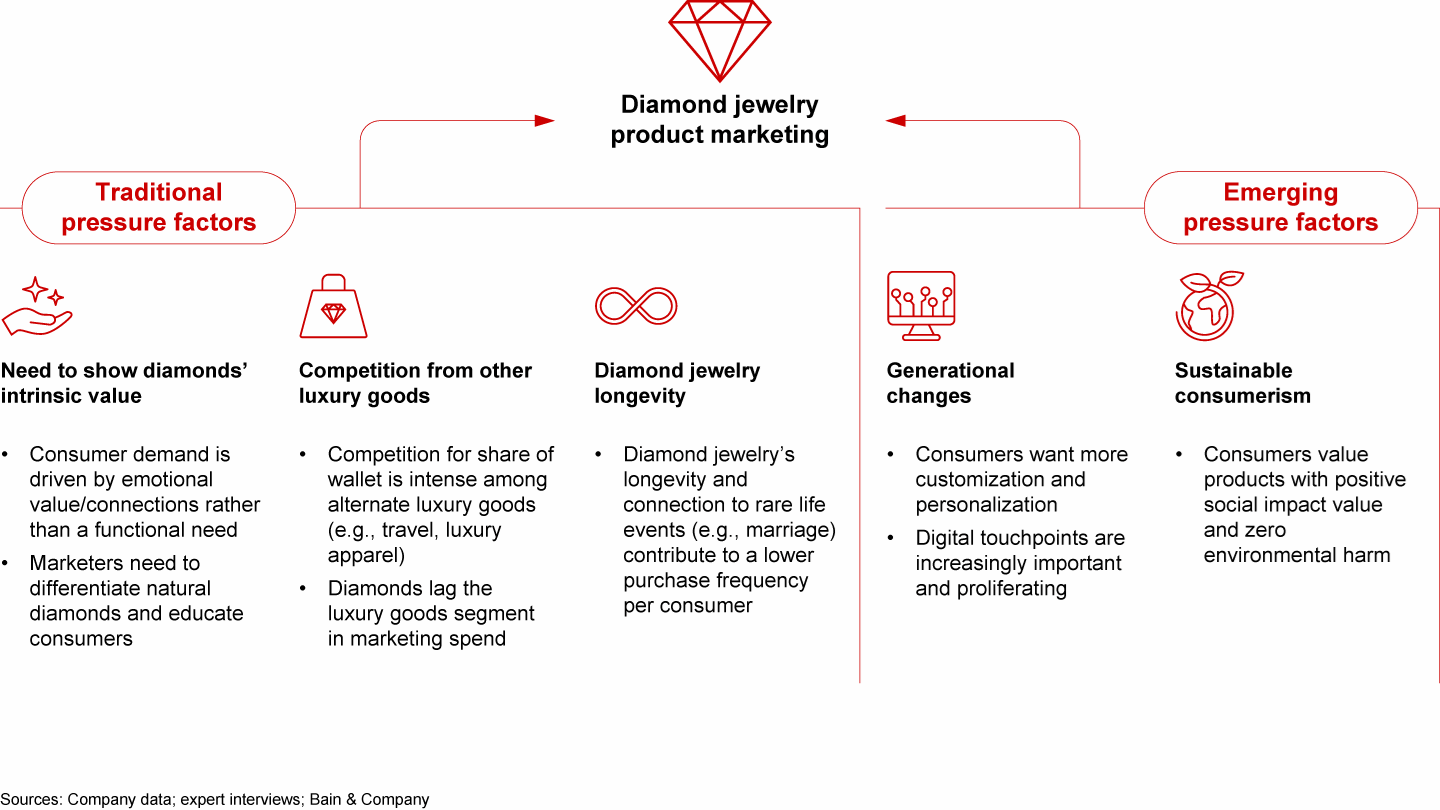
New marketing strategies should focus on intangible values and personalized communications

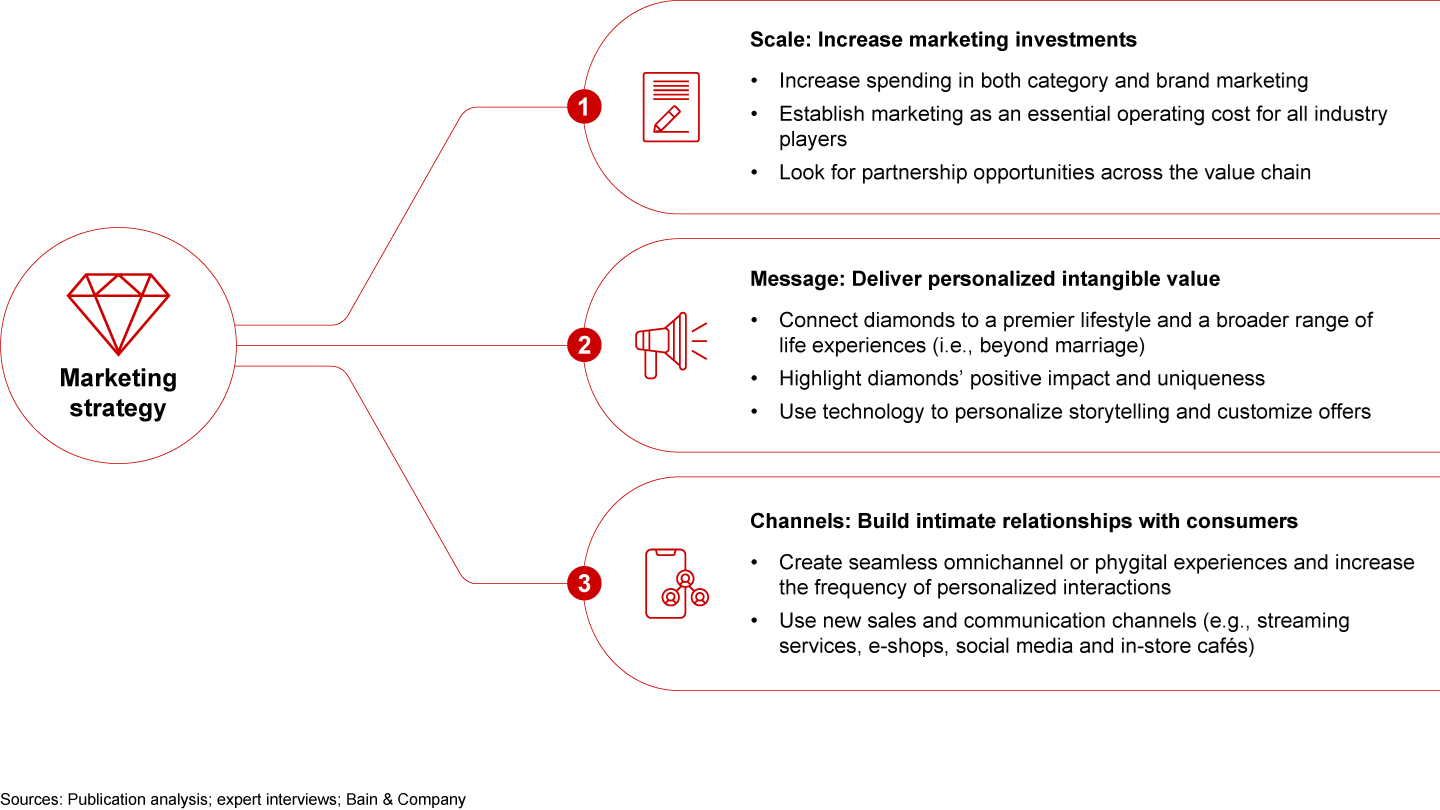
Marketing spending in the diamond industry is around 1%–2% of retail sales and lags marketing efforts in other industries

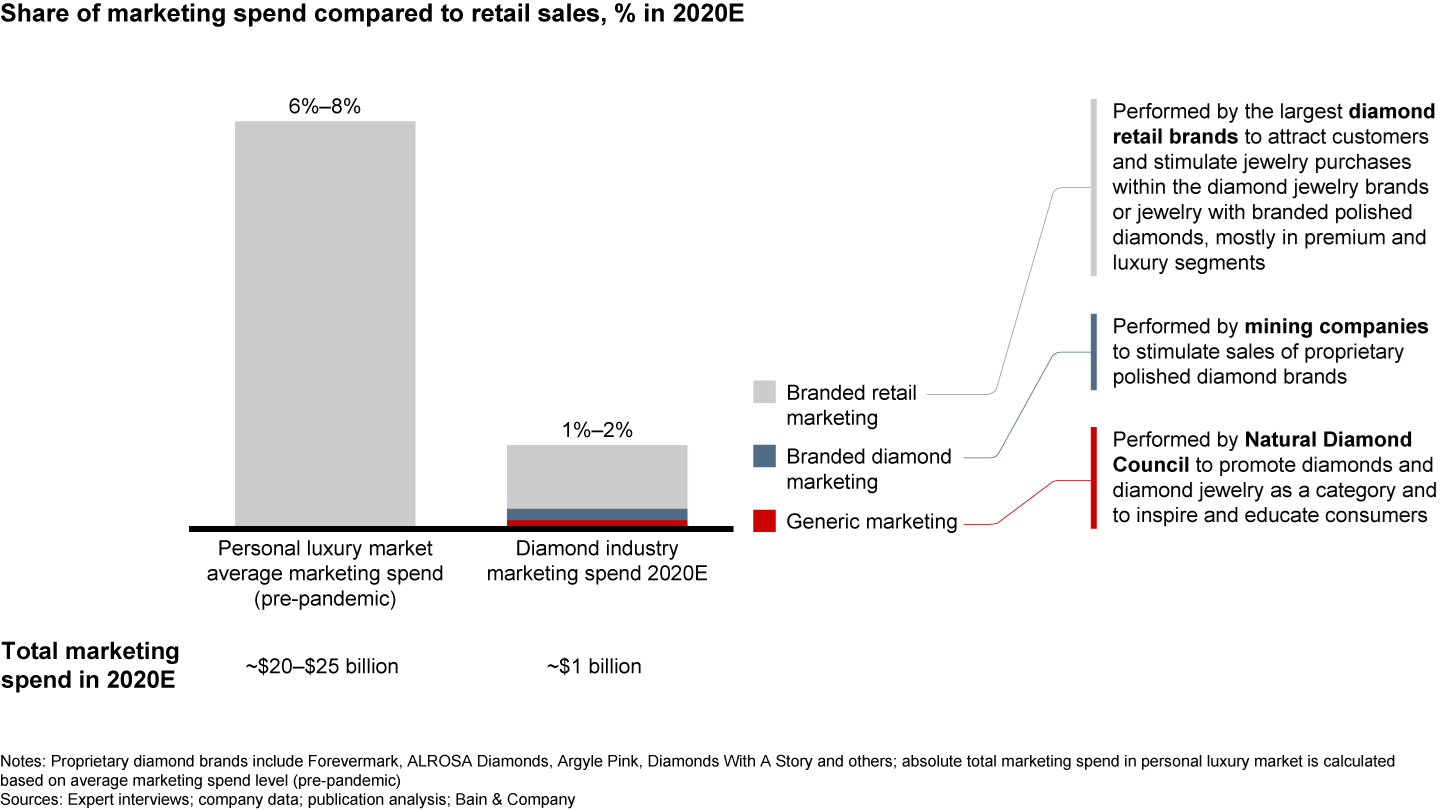
The Natural Diamond Council relaunched generic marketing efforts with new focused campaigns

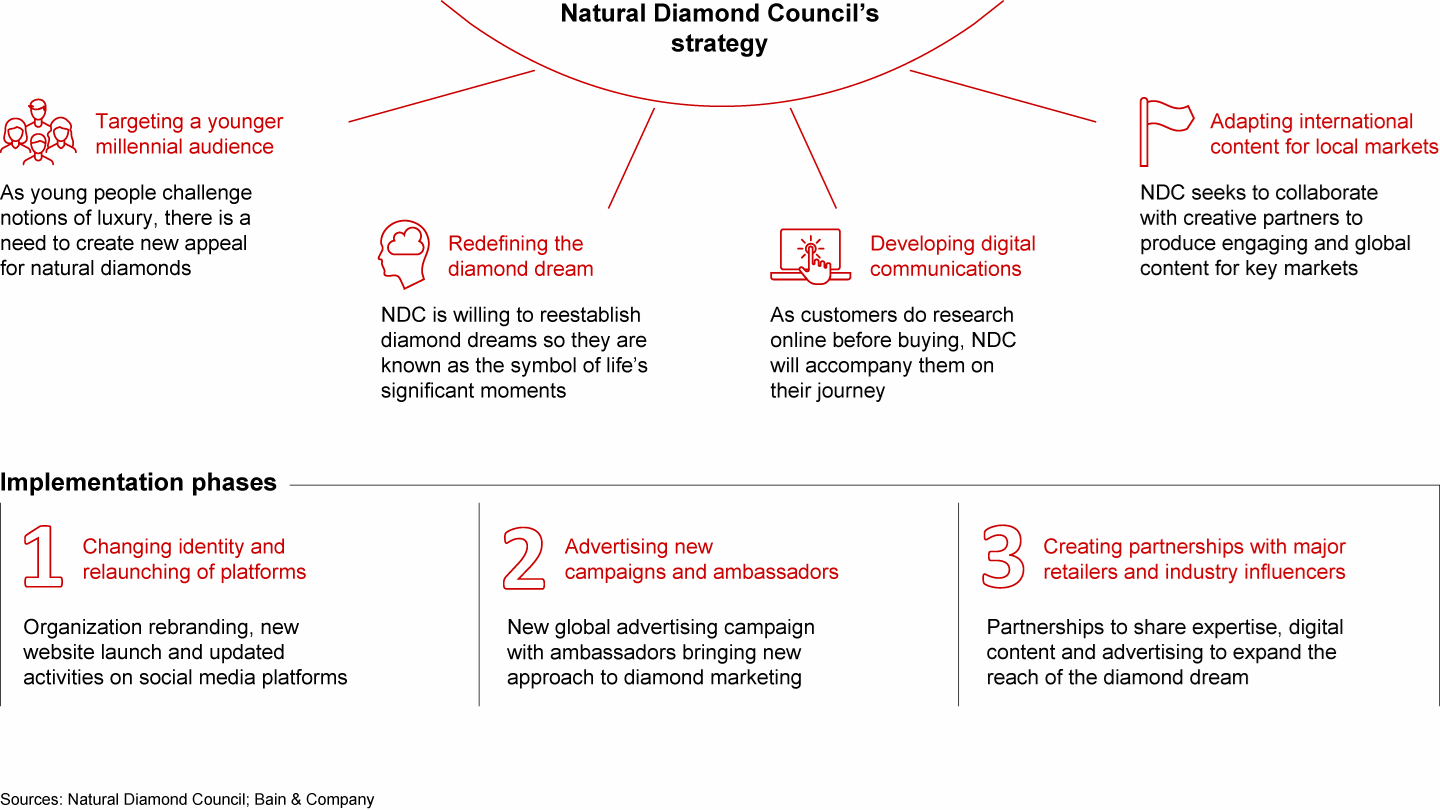
Marketing messages about exclusivity and rarity disproportionally resonate with consumers, while origin and sustainability trends are quite new

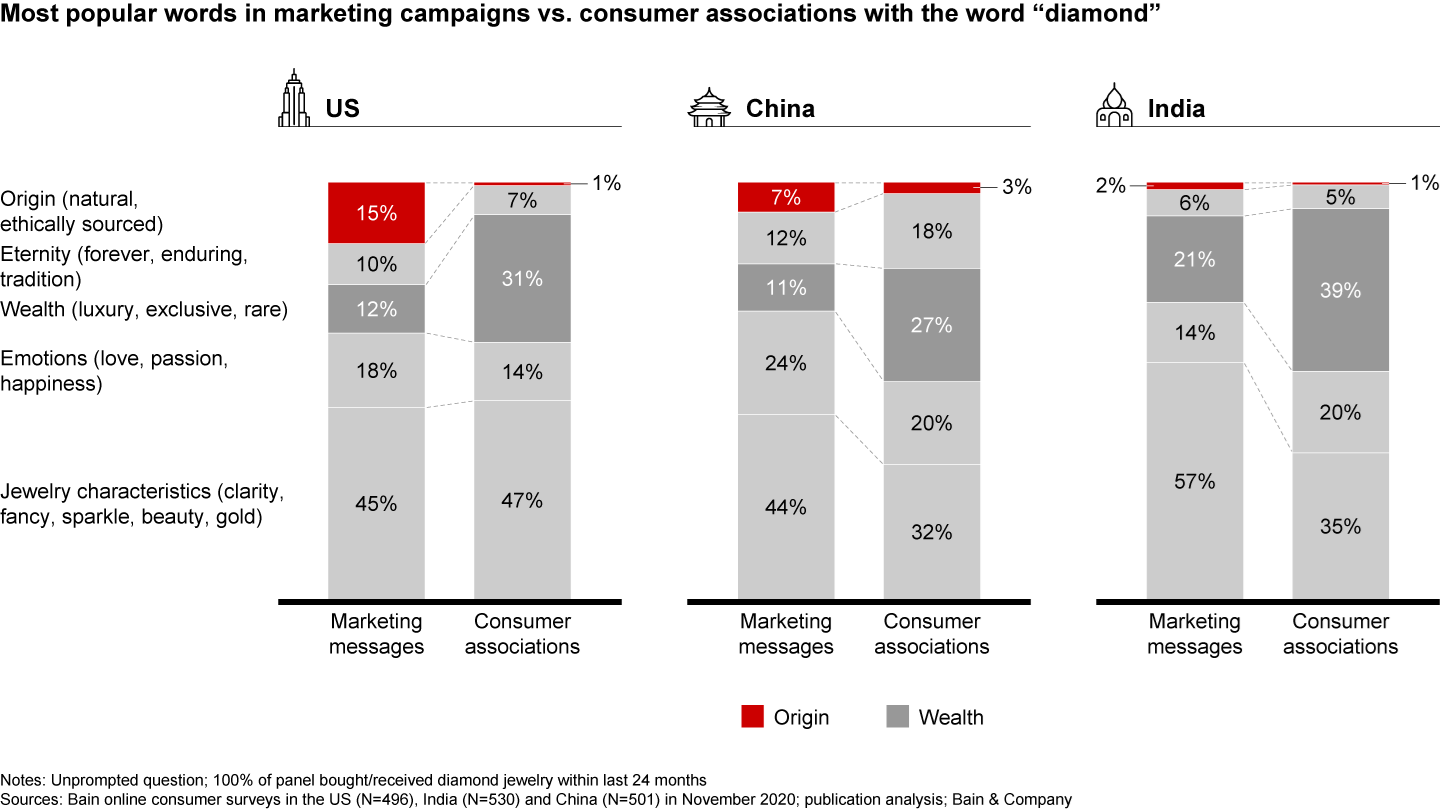
A number of important recent trends will influence the whole value chain’s future

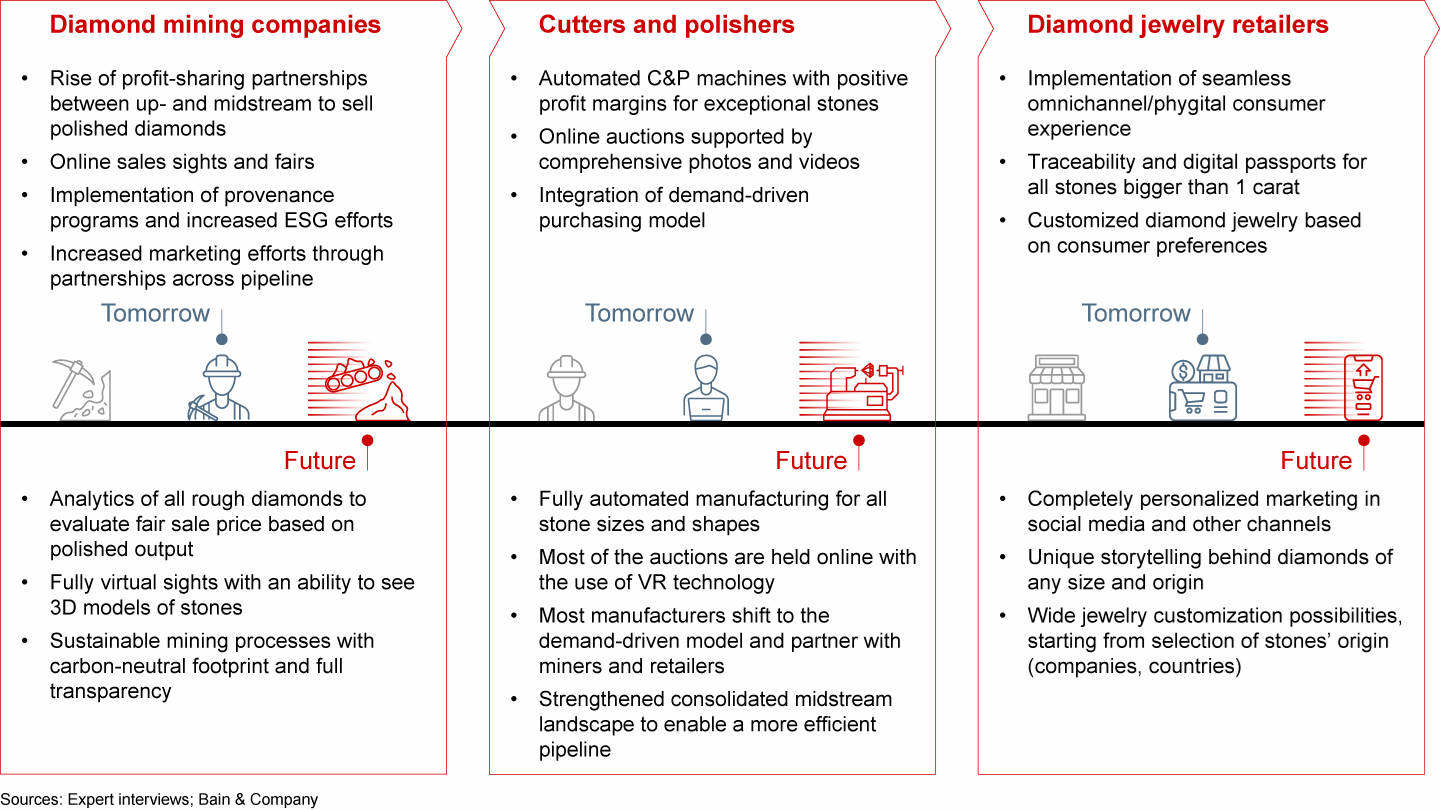

6. Updated supply and demand model
- The Covid-19 recession is likely to be more severe than the 2009 recession. In developed countries, economic recovery to pre-pandemic levels is expected in 2021–23, if Covid-19 vaccines are deployed in 2021 as anticipated. Rough diamond production is projected to recover to the “new normal” in the next two to three years and remain stable from 2023–30. Excess rough diamond stock will gradually enter the pipeline within the next one to two years to ensure smooth supply. Demand for diamond jewelry is expected to recover to pre-pandemic levels in 2022–24. If fundamental factors such as GDP and middle- and high-net-worth class growth are as strong as projected, and there’s sufficient marketing support, then long-term demand is expected to grow at an average annual rate up to 2% to 3% from 2023–30.
- The US is expected to reach pre-pandemic economic levels by 2021 to 2022, ahead of most of other countries, because of increased government spending. GDP growth was positive in China in 2020; economic recovery across all Chinese industries is expected in 2021. India’s recovery will come later, in 2023 to 2024. Recoveries could be affected by new strains of the virus or government policies to stop its spread. Such circumstances could lead to a double-dip recession and another downturn before the economy is revitalized.
- In the long term, the global economy is projected to grow at an annual rate of 3%. The US, China, and India will continue to lead the growth in diamond jewelry purchasing. We expect the US economy and US personal disposable income to grow around 2% annually. In China, diamond jewelry demand will be driven by 4% growth in affluent and high-net-worth individuals and from expanded retail footprints in lower-tier cities. In India, diamond jewelry demand will follow middle-class growth (10% annually) and be reinforced by the country’s affinity for jewelry and the expansion of internationally branded retailers. These factors provide a strong foundation for growth beyond 2023.
- In the lab-grown market, consolidation, production capacity growth in China, and technological advancements are causing unit costs and prices to drop. If that continues, lab-grown diamonds could expand into the wider mass jewelry segment, targeting a different audience than natural diamonds. Alternatively, if the trend of product differentiation reverses, we could see more lab-grown diamonds in the premium jewelry segment, compensating for the decreased supply of natural diamonds.
- This forecast does not consider several factors that could disrupt the supply–demand balance in the short term or slow down the longer-term global trajectory. A number of risks may cause a double-dip recession: the US failing to agree on new stimulus programs; escalating trade wars between the US and China; European debt or currency crises; India’s increased vulnerability to oil prices; or increased taxation to cope with budget deficits. Sustained consumer fears about Covid-19 and new restrictions to stop its spread are additional risks that could impede recovery. Elevated competition from alternative luxury goods is another potential risk. If materialized, these risks could decrease consumer spending on diamond jewelry considerably and lead to longer recovery periods in key markets.
Covid-19 impacted key markets in the short term, but the industry’s long-term macroeconomic and consumption outlooks remain positive

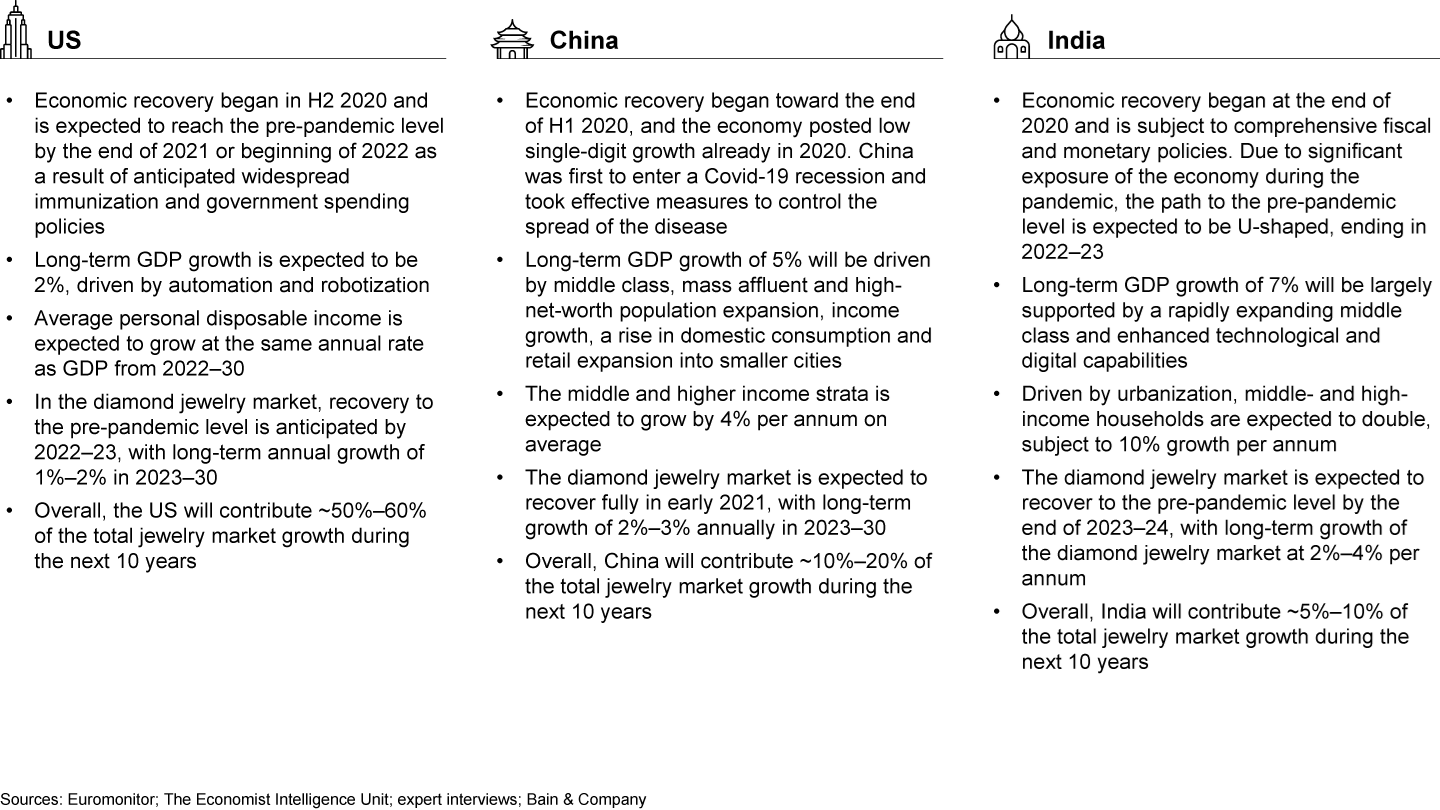
Long-term scenarios for natural rough diamond demand and supply rely on key assumptions

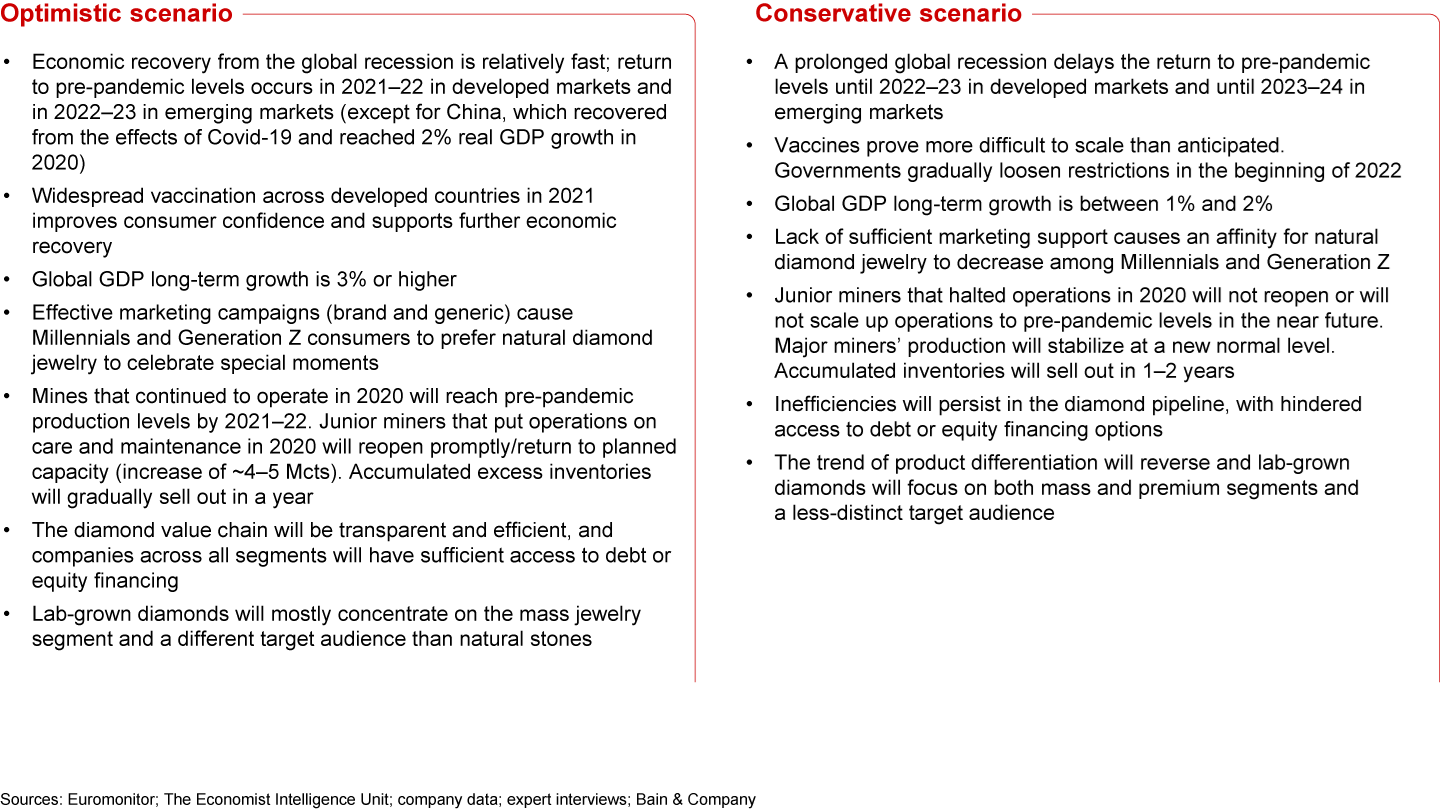
The long-term outlook for real global GDP and PDI is positive; both are expected to grow at 3% per year despite the Covid-19 recession

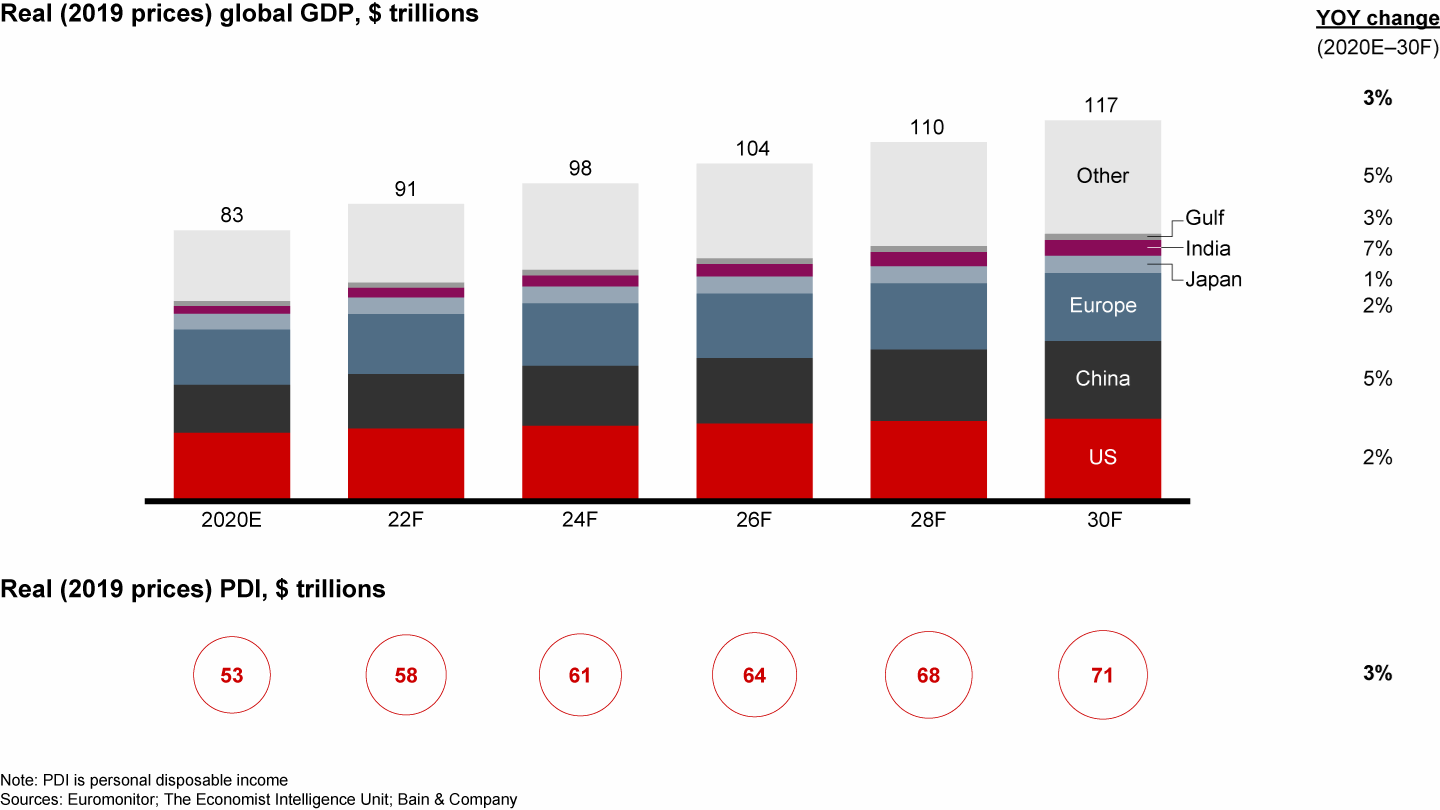
Middle class and high-net-worth household growth in China and India will reinforce positive long-term demand

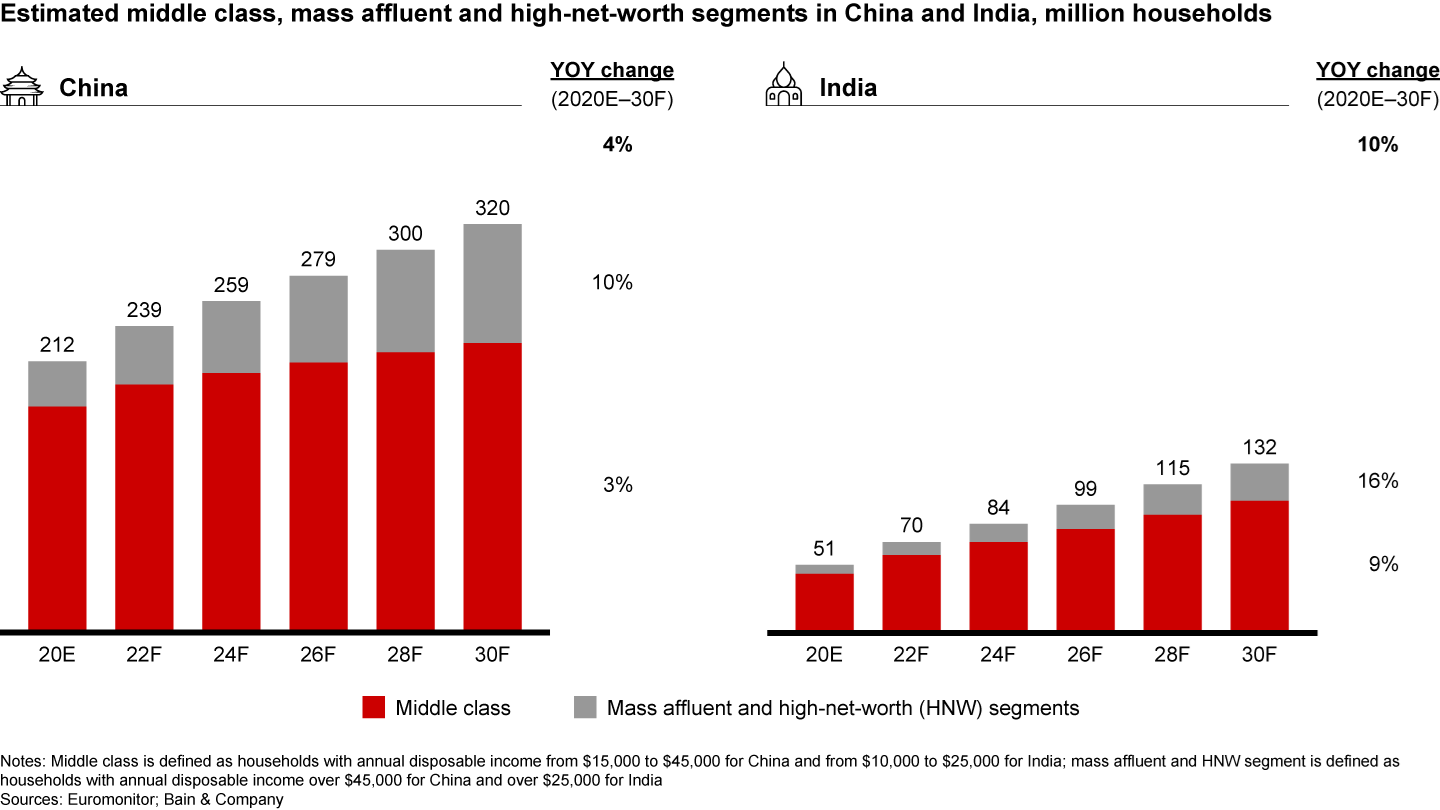
Supply is expected to be almost flat over the next 10 years, with very few new projects coming online

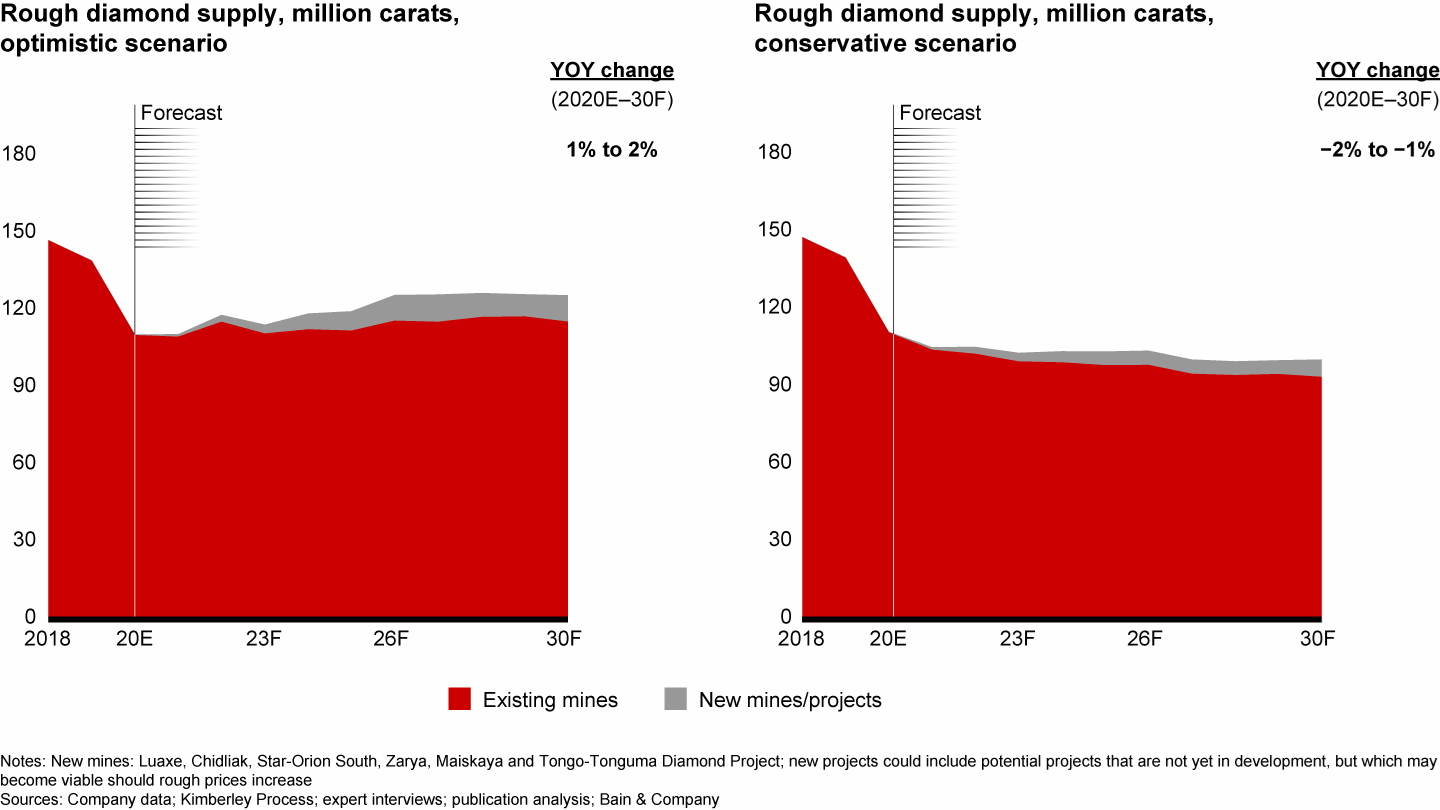
The supply-demand outlook is moderately optimistic

